First Computer MPC13A Notebook Computer with DSSS Data Transceiver User Manual PROPRIETARY NOTICE AND LIABILITY DISCLAIMER
First International Computer Inc Notebook Computer with DSSS Data Transceiver PROPRIETARY NOTICE AND LIABILITY DISCLAIMER
Contents
- 1. User Manual 1of 2
- 2. User Manual 2 of 2
User Manual 1of 2
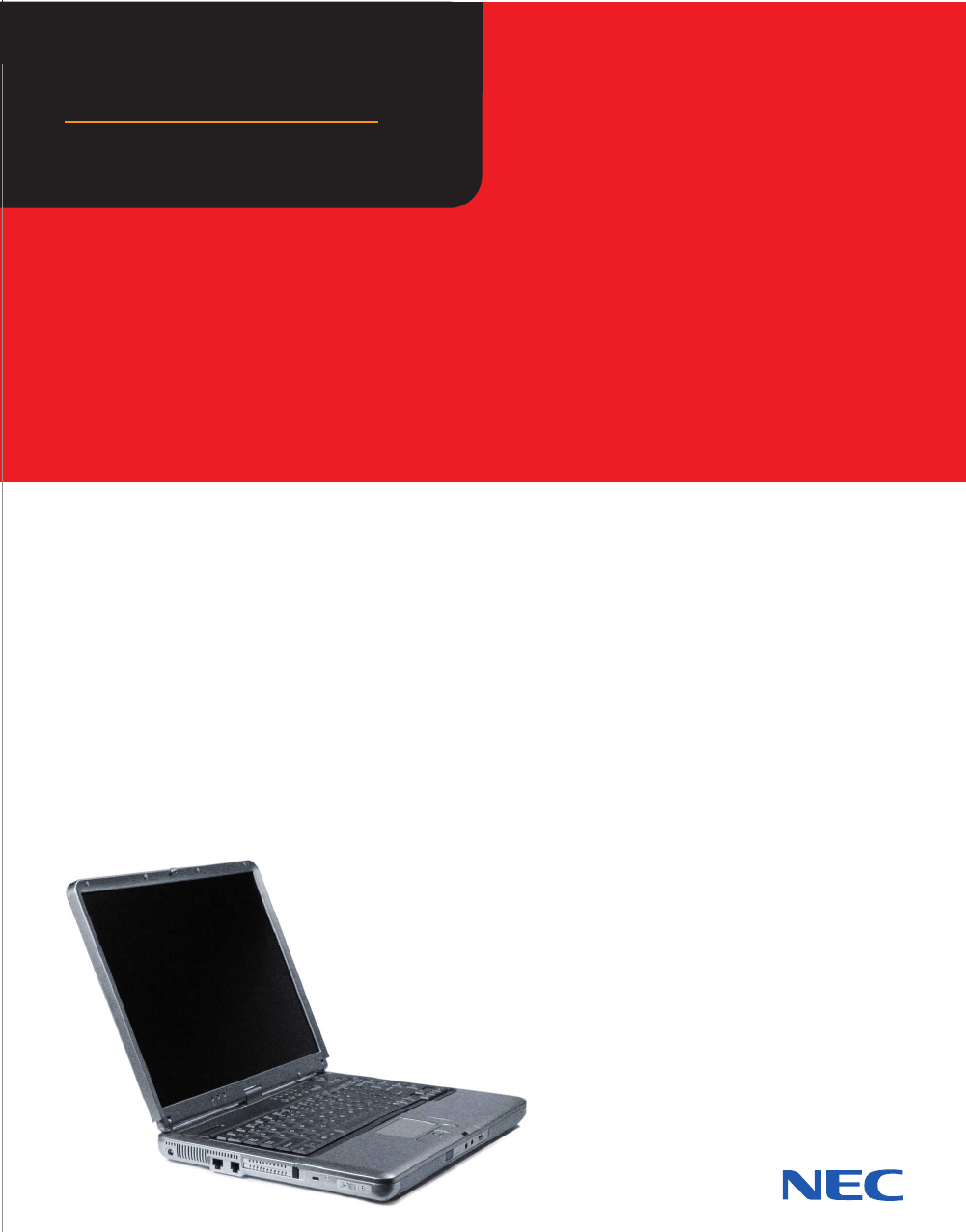
Versa
®
L320
Notebook Computer
V
ersa
®
L320
User’s
Guide
User’s Guide
819-200854-000
08/2001
819-200850-000 8/22/01 2:05 PM Page 1
First Printing — August 2001
Copyright 2001
NEC Computers Inc.
15 Business Park Way
Sacramento, CA 95828
All Rights Reserved
Proprietary Notice and Liability Disclaimer
The information disclosed in this document, including all designs and related
materials, is the valuable property of NEC Computers Inc. (hereinafter “NECC”) and/or its licensors.
NECC and/or its licensors, as appropriate, reserve all patent, copyright and other proprietary rights to
this document, including all design, manufacturing, reproduction, use, and sales rights thereto, except
to the extent said rights are expressly granted to others.
The NECC product(s) discussed in this document are warranted in accordance with the terms of the
Warranty Statement accompanying each product. However, actual performance of each such product
is dependent upon factors such as system configuration, customer data, and operator control. Since
implementation by customers of each product may vary, the suitability of specific product
configurations and applications must be determined by the customer and is not warranted by NECC.
To allow for design and specification improvements, the information in this document is subject to
change at any time, without notice. Reproduction of this document or portions thereof without prior
written approval of NECC is prohibited.
As an ENERGY S
TAR partner, NECC has determined that this product meets the ENERGY star
guidelines for energy efficiency.
NEC is a registered trademark; Versa is a U.S. registered trademark; and PortBar, VersaBay, and
VersaGlide are trademarks of NEC Corporation and/or one or more of its subsidiaries. All are used under
license. ENERGY STAR is a U.S. registered trademark of the U.S. government. Microsoft, Windows, and
Windows NT are registered trademarks of Microsoft Corporation. Intel and Pentium are registered
trademarks and SpeedStep is a trademark of Intel Corporation.
All other product, brand, or trade names used in this publication are the trademarks or registered trademarks
of their respective trademark owners.

Contents iii
Contents
Using This Guide
Text Conventions .................................................................................................................. x
Related Documents ...............................................................................................................x
1 Introducing the NEC Versa
Before You Begin .............................................................................................................. 1-2
About Your NEC Versa L320 Notebook ........................................................................... 1-3
Around the Front of the System ......................................................................................... 1-4
Opening Your System................................................................................................. 1-4
Base Unit..................................................................................................................... 1-4
Control Panel .............................................................................................................. 1-5
Security and Personal Code Buttons.................................................................... 1-6
Power Button ....................................................................................................... 1-6
Shortcut Buttons .................................................................................................. 1-7
Status LEDs ................................................................................................................ 1-7
Power Status LEDs .............................................................................................. 1-8
Operating Status LEDs ........................................................................................ 1-8
Keyboard Panel........................................................................................................... 1-9
Front Features ........................................................................................................... 1-12
Around the Back of the System........................................................................................ 1-13
Around the Left Side of the System................................................................................. 1-14
Around the Right Side of the System............................................................................... 1-15
Around the Bottom of the System.................................................................................... 1-16
About the NEC Cable PortBar ......................................................................................... 1-17
About NEC Wireless LAN............................................................................................... 1-18
2 Getting Started
NEC VersaGlide Touchpad................................................................................................ 2-2
Making VersaGlide Adjustments................................................................................ 2-3
VersaGlide Tips .......................................................................................................... 2-3
Power Sources for Your NEC Versa.................................................................................. 2-3
AC Adapter ........................................................................................................................ 2-4
Connecting the AC Adapter........................................................................................ 2-4
Powering On Your System ......................................................................................... 2-5
System Batteries................................................................................................................. 2-6
Primary Battery........................................................................................................... 2-6
Secondary Battery....................................................................................................... 2-6
CMOS Battery ............................................................................................................ 2-6
Using the Primary Battery.................................................................................................. 2-7
Determining Battery Status......................................................................................... 2-7
Low Battery Status...................................................................................................... 2-8
Returning the Battery to its Normal State ................................................................... 2-8
Extending Battery Life................................................................................................ 2-8

iv Contents
Battery Handling .........................................................................................................2-9
Replacing the Battery..................................................................................................2-9
Charging the Battery .................................................................................................2-11
Battery Precautions ...................................................................................................2-12
Precautions for Recharging the Battery.....................................................................2-12
Using a Secondary Battery ...............................................................................................2-13
Secondary Battery Precautions..................................................................................2-13
Replacing the Secondary Battery ..............................................................................2-13
System Care......................................................................................................................2-14
Precautions for System Use.......................................................................................2-14
Storage Requirements ...............................................................................................2-15
Routine Cleaning.......................................................................................................2-15
3 Using the BIOS Setup Utility
Introducing BIOS Setup .....................................................................................................3-2
Entering BIOS Setup..........................................................................................................3-2
BIOS Setup Main Menu..............................................................................................3-3
Looking at Screens......................................................................................................3-4
Using Keys..................................................................................................................3-5
Checking/Setting System Parameters.................................................................................3-5
Resetting System Parameters ......................................................................................3-6
Main Menu..................................................................................................................3-6
Advanced Menu ..........................................................................................................3-7
Security Menu .............................................................................................................3-9
Password Protection..................................................................................................3-10
Establishing Passwords .............................................................................................3-10
FingerPrint Protection ...............................................................................................3-11
Hard Disk Drive Passwords ......................................................................................3-11
Establishing Hard Disk Drive Passwords...........................................................3-11
Changing Hard Disk Drive Passwords...............................................................3-12
Using Hard Disk Drive Password Protection.....................................................3-12
Moving the Hard Disk Drive..............................................................................3-12
Power Menu ..............................................................................................................3-13
Boot Menu.................................................................................................................3-15
Exit Menu..................................................................................................................3-15
Managing System Power..................................................................................................3-16
Windows 2000 Power Options Properties.................................................................3-16
Windows 2000 Power Schemes .........................................................................3-17
Windows 2000 Alarms.......................................................................................3-18
Windows 2000 Power Meter..............................................................................3-19
Windows 2000 Advanced ..................................................................................3-19
Windows 2000 Hibernate...................................................................................3-19
Windows 2000 and Intel SpeedStep Technology...............................................3-20
Windows 98 SE Power Management Properties.......................................................3-20
Windows 98 SE Power Schemes .......................................................................3-21
Windows 98 SE Alarms.....................................................................................3-22

Contents v
Windows 98 SE Power Meter............................................................................ 3-22
Windows 98 SE Advanced ................................................................................ 3-23
Windows 98 SE Hibernate................................................................................. 3-23
Windows 98 SE and Intel SpeedStep Technology............................................. 3-24
Windows Power Management States........................................................................ 3-24
Recognizing the Windows Power Management States............................................. 3-25
Checking Switch Settings ................................................................................................ 3-26
Accessing Switches................................................................................................... 3-26
Looking at Switch Settings ....................................................................................... 3-27
Updating the BIOS........................................................................................................... 3-28
Obtaining the BIOS Update...................................................................................... 3-28
Preparing the BIOS Update Diskette ........................................................................ 3-29
Performing the BIOS Update.................................................................................... 3-29
4 Using the Operating System and Utilities
Windows Introduction........................................................................................................ 4-2
Windows 2000 ............................................................................................................ 4-2
Desktop Icons ...................................................................................................... 4-2
Taskbar Icons....................................................................................................... 4-3
Windows 98 Second Edition....................................................................................... 4-3
Desktop Icons ...................................................................................................... 4-3
Taskbar Icons....................................................................................................... 4-5
NEC Utilities...................................................................................................................... 4-6
NEC Customize Utility............................................................................................... 4-6
NEC Customize Utility Screen ............................................................................ 4-6
Using the NEC Customize Utility........................................................................ 4-6
PHDISK Utility for Windows 98 SE .......................................................................... 4-7
Preparing Your System for the PHDISK Utility.................................................. 4-7
Running the PHDISK Utility............................................................................... 4-7
Applet for Intel SpeedStep2 Technology ........................................................................... 4-9
SoftDVD Player CD........................................................................................................... 4-9
NEC CD-RW CD............................................................................................................... 4-9
Application and Driver CD .............................................................................................. 4-10
Launching the A&D CD with Windows 2000.......................................................... 4-10
Launching the A&D CD with Windows 98 SE ........................................................ 4-10
Application and Driver CD Dialog Box.................................................................... 4-11
Installing the A&D CD Software.............................................................................. 4-11
Personal Code Setting Utility........................................................................................... 4-11
Identifying Personal Code Setting Buttons ............................................................... 4-12
Establishing Personal Codes ..................................................................................... 4-12
Clearing a Personal Code.......................................................................................... 4-13
Using the Personal Code to Access the System ........................................................ 4-13
Bringing the System Out of a Power Saving Mode .................................................. 4-14
NEC Info Center .............................................................................................................. 4-14
Installing the NEC Info Center ................................................................................. 4-14
Uninstalling the NEC Info Center............................................................................. 4-14

vi Contents
PartitionMagic Special Edition.........................................................................................4-15
Product Recovery CD.......................................................................................................4-16
Guidelines for Using the Product Recovery CD .......................................................4-16
Product Recovery CD Options..................................................................................4-17
Full Disk Drive Restore.............................................................................................4-17
Partition Only Restore...............................................................................................4-19
One-Touch Start Button Settings Utility ..........................................................................4-20
5 Using the System Drives and Bays
NEC Modular Bay Slot ......................................................................................................5-2
NEC VersaBay IV Slot.......................................................................................................5-2
Phoenix BaySwap Utility ...................................................................................................5-3
Installing the Phoenix BaySwap Utility ......................................................................5-3
Using the Phoenix BaySwap Utility............................................................................5-3
Removing a Device from the NEC Modular Bay Slot ................................................5-4
Installing a Device in the NEC Modular Bay Slot ......................................................5-5
Removing a Device from the NEC VersaBay IV Slot ................................................5-5
Installing a Device in the NEC VersaBay IV Slot.......................................................5-6
Variable-Speed CD-ROM Drive ........................................................................................5-7
CD Loading.................................................................................................................5-8
CD Care.......................................................................................................................5-8
Changing the Auto Play Setting ..................................................................................5-9
Variable-Speed CD-RW Drive.........................................................................................5-10
Variable-Speed DVD-ROM Drive ...................................................................................5-10
Combination CD-RW and DVD-ROM Drive ..................................................................5-11
Memory Modules .............................................................................................................5-12
6 Communicating with Your NEC Versa
MDC Modem .....................................................................................................................6-2
Connecting the Modem ...............................................................................................6-2
Mini PCI LAN....................................................................................................................6-3
PC Cards.............................................................................................................................6-3
Type II Cards ..............................................................................................................6-3
Type II Extended Cards...............................................................................................6-3
Type III Cards .............................................................................................................6-3
Communication Cards.................................................................................................6-4
Storage Cards ..............................................................................................................6-4
Interface Cards ............................................................................................................6-4
Other Cards .................................................................................................................6-5
PC Card Slots ..............................................................................................................6-5
Inserting a PC Card .....................................................................................................6-5
Removing a Card.........................................................................................................6-6
Internet Connections...........................................................................................................6-7
Internet Connection Wizard in Windows 98/2000......................................................6-7
Accessing the Internet .................................................................................................6-7

Contents vii
Sending and Receiving E-mail.................................................................................... 6-8
Modifying the Internet and E-mail Shortcut Buttons.................................................. 6-8
IR Port................................................................................................................................ 6-8
Enabling the IR Port ................................................................................................... 6-9
Enabling Infrared Communications ............................................................................ 6-9
Using the IR Port ...................................................................................................... 6-10
Mini PCI Wireless LAN................................................................................................... 6-11
Enabling Wireless LAN in BIOS Setup.................................................................... 6-11
Checking Your Wireless Connection........................................................................ 6-11
Viewing/Changing Configuration Settings ............................................................... 6-12
7 Traveling Tips
Preparing for Travel........................................................................................................... 7-2
Packing for Travel..............................................................................................................7-2
Using Power Connections.................................................................................................. 7-3
Getting Through Customs.................................................................................................. 7-3
Connecting to the Internet.................................................................................................. 7-4
Connecting Using a Modem ....................................................................................... 7-4
Connecting Using a LAN............................................................................................ 7-4
8 Using External Devices
Keyboard/Mouse................................................................................................................ 8-2
USB Device ....................................................................................................................... 8-3
Serial Devices .................................................................................................................... 8-4
NEC Cable PortBar............................................................................................................ 8-5
Monitor .............................................................................................................................. 8-6
S-Video Supported Device................................................................................................. 8-7
IEEE 1394 Devices ............................................................................................................ 8-8
Parallel Devices.................................................................................................................. 8-9
Audio Options.................................................................................................................. 8-10
9 Using Multimedia
Audio ................................................................................................................................. 9-2
Recording.................................................................................................................... 9-2
CD-ROM/DVD-ROM Input....................................................................................... 9-3
Microphone................................................................................................................. 9-3
Playing Back............................................................................................................... 9-3
Using Headphones ...................................................................................................... 9-4
Using the Built-In Speakers ........................................................................................ 9-4
Using External Stereo Speakers.................................................................................. 9-4
Video.................................................................................................................................. 9-4
Using Digital Video Files ........................................................................................... 9-5
Using Animation Files ................................................................................................ 9-5
Multimedia Applications.................................................................................................... 9-5

viii Contents
10 Solving System Problems
Problem Checklist ............................................................................................................10-2
Startup Problems ..............................................................................................................10-3
POST Error Messages ...............................................................................................10-4
If You Need Assistance....................................................................................................10-5
11 Getting Service and Support
Service and Support Contact Information ........................................................................11-2
Web Site ...........................................................................................................................11-3
Support Services...............................................................................................................11-4
E-mail to Support Services...............................................................................................11-4
A Setting Up a Healthy Work Environment
Making Your Computer Work for You.............................................................................A-2
Arrange Your Equipment ..................................................................................................A-3
Adjust Your Chair ............................................................................................................. A-3
Adjust Your Input Devices................................................................................................A-4
Adjust Your Screen or Monitor......................................................................................... A-4
Vary Your Workday.......................................................................................................... A-5
Pre-existing Conditions and Psychosocial Factors............................................................ A-5
B Specifications
System Components.......................................................................................................... B-2
Interrupt Controllers........................................................................................................ B-10
Memory Map................................................................................................................... B-11
C Frequently Asked Questions
External Mouse ................................................................................................................. C-2
Display .............................................................................................................................. C-2
PC Cards............................................................................................................................ C-2
Diskette Drive ................................................................................................................... C-3
Booting.............................................................................................................................. C-4
Power Management........................................................................................................... C-5
Miscellaneous.................................................................................................................... C-7
Glossary
Index

Using This Guide ix
Using This Guide
The NEC Versa® L320 User’s Guide gives you the information you need to maximize
the use of your NEC Versa notebook computer. Read this guide to familiarize yourself
with the NEC Versa and its features. For specific information see
! Chapter 1, “Introducing the NEC Versa,” to acquaint yourself with the system
hardware.
! Chapter 2, “Getting Started,” for instructions on how to connect, power on, and care
for your system.
! Chapter 3, “Using the BIOS Setup Utility,” for details about modifying system
parameters and power management.
! Chapter 4, “Using the Operating System and Utilities,” for an understanding of your
Microsoft® Windows® operating system. You’ll also learn how to use the system
utilities and CDs for loading applications, drivers, and the NEC Info Center.
! Chapter 5, “Using the System Drives and Bays,” to master procedures for using the
NEC VersaBay™ IV slot, using the NEC Modular Bay slot, and installing a
memory module.
! Chapter 6, “Communicating with Your NEC Versa,” for essential information about
using PC Cards, the built-in MDC modem, the optional Mini PCI LAN, and the
optional Mini PCI Wireless LAN.
! Chapter 7, “Traveling Tips,” for a variety of checklists to help you to prepare the
notebook computer for travel, getting through customs and using your modem or
LAN connection when you are on the road.
! Chapter 8, “Using External Devices,” for procedures for connecting external
devices like an external monitor, headphones, a printer, or speakers.
! Chapter 9, “Using Multimedia,” for steps on integrating video and sound clips into
impressive presentations.
! Chapter 10, “Solving System Problems,” for simple solutions to common problems
that may arise while operating your notebook.
! Chapter 11, “Getting Service and Support,” for information about getting help when
you need it from NEC Computers Inc.
! Appendix A, “Setting Up a Healthy Work Environment,” for guidelines that help
promote a healthy work setting.
! Appendix B, “Specifications,” to review NEC Versa system specifications.
! Appendix C, “Frequently Asked Questions,” (FAQs) for a look at questions that
users commonly ask and the answers to those questions.
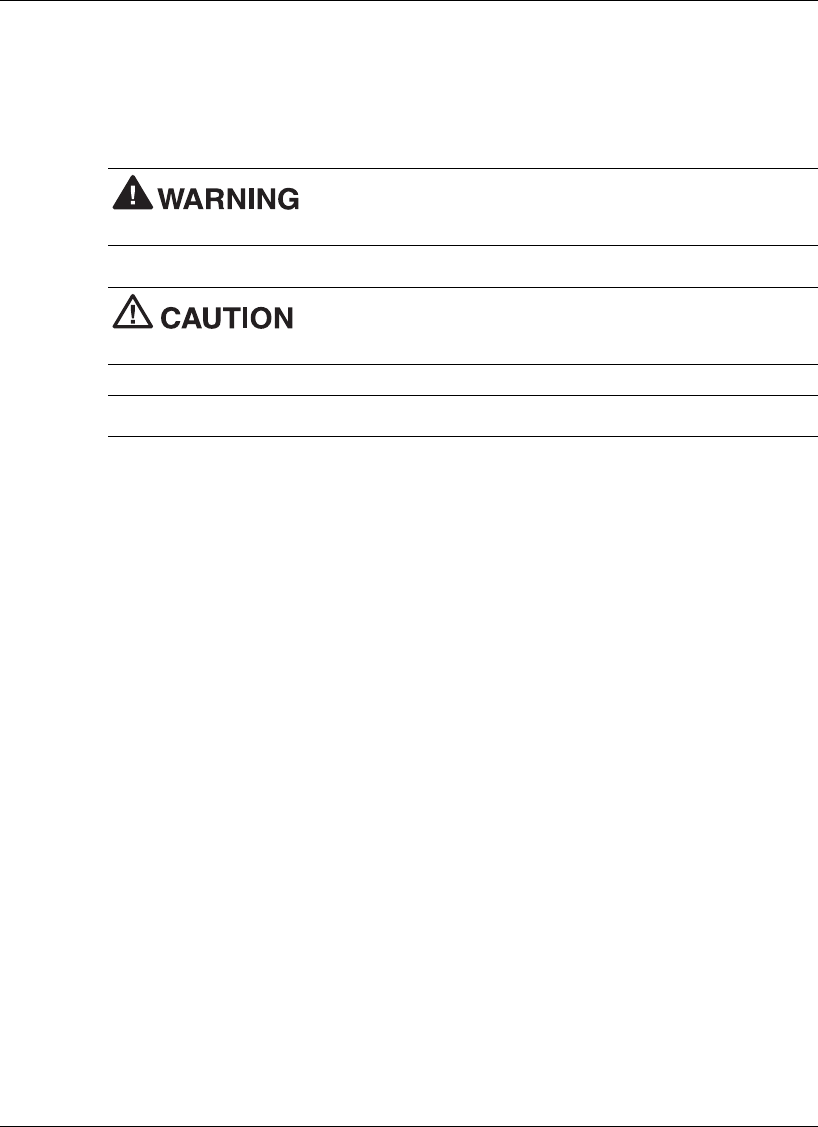
x Using This Guide
Text Conventions
To make this guide as easy as possible to use, text is set up as follows.
! Warnings, cautions, and notes have the following meanings:
Warnings alert you to situations that could result in serious
personal injury or loss of life.
Cautions indicate situations that can damage the hardware or
software.
Note Notes give important information, etc.
! Names of keys are printed as they appear on the keyboard, for example, Ctrl, Alt, or
Enter.
! Text that you must type or keys that you must press are presented in bold type. For
example, type dir and press Enter.
Related Documents
See the following documents for additional information on your NEC Versa notebook
computer:
! The NEC Versa L320 Quick Setup sheet helps get your system up and running.
! The NEC Versa L320 Quick Reference card provides an easy-to-carry reference to
LED meanings, controls, function key combinations, and NECC help numbers.
(The quick reference card does not ship with some systems purchased outside the
United States and Canada.)
The NEC Info Center is a fully navigational PDF document containing multimedia
elements, a full search capability, and important information about your NEC Versa.
1
Introducing the NEC Versa
! Before You Begin
! About Your NEC Versa L320 Notebook
! Around the Front of the System
! Around the Back of the System
! Around the Left Side of the System
! Around the Right Side of the System
! Around the Bottom of the System
! About the NEC Cable PortBar
! About NEC Wireless LAN

1-2 Introducing the NEC Versa
Before You Begin
Prolonged or improper use of a computer workstation may pose a risk
of serious injury. To reduce your risk of injury, set up and use your computer in the
manner described in Appendix A, Setting Up a Healthy Work Environment.
After completing the steps in the quick setup sheet that comes with your computer,
your NEC Versa L320 system is ready to go! To get started, do the following:
! Read Appendix A, “Setting Up a Healthy Work Environment,” for guidelines that
help you use your computer productively and safely. Information includes how to
set up and use your computer to reduce your risk of developing nerve, muscle, or
tendon disorders.
! Read through this guide to familiarize yourself with the NEC Versa.
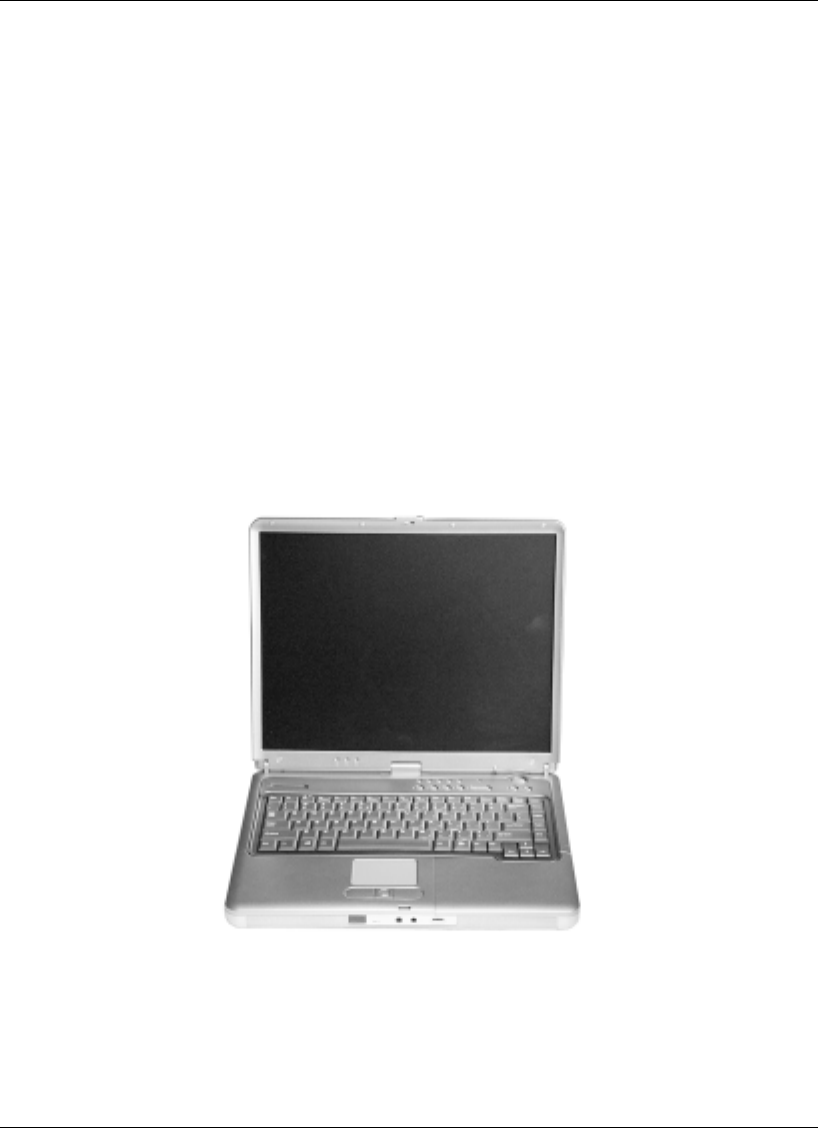
Introducing the NEC Versa 1-3
About Your NEC Versa L320 Notebook
The NEC Versa L320 notebook computer offers you a portable system filled with
exciting resources for business users. Standard features include a powerful Mobile
Intel® Pentium® III Processor-M running at 933 MHz, 1 GHz, 1.13 GHz, or higher.
This processor is designed to work together with the latest Peripheral Component
Interconnect (PCI) architecture.
Your notebook computer supports up to 1 GB of system memory. In addition, your
system comes with a high-performance hard disk drive, diskette drive, PC Card support
and one of the following variable-speed optical drives: CD-ROM, DVD-ROM,
CD-RW, or combination CD-RW and DVD-ROM. Microsoft® Windows® 98 Second
Edition (SE) or Windows 2000 Professional is preinstalled. To optimize your
connectivity options, all systems ship with a built-in MDC modem and some models
come with a Mini PCI LAN or Mini PCI wireless LAN (when available). As a
multimedia system, your NEC Versa L320 supports the AGP x4 standard and provides
the tools needed to create and present impressive images using video clips and sound.
NEC Versa L320 notebook computer
To get comfortable with your notebook, read the following sections and take a tour
around your system!
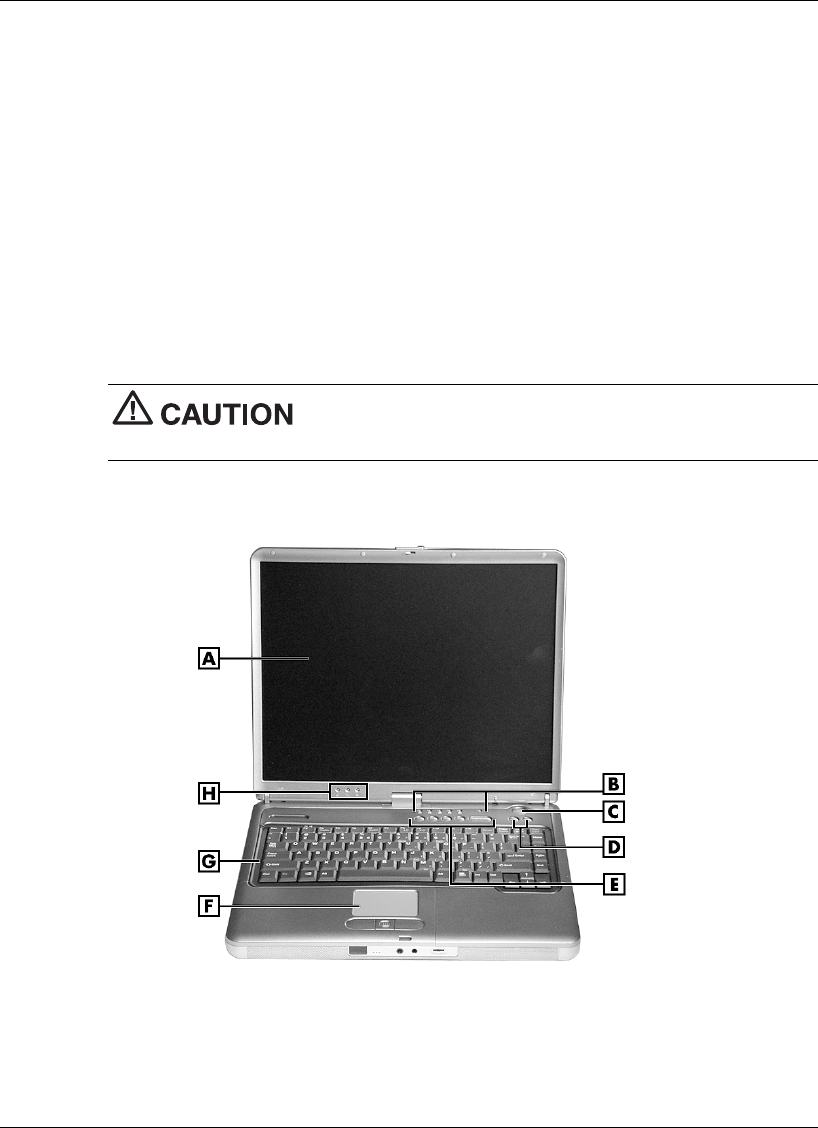
1-4 Introducing the NEC Versa
Around the Front of the System
The NEC Versa is compact with features on every side. First, look at the front of the
system.
Opening Your System
Open your NEC Versa L320 notebook computer by sliding the LCD panel latch to the
right. Lift the cover to reveal the LCD panel and the base unit features. See the section,
“Front Features,” to locate the latch.
Base Unit
The base unit of your NEC Versa notebook offers the features shown in the following
figure. Feature descriptions are provided after the figure.
After extended use, the surface of the base unit, below the
keyboard, may become hot to the touch.
LCD panel and base unit
A – LCD Panel E – Personal Code Buttons
B – Operating Status LEDs F – NEC VersaGlide Touchpad
C – Power Button G – Keyboard
D – Shortcut Buttons H – Power Status LEDs

Introducing the NEC Versa 1-5
! LCD Panel — Provides a high-resolution display for sharp, effective visuals on
your NEC Versa notebook.
! Operating Status LEDs — Keep you informed of your NEC Versa notebook’s
current operating status (see the section, “Status LEDs”).
! Power Button — Powers on and off the system (see the section, “Control Panel”).
! Shortcut Buttons — Launch your browser or your e-mail application with these
buttons (see the section, “Control Panel”).
! Personal Code Buttons — Sets a personal code for security. Available on some
systems (see the section, “Control Panel”).
! NEC VersaGlide™ Touchpad — Works like a standard computer mouse. Simply
move your fingertip over the VersaGlide to control the position of the cursor. Use
the selection buttons below the VersaGlide to select menu items. See “Using the
NEC VersaGlide” in Chapter 2 for information about customizing VersaGlide
settings.
! Keyboard — Provides 87 keys with the standard QWERTY-key layout. (Models
purchased outside of the U.S. and Canada ship with country-specific keyboard
layouts.)
! Power Status LEDs — Indicate whether the system is running on AC power or
battery power, and indicate battery status (see the section, “Status LEDs”).
Control Panel
The NEC Versa L320 control panel provides the features shown in the following
figure. The control panel features are described after the figure.
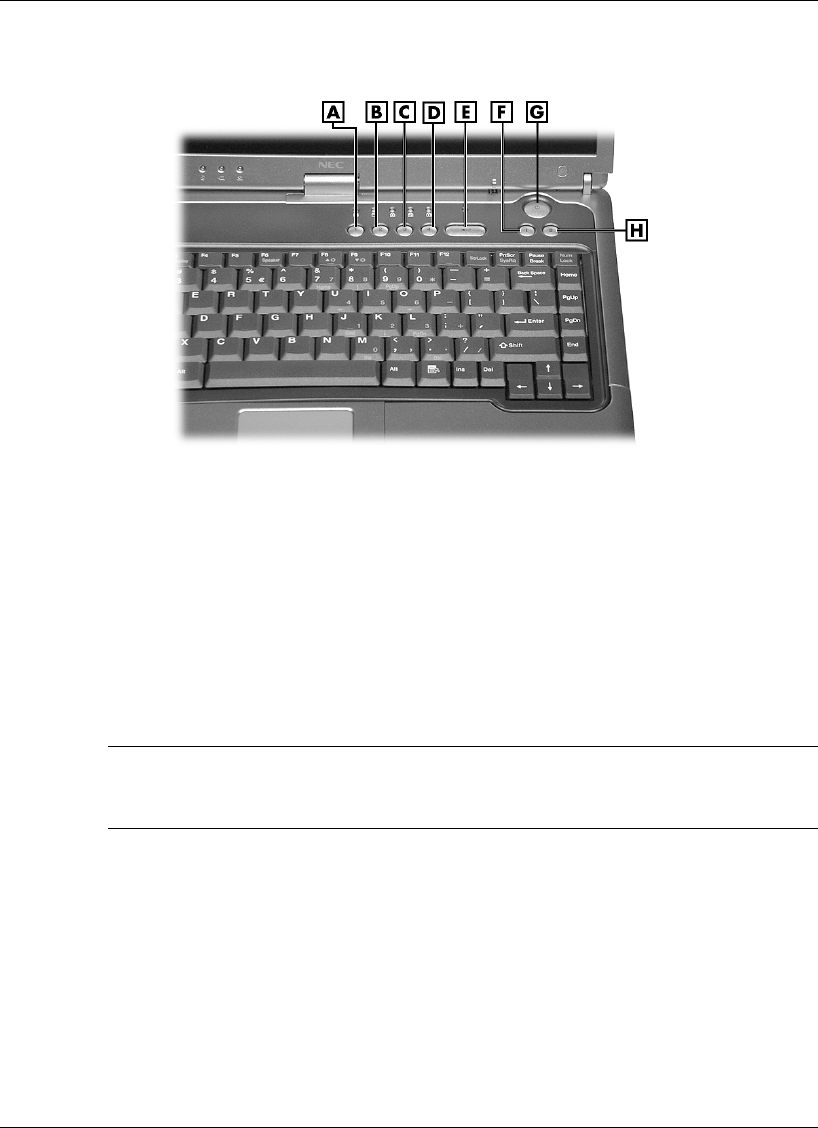
1-6 Introducing the NEC Versa
Control panel
A – Personal Code Button 1 E – Personal Code Enter Button
B – Personal Code Button 2 F – Shortcut Button
C – Personal Code Button 3 G – Power Button
D – Personal Code Button 4 H – Shortcut Button
Security and Personal Code Buttons
Some systems have Personal Code Setting buttons. Use the buttons to set, enter,
change, or cancel a personal security code. See “Personal Code Setting Utility” in
Chapter 4 for more information.
Power Button
Note If you are unable to power off the system, use the power override. Press the
Power button and hold it in place approximately 4 to 5 seconds until the system powers
off.
The Power button is a “smart” switch. It recognizes when the system is in a
Windows 98 or Windows 2000 Standby mode, if the BIOS parameter “System Switch”
is set to “Sleep.” If the system is in Standby mode, you cannot power off until you
press the Power button to resume operation.
Put the unit in Standby mode when you need to be away from your system for a short
period of time and want to return to where you left off. Standby mode shuts down all
devices in the system while retaining data and system status.
! In Windows 98 and Windows 2000, go to Start, Shutdown, Standby to put your
system into Standby mode.
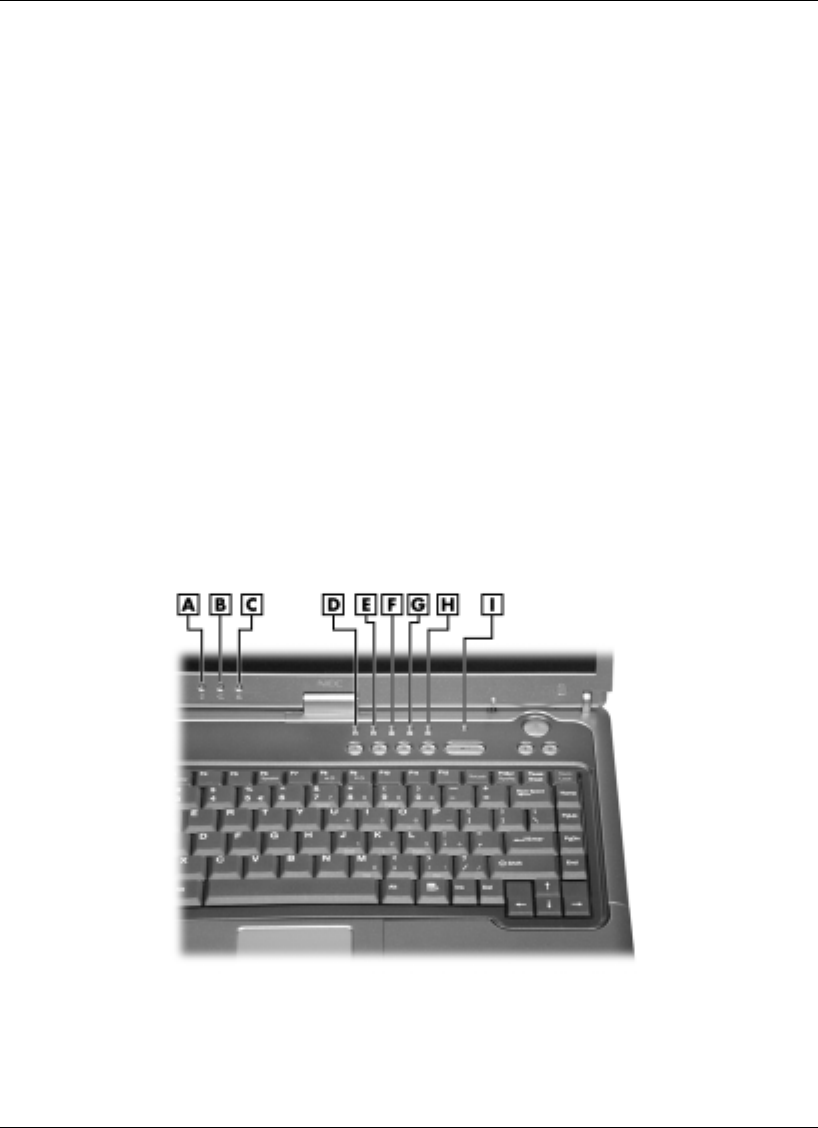
Introducing the NEC Versa 1-7
! Use the Power button in the following ways:
— Press the Power button to power on.
— Press the Power button to resume from a Windows 98 or Windows 2000
Standby mode and proceed with normal operation.
— Hold the Power button in place for 4 or more seconds to initiate power override
(powers off the system). Only use this option if you cannot power off your
system using Start, Shutdown.
Shortcut Buttons
Some systems have shortcut buttons that can be configured to launch your default
Internet browser and your default e-mail application. See “One-Touch Start Button
Settings Utility” in Chapter 4 for information about configuring the buttons.
Status LEDs
The NEC Versa L320 system uses status lights marked with icons to communicate
power status and operating status. Most of these LEDs are on the control panel (see the
following figure). See the following sections for information about each LED.
Control panel LEDs
A – Power LED F – Caps Lock LED
B – Battery Status LED G – Scroll Lock LED
C – E-mail Notification LED H – Num Lock LED
D – Drive Activity LED I – Security Indicator LED
E – NEC Modular Bay Drive Activity LED

1-8 Introducing the NEC Versa
Note The Radio Wave Status LED (available on some models) is on the right side
of the unit. See “Around the Right Side of the System” to locate the LED and for a
description of the LED.
Power Status LEDs
Power Status LEDs indicate your NEC Versa L320’s current power status.
! Power Status LED — Lights to indicate the following status:
— Lights green when the system power is on.
— Blinks green when the system is in Standby mode.
— Lights yellow (blinks when in Standby mode) to indicate that battery power is at
8% capacity or less.
— Lights amber (blinks when in Standby mode) to indicate that battery power is at
3% capacity or less.
! Battery Charging LED — Lights to indicate battery charging activity.
— Lights amber when the primary battery is charging. Blinks amber to indicate an
error. The primary battery is installed in the battery bay.
— Lights green when the secondary battery is charging. Blinks green to indicate an
error. The secondary (optional) battery is housed in the NEC Modular Bay.
Note The system also has a Power Status LED and a Battery Charging LED on the
back of the LCD panel. These LEDs can be seen when you are behind your notebook
computer, or when the LCD panel is closed.
Operating Status LEDs
Operating status LEDs keep you informed of your NEC Versa L320’s current operating
status.
! E-mail Notification LED — Some systems have an LED that lights when new
e-mail is received.
Note The system also has an E-mail Notification LED on the back of the LCD panel.
This LED can be seen when you are behind your notebook computer, or when the LCD
panel is closed.
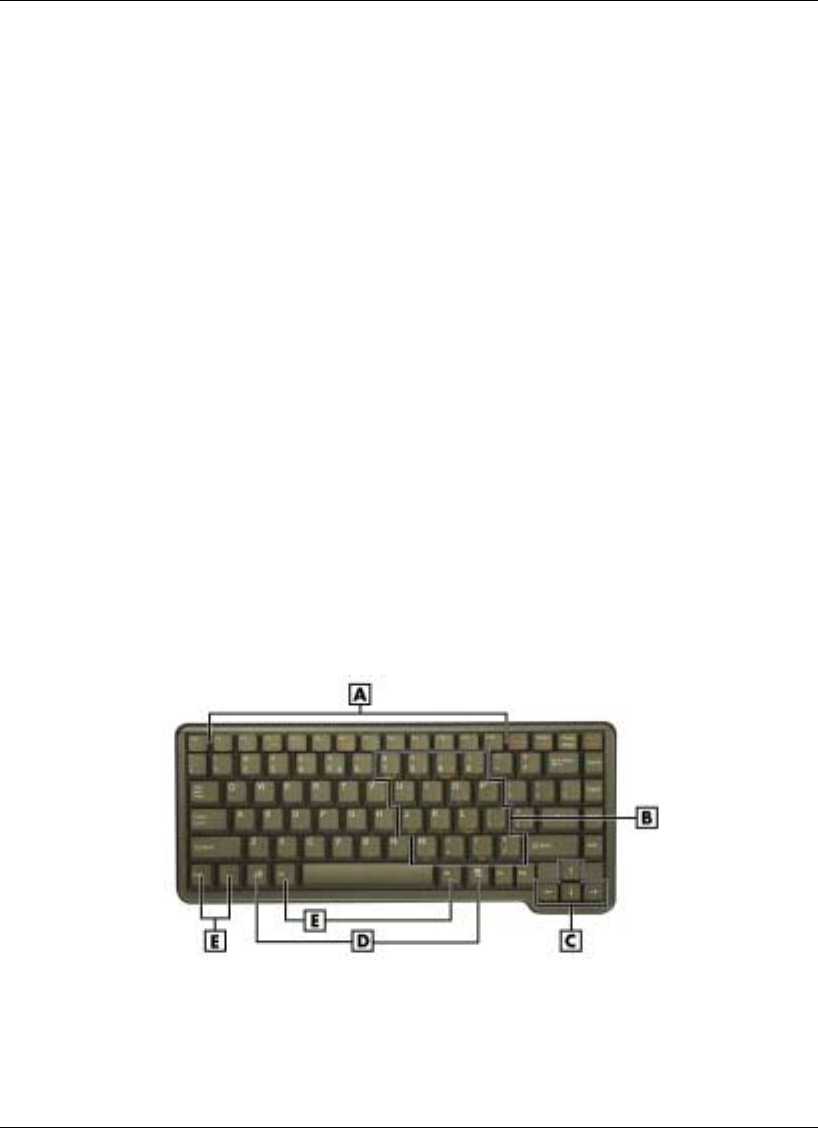
Introducing the NEC Versa 1-9
! Drive Activity LED — Lights when the NEC Versa L320 accesses the hard disk or
an NEC VersaBay™ IV drive (second hard disk, CD-ROM, DVD-ROM, CD-RW,
or combination CD-RW and DVD-ROM drive).
! NEC Modular Bay Drive Activity LED — Lights when the NEC Versa L320 writes
data to or retrieves data from the diskette drive in the NEC Modular Bay.
! Caps Lock LED — Lights when caps lock is in effect.
! Scroll Lock LED — Lights when scroll lock is in effect (not supported in the U.S.
or Canada).
! Num Lock LED — Lights when num lock mode is active.
! Security Indicator LED — Lights green when the system is in security mode (not
supported on all systems).
! Radio Wave LED (on the right side of the system) — Lights green when a
Bluetooth™ (when available) or Wireless LAN device is on. The LED goes out
when the device is in a Sleep mode. To locate this LED, see the figure “Right-side
features” later in this chapter.
Keyboard Panel
The NEC Versa L320 keyboard has a standard QWERTY-key layout. (Models shipped
outside the U.S. are equipped with country-specific keyboard layouts.) Keyboard
features are described after the figure.
Keyboard
A – Function Keys D – Windows Keys
B – Numeric Keypad E – Control Keys
C – Cursor Control Keys

1-10 Introducing the NEC Versa
! Function Keys — Twelve function keys, F1 through F12, are available on the NEC
Versa L320 keyboard. These keys work together with the Fn key to activate special
preprogrammed functions.
Function keys can also be used within applications. Most are application-driven, so
their function varies according to the application in use. See the specific
application’s user guide for information about how each function key works within
the application you are using.
The following function key combinations are pre-programmed for the NEC Versa
L320.
Fn-Left Ctrl — Simulates pressing the right control key to support IBM 327X
connections (not supported in U.S./Canada).
Fn-F2 — Toggles a wireless device on and off (in some systems).
Fn-F3 — Toggles the video mode between LCD only, CRT only, Simultaneous
mode, and TV out.
Fn-F4 — Supported for Windows NT® Workstation 4.0. Sets standby power
management mode on, in Windows NT.
— In Windows NT, press any key to resume from Standby mode.
— No function when Windows 98 or Windows 2000 is configured for Advanced
Configuration and Power Interface (ACPI). In Windows 98 or Windows 2000,
Standby is equivalent to the Windows NT Suspend mode. To resume from the
Windows 98 or Windows 2000 Standby mode, press the Power button.
Fn-F5 — Zooms the screen in or out slightly.
Fn-F6 — Toggles the system speakers/beep off and on.
Fn-F7 — Toggles between various power management levels in Windows NT.
Beeps indicate the level chosen as follows:
1 beep Off
2 beeps Custom
3 beeps Highest Performance
4 beeps Longest Life
Fn-F7 has no function when Windows 98 or Windows 2000 is configured for
Advanced Configuration and Power Interface (ACPI).
Fn-F8 — Increases the LCD’s brightness (eight settings).
Fn-F9 — Reduces the LCD’s brightness (eight settings).
Scroll Lock — Toggles the scroll lock feature on and off.

Introducing the NEC Versa 1-11
Windows Keys — Use the following two keys to facilitate your work.
Shortcut/Application key – provides quick access to shortcut menus.
(This key acts like a right mouse button.)
Floating Window key – displays the Start menu.
! Numeric Keypad — Pressing Num Lock on the keyboard activates the numeric
keypad numbers and functions printed in yellow on top of the keys.
The keypad lets you type numbers and mathematical operands (+, –) as you would
on a calculator. The keypad is ideal for entering long lists of numbers.
When you press Num Lock again, the keys revert to their normal functions as
typewriter keys.
! Typewriter Keys — Typewriter keys (also called alphanumeric keys) are used to
enter text and characters. Keys with yellow print on them behave differently when
combined with control keys, the Fn key, or when Num Lock is active.
! Control Keys — Ctrl, Alt, Fn, and Shift are controls used in conjunction with other
keys to change their functions. To use control keys, press and hold the control key
while pressing another key. For example, “Press Ctrl c” means to hold down the
Ctrl key and type the letter c. Key combinations work specific to the application
you are running.
! Cursor Control Keys — Cursor control keys let you position the cursor on the
screen where you want. On the screen, the cursor is a blinking underline, block, or
vertical bar depending on the application. The cursor indicates where the next text
typed is inserted.
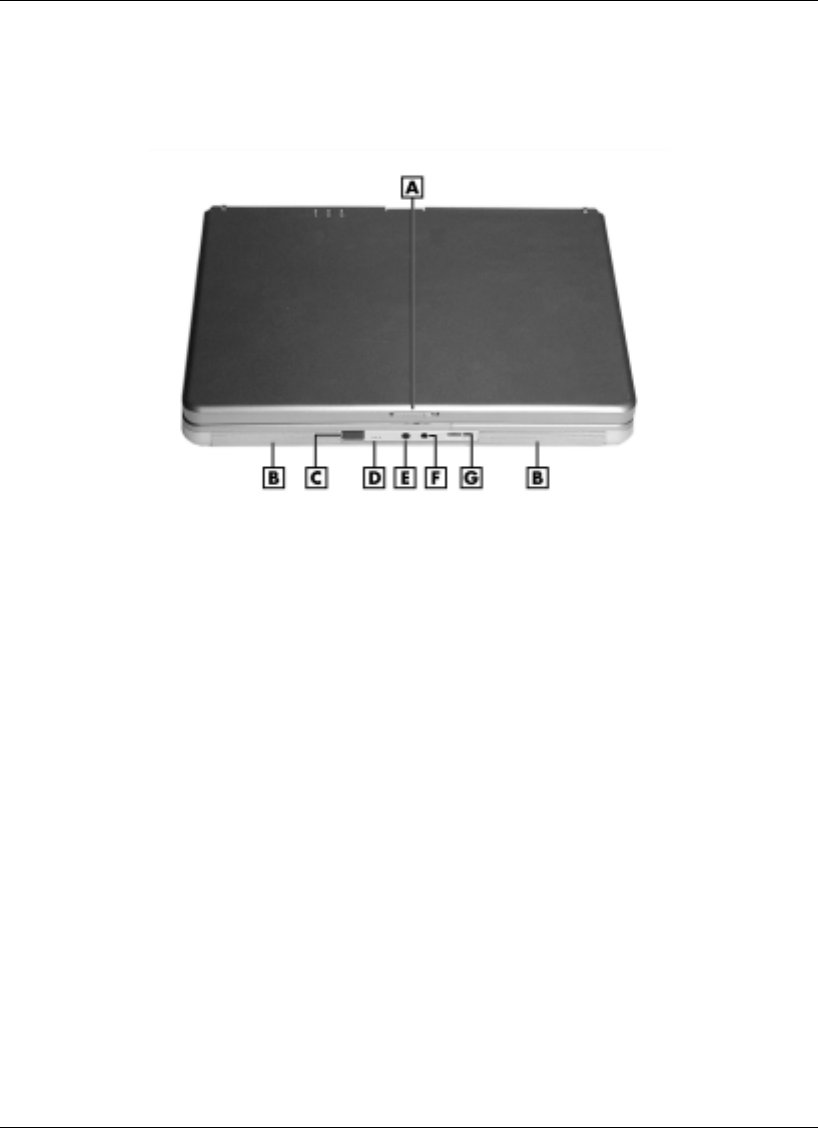
1-12 Introducing the NEC Versa
Front Features
The features on the front edge of the system are described after the following figure:
Front features
A – LCD Panel Latch E – Microphone In Port
B – Speakers F – Headphone In Port
C – IR Port G – Volume Control
D – Built-In Microphone
! LCD Panel Latch — Slide the latch to the right to open the NEC Versa L320
system.
! Stereo Speakers — Provide stereo sound for your multimedia presentations or
listening pleasure. The built-in sound system also supports 3D sound, which
simulates the latest surround-sound technology.
! IR Port — Allows you to transfer files between your NEC Versa and an infrared
(IR)-equipped desktop or notebook computer.
! Microphone — Allows you to record monophonic sound directly into your
notebook computer. See Chapter 9, “Using Multimedia,” for details about
recording.
! Microphone In Port— Allows you to connect an external microphone for
monophonic recording or amplification through the unit. Plugging in an external
microphone disables the built-in microphone.
! Headphone In Port — Lets you plug in stereo headphones or powered speakers.
! Volume Control — Allows you to control the speaker volume through the thumb
wheel.
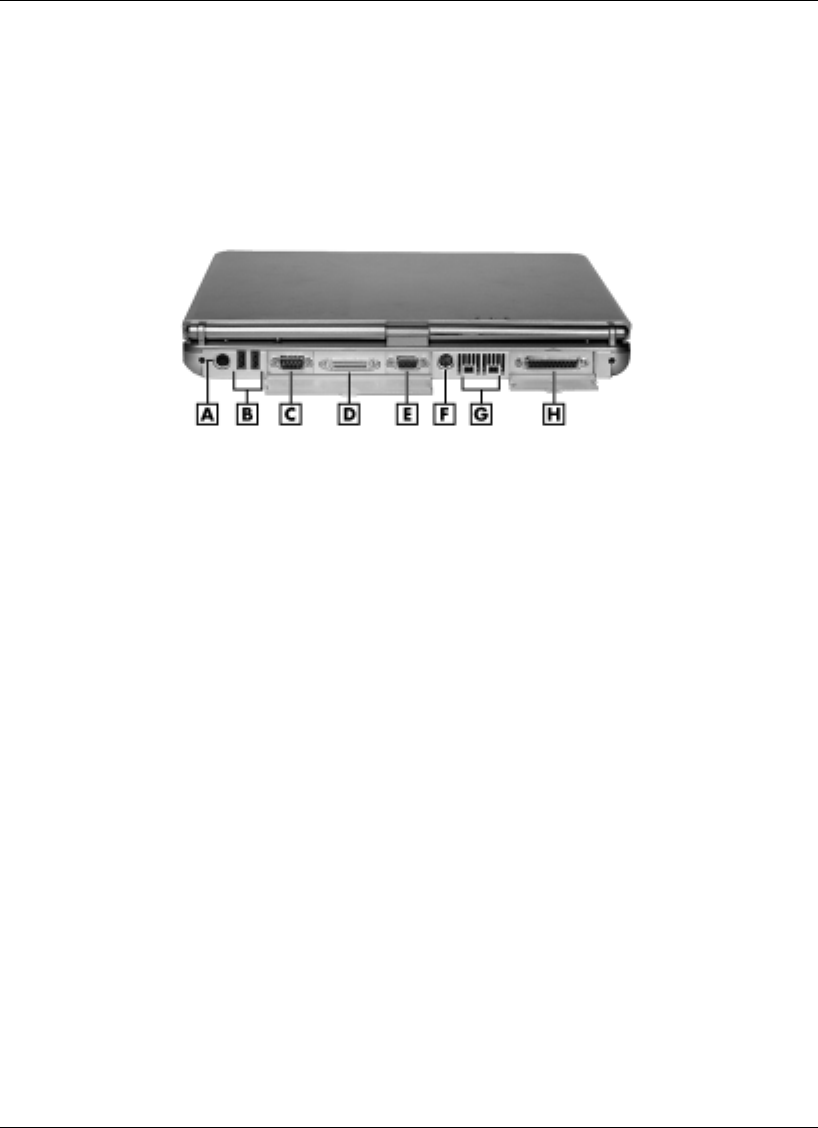
Introducing the NEC Versa 1-13
Around the Back of the System
You’ll find system ports for connecting your NEC Versa L320 to optional devices (like
a printer or external monitor) on the back of your NEC Versa L320. The ports are
described after the figure.
Back features
A – PS/2 Port E – VGA Port
B – USB Ports F – S-Video Out
C – Serial Port G – IEEE 1394 Ports
D – NEC Cable PortBar Connector H – Parallel Port
! PS/2® Port — Use the standard PS/2 port to connect an external PS/2-style mouse,
PS/2-style keyboard, or PS/2-style Numeric Keypad to the system. With an optional
Y-adapter cable, you can connect up to two of these devices at the same time.
! USB Ports — Each Universal Serial Bus (USB) port allows you to connect up to
127 USB-equipped peripheral devices (for example, printers, monitors, and
scanners) to your NEC Versa L320.
! Serial Port — Use this port to connect a digital camera or other serial device.
! NEC Cable PortBar™ Connector — Plug your optional NEC Cable PortBar (port
replicator) into this connector. You can connect many of your peripheral devices to
the NEC Cable PortBar instead of the connectors on the back of the system.
! VGA Port — Use this 15-pin port to attach an external monitor to your NEC Versa
L320.
! S-Video Out Port — Use this port to connect a camcorder, VCR, or a game
machine for a connection that provides increased clarity and sharpness of imagery.
! IEEE 1394 Ports — Use each port to daisy chain up to 63 IEEE 1394 devices to
your system. IEEE 1394 devices support Plug and Play connectivity for transfer
rates of up to 400 Mbps. The Windows NT operating system does not support the
IEEE 1394 ports.
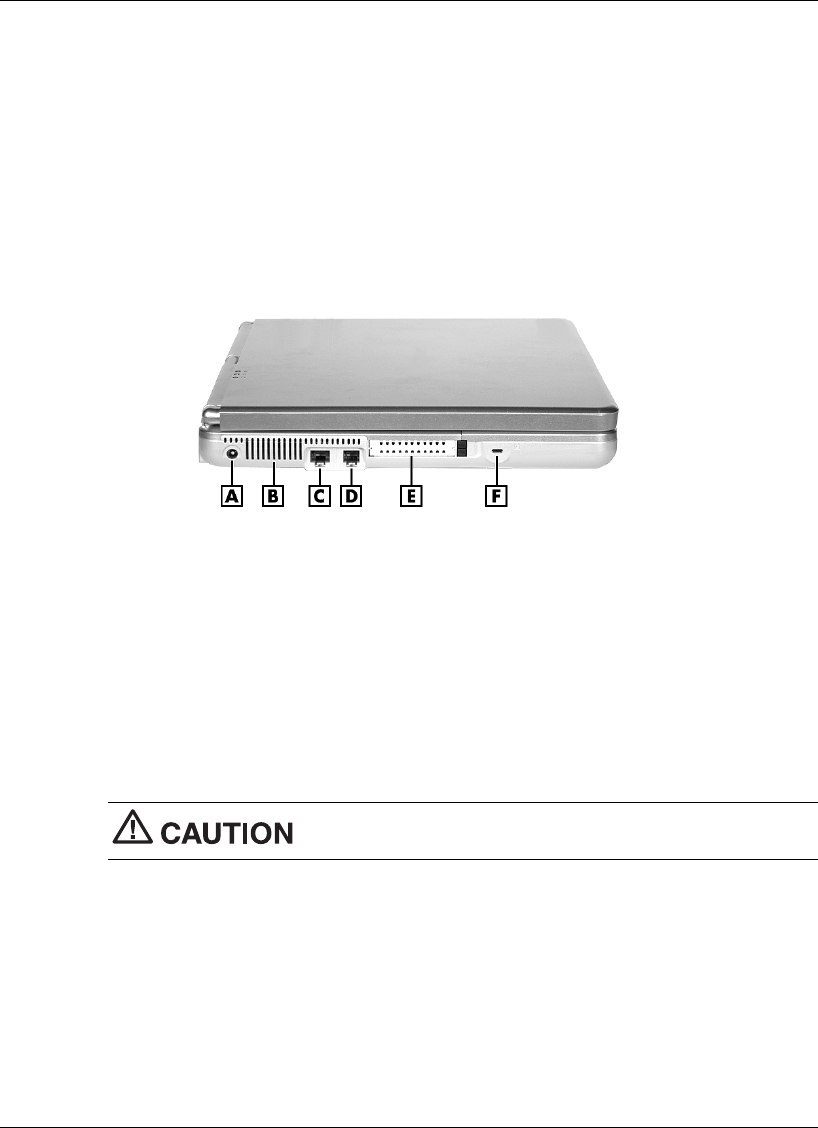
1-14 Introducing the NEC Versa
! Parallel Port — Connects a parallel printer or other parallel device. The parallel port
default supports the Enhanced Capabilities Port (ECP) standard. The port also
supports bi-directional and output only protocols.
Around the Left Side of the System
The left side of your NEC Versa L320 provides the features shown in the following
figure. The left-side features are described after the figure.
Left-side features
A – AC Power Port D – Modem Port
B – Fan E – PC Card Slots
C – LAN Port F – Kensington Lock Slot
! AC Power Port — Lets you attach the NEC Versa L320 to the AC power source
using the AC adapter that comes with your system. Keep the system connected to
AC power whenever possible to keep the battery pack and internal CMOS battery
charged.
! Fan — Allows your system to cool properly and maintain a safe operating
environment.
Do not block the fan while the NEC Versa L320 is in use.
! Modem/LAN Ports — Some systems include a V.90 fax/data modem or a Mini PCI
LAN port for network or Internet access.
! PC Card Slots — Two PC Card slots allow you to insert two Type II PC Cards or
one Type III PC Card in the bottom slot.
! Kensington® Lock Slot— This slot allows you to attach a Kensington security lock
or other compatible lock to secure the notebook from theft.
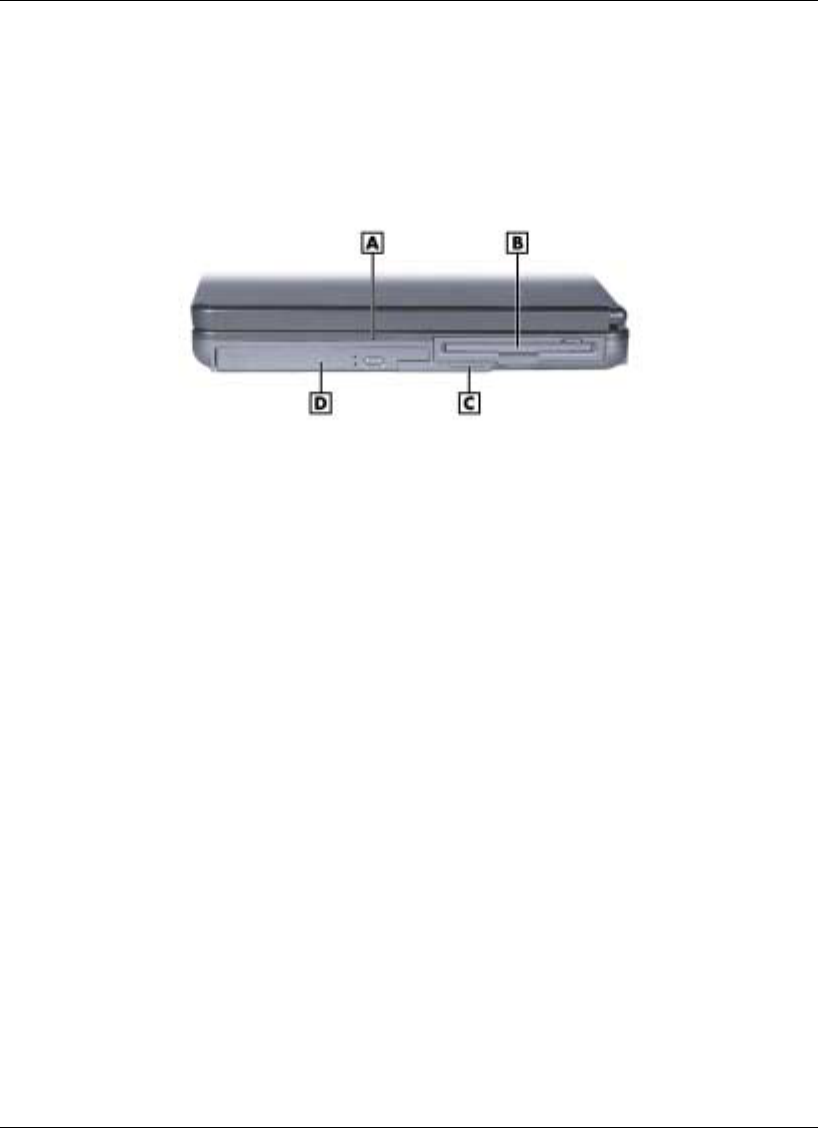
Introducing the NEC Versa 1-15
Around the Right Side of the System
The right side of the NEC Versa L320 offers the features shown in the following figure.
The right side features are described after the figure.
Right side features
A – Radio Wave Status LED C – Modular Bay Latch
B – NEC Modular Bay Slot D – VersaBay IV Slot
! Radio Wave Status LED — Provides the operating status of a Bluetooth™ or
Wireless LAN device. The LED lights green when the Bluetooth or Wireless LAN
device is on. The LED goes out when the device is in a Sleep mode.
! NEC Modular Bay Slot — Houses a diskette drive or an optional secondary battery.
Devices can be swapped without the system being disassembled or turned over.
! Modular Bay Latch — Slide the latch to the left before removing a Modular Bay
device from the system.
! NEC VersaBay IV Slot — Houses a CD-ROM, CD-RW, DVD-ROM, combination
CD-RW and DVD-ROM drive, or a second hard drive. One of these drives comes
with the notebook. This slot can also house an optional hard disk drive that’s been
placed in a specially designed cradle.
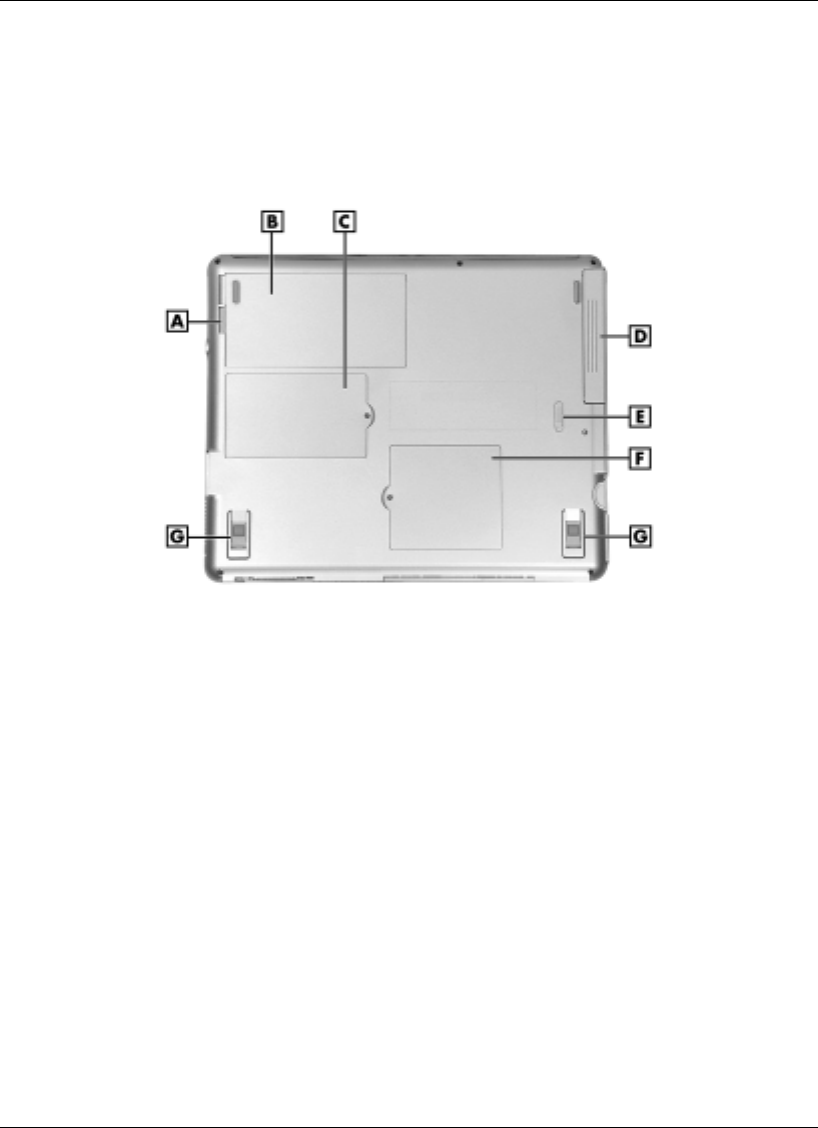
1-16 Introducing the NEC Versa
Around the Bottom of the System
The bottom of the NEC Versa L320 offers the following features. The features are
described after the figure.
Bottom features
A – Battery Release Latch E – VersaBay IV Latch
B – Primary Battery Bay F – Memory Module Bay Cover
C – Mini PCI and MDC Bay Cover G – Tilt Foot
D – NEC VersaBay IV Slot
! Battery Release Latch — Press the latch toward the edge of the system and hold it.
Lift the battery up slightly by its edge and pull the battery toward the edge of the
system to free the battery connectors and remove the battery. Do not lift the battery
straight up.
! Primary Battery Bay — Equipped with a lithium ion (Li-Ion) battery.
! Mini PCI and MDC Bay Cover — Remove the screw to find the Mini PCI or MDC
card.
! NEC VersaBay IV Slot — Houses a CD-ROM, CD-RW, DVD-ROM, or
combination CD-RW and DVD-ROM drive.
! Memory Module Bay Cover — Remove the screw to find two SO-DIMM slots.
One slot contains an SDRAM memory board configured by the factory. The other
slot is empty for upgrade use.
! Tilt Foot — Adjust each foot to provide a flexible keyboard angle.
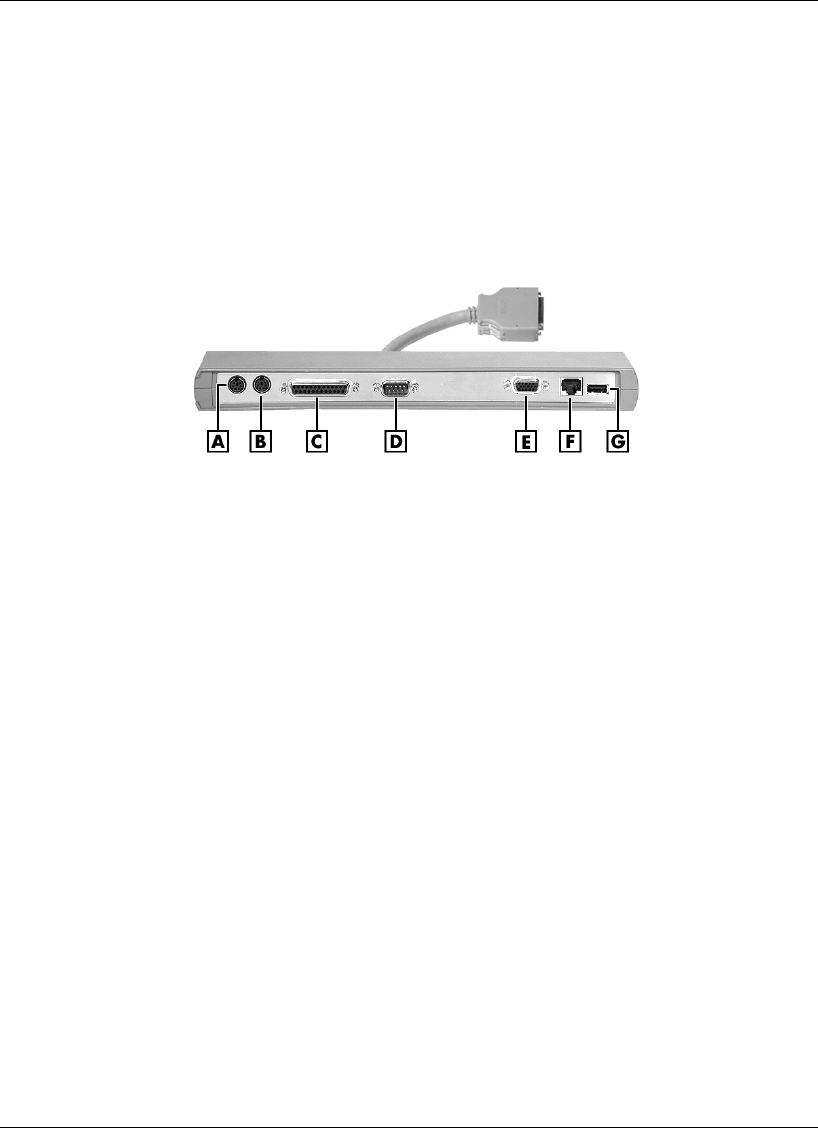
Introducing the NEC Versa 1-17
About the NEC Cable PortBar
The NEC Cable PortBar is an accessory that duplicates some of the ports on the back of
your NEC Versa L320 system, including a power connector. Ports include a LAN port
for a network connection. Keep the NEC Cable PortBar in your office connected to
peripherals while you take your NEC Versa L320 on the road.
The ports on the NEC Cable PortBar are described after the following figure.
NEC Cable PortBar
A – PS/2 Keyboard Port E – VGA Port
B – PS/2 Mouse Port F – LAN Port
C – Parallel Port G – USB Port
D – Serial Port
! PS/2 Keyboard Port — Connects to a 6-pin standard PS/2-style keyboard.
! PS/2 Mouse Port — Connects to a PS/2-style mouse.
! Parallel Port — Connects to a printer. You can change the LPT Mode in the Setup
program.
! Serial Port — Connects to a serial device, such as a digital camera.
! VGA Port — Connects to an external VGA/SVGA monitor.
! USB Port — Connects up to 127 peripheral devices to your notebook computer.
! LAN Port — Connects via an RJ-45 connector to the system’s built-in LAN card
(available on some models).
! Power Connector — Connects to an AC adapter. The NEC Cable PortBar has two
power connectors on the left side of the PortBar (see the following figure). Use the
19-volt DC power connector for the NEC Versa L320 notebook computer.
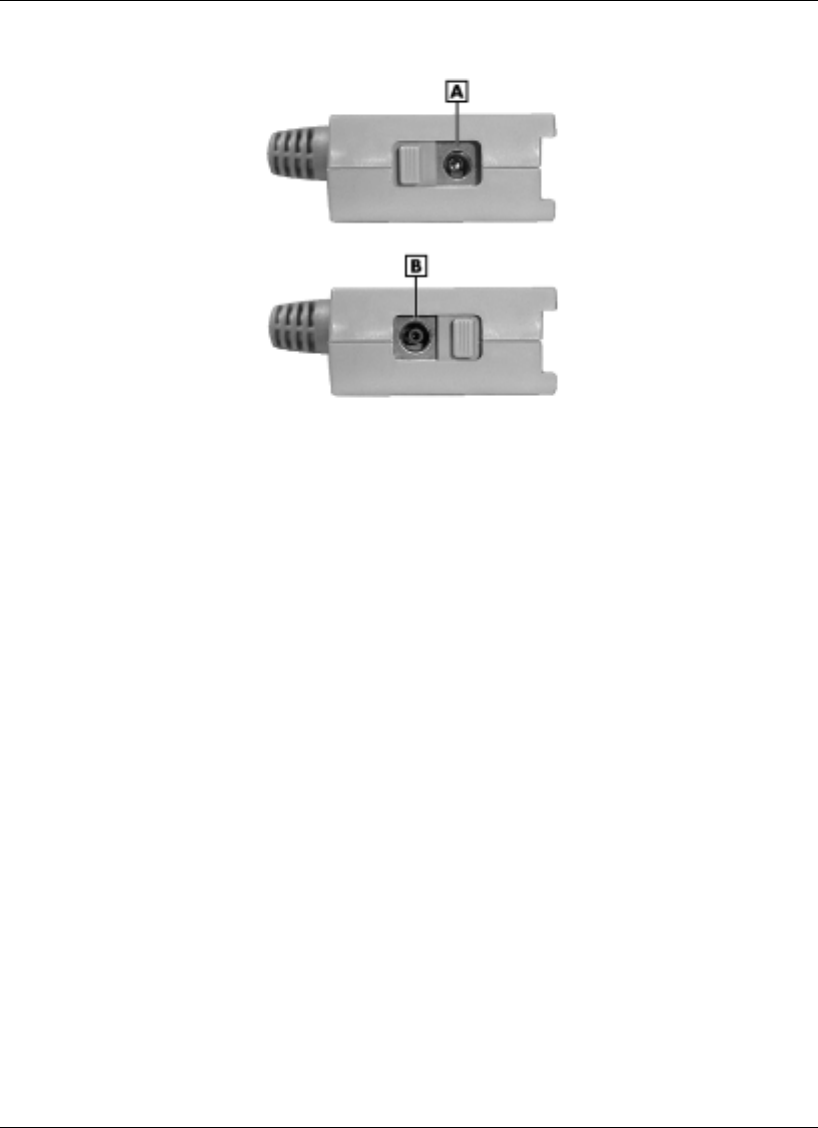
1-18 Introducing the NEC Versa
NEC Cable PortBar power connectors
A – 19-volt DC Power Connector for the NEC Versa L320 system
B – 15-volt DC Power Connector (for future use)
About NEC Wireless LAN
Some NEC Versa L320 notebook computers come with built-in wireless LAN
capabilities featuring the Wi-Fi™ (wireless fidelity) IEEE 802.11b High Rate (HR)
standard for business users. Wireless LAN eliminates the need for connecting cables
between your computer and your local area network, facilitating mobility, minimizing
downtime, and improving your productivity. With a wireless LAN solution, you have
the flexibility of accessing e-mail, the Internet, corporate intranets, and resource
planning applications on the network from your notebook computer.
The Wi-Fi compliant radio technology provides high-speed (11 Mbps) wireless
networking with the performance capabilities of a wired 10BaseT LAN connection.
Wi-Fi products are tested by an industry group, WECA (Wireless Ethernet
Compatibility Alliance), to meet the international IEEE 802.11b standard for wireless
radio technology and guaranteed to work with all other Wi-Fi certified products.

2
Getting Started
! NEC VersaGlide Touchpad
! Power Sources for Your NEC Versa
! AC Adapter
! System Batteries
! Using the Primary Battery
! Using a Secondary Battery
! System Care
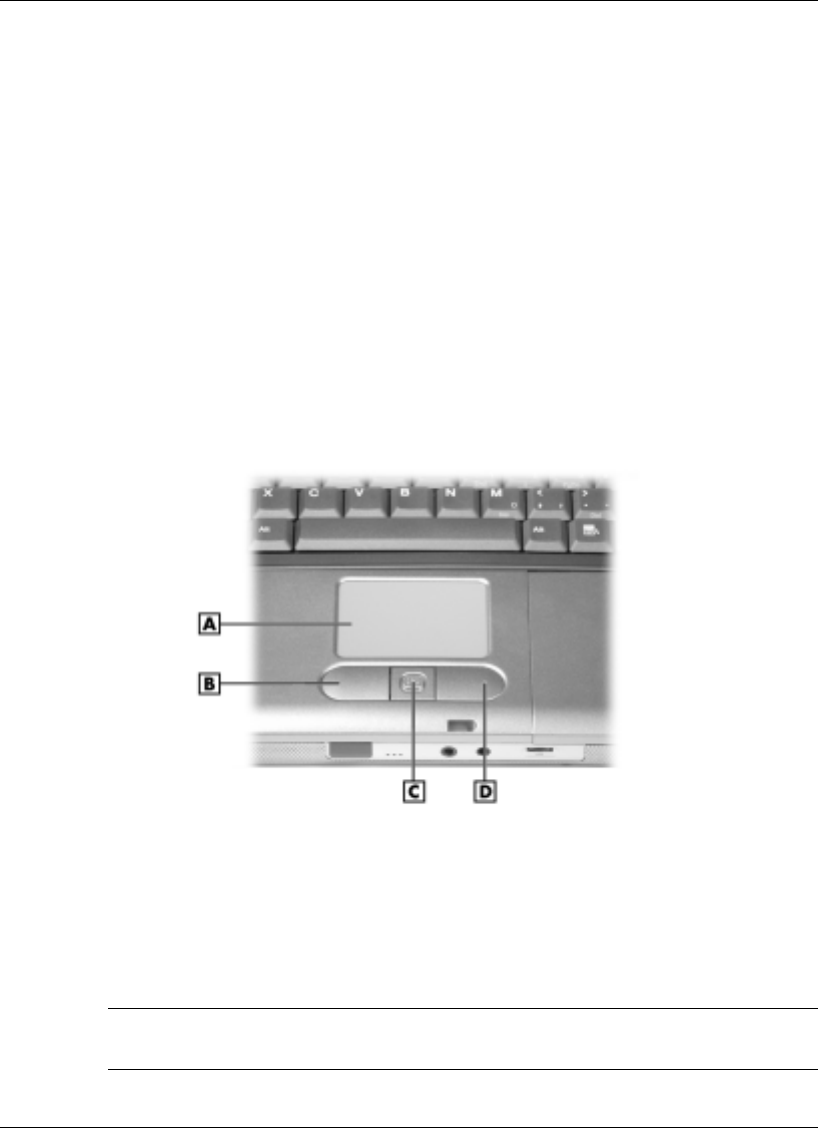
2-2 Getting Started
NEC VersaGlide Touchpad
The NEC VersaGlide touchpad is an easy way to control the cursor with your finger.
Lightly glide your finger across the NEC VersaGlide and the cursor follows. Use the
VersaGlide touchpad as follows.
! Single tap the touchpad — equivalent to a single click of the primary mouse
button.
! Double tap the touchpad — equivalent to a double click of the primary mouse
button.
! Click and hold, then drag your finger across the VersaGlide touchpad —
equivalent to a click and drag of the primary mouse button.
! Press the scroll button up or down to scroll your document or screen.
VersaGlide features
A – NEC VersaGlide touchpad C – Scroll Button
B – Left Button D – Right Button
Try all of the VersaGlide features and decide which you prefer. If you find the double
tap or any of the other features difficult to use, go to the next section for general
directions about adjusting the VersaGlide properties.
Note If you install another mouse driver over the shipping default, the double-tap
capability may be lost.

Getting Started 2-3
Making VersaGlide Adjustments
The NEC VersaGlide offers a number of options that let you customize how it
functions. The options let you control the cursor speed, select button orientation, enable
or disable tapping, define auto jumps, enable easy-scrolling, and configure gestures to
initiate selected functions by tapping in a designated area of the touchpad.
To access these options, locate the Windows Control Panel and double click the mouse
icon. Use the context-sensitive help to learn more about each option. Select the option,
and then press F1 to access the context sensitive help.
VersaGlide Tips
Follow these basic tips while working:
! Use a light touch on the VersaGlide surface.
! Set up the NEC Versa notebook with your keyboard and VersaGlide at a
comfortable height. Keep your forearms parallel to the floor. Your wrists should be
relaxed and straight.
! While using the keyboard and VersaGlide, keep your shoulders and arms as relaxed
as possible.
! Take regular breaks from the computer to rest your eyes. Perform stretching
exercises to relax your fingers, hands, wrists, forearms, and shoulders.
See Appendix A, “Setting Up a Healthy Work Environment,” for more information.
Power Sources for Your NEC Versa
The NEC Versa notebook can be powered using three different sources, making it a
truly portable system.
Operate your NEC Versa just about anywhere using one of the following power
sources:
! the AC adapter connected to an electrical wall outlet (using AC power)
! battery power:
— the 8-cell primary battery
— with or without the optional 8-cell secondary battery that installs in the Modular
Bay slot.
! the optional auto adapter. (Not available for all locations. For availability, consult
your NEC Computers vendor. For details about using an auto adapter, refer to the
accessory sheet that ships with the option.)
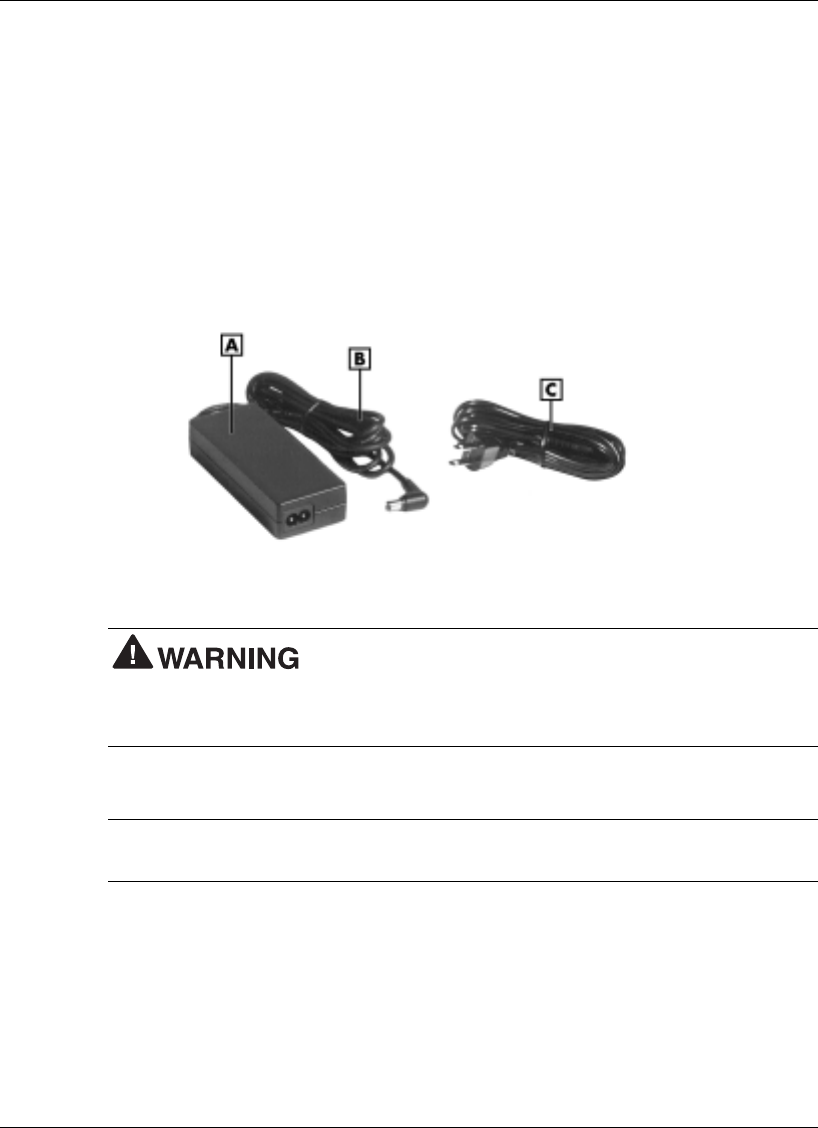
2-4 Getting Started
Read the following sections for specific information about using the NEC power
sources.
AC Adapter
Use the AC adapter and power cable that came with your NEC Versa notebook to run
your computer on alternating current (AC) power, or to recharge the battery.
Keep the adapter connected whenever possible. The AC adapter charges the battery
when it is connected, whether the NEC Versa notebook is powered on or off.
AC adapter
A – AC Adapter C – Power Cable
B – AC Adapter Cable
Do not attempt to disassemble the AC adapter. The AC
adapter has no user-replaceable or serviceable parts inside. Dangerous voltage in the
AC adapter can cause serious personal injury or death. The AC adapter is intended for
use with a computer and must meet EN609050 standards.
Connecting the AC Adapter
Note The AC power cable type that your system uses depends on the country
where you are using it. Contact the local dealer to purchase the correct power cable.
Connect the AC adapter as follows:
1. Connect the AC adapter cable to the power port on the left side of your NEC Versa
notebook.
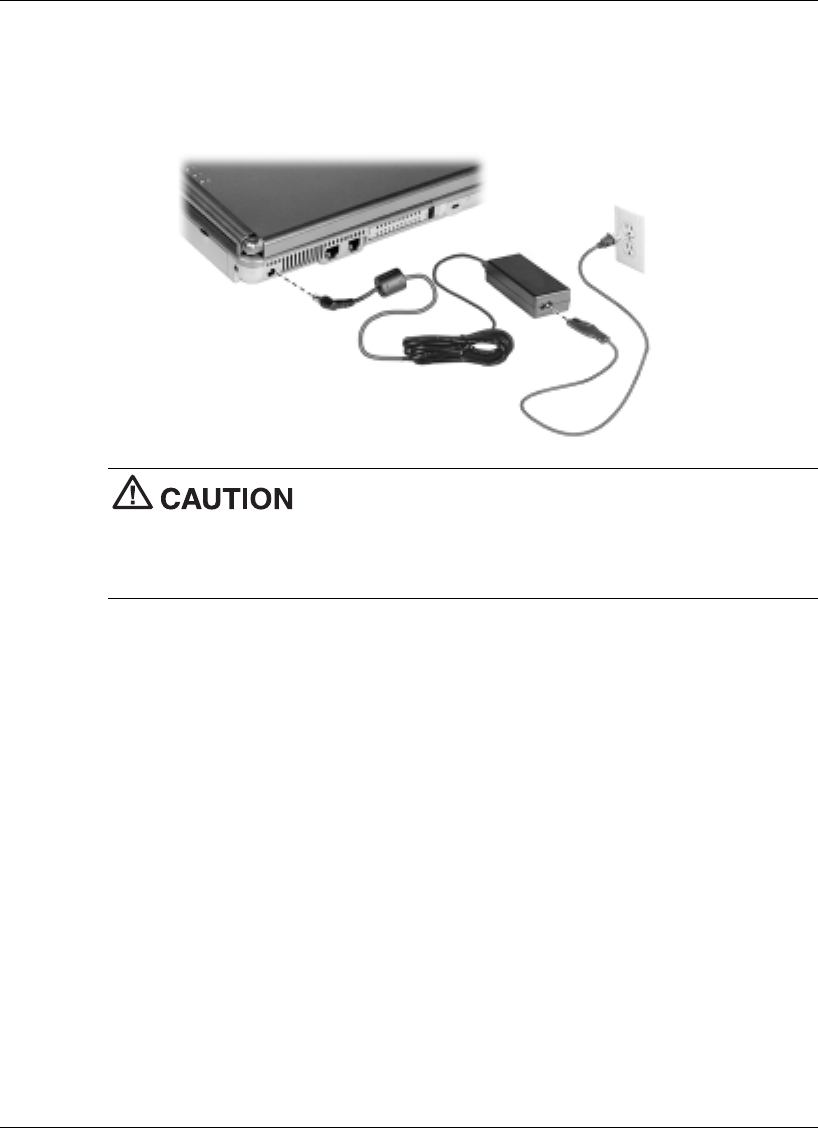
Getting Started 2-5
2. Plug one end of the AC power cable into the AC adapter and the other end into a
properly grounded 120- or 240-volt, 50- or 60-Hz wall outlet.
Connecting the AC adapter
Do not cover or place objects on the AC adapter. Keeping the
adapter clear of objects lets the adapter cool properly during use.
Only use the AC adapter that comes with your NEC Versa L320. Although other
adapters look similar, using them can damage your system.
Powering On Your System
Power on the system as follows:
1. Locate the latch on the front of the LCD panel, slide it to the right, and raise the
panel.
2. Locate the Power button and press it to turn on system power. For additional
information about Power control buttons and power LEDs, refer to Chapter 1,
“Introducing Your NEC Versa.”

2-6 Getting Started
System Batteries
Your NEC Versa notebook is equipped with a primary lithium ion battery that helps to
prevent data loss. In addition, you can insert an optional secondary lithium ion battery
in the NEC Modular Bay slot to give you more on-the-go power.
Primary Battery
The standard lithium ion (Li-Ion) battery provides the main power source in your NEC
Versa L320 computer. Your system comes with an 8-cell lithium ion battery that fits
into the battery bay on the bottom of your system. See Appendix B for battery
specifications. In addition to this battery, the CMOS battery also provides system
power.
For information about installing or removing the primary battery, see the section,
“Replacing the Battery” later in this chapter. For more information about the primary
battery see the section, “Using the Primary Battery.”
Secondary Battery
You can install an optional secondary lithium ion battery in the NEC Modular Bay slot
on the right side of your NEC Versa notebook. Attaching a second fully charged battery
allows you to work longer while you are away from an AC power source. For more
information about the secondary battery, see the section, “Using the Secondary
Battery.” For information about installing a secondary battery, see “Installing a Device
in the Modular Bay Slot” in Chapter 5 or see the installation instructions that are
packaged with battery.
CMOS Battery
This lithium battery provides battery backup and prevents data loss in the system’s
complementary metal oxide semiconductor (CMOS) RAM. This memory area contains
information on the system’s configuration, for example, date, time, drives, and
memory. The CMOS battery charges when your NEC Versa notebook is connected to
AC power. The CMOS battery may discharge completely if the NEC Versa notebook
remains unused for approximately two months.
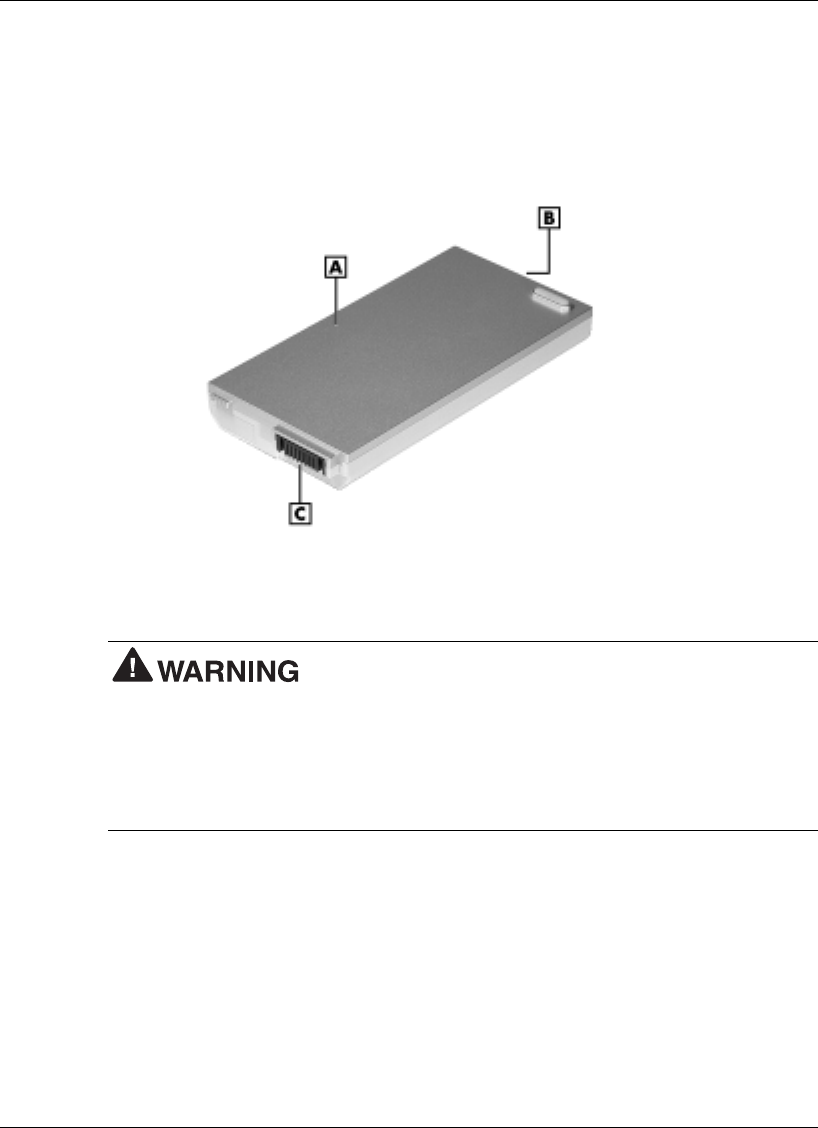
Getting Started 2-7
Using the Primary Battery
The NEC Versa notebook comes with a rechargeable 8-cell lithium ion (Li-Ion) battery
that’s easy to install and remove.
Primary battery
A – Primary Battery C – Connector
B – Battery Latch (hidden)
To prevent accidental battery ignition or explosion, adhere to
the following:
! Keep the battery away from extreme heat.
! Keep metal objects away from the battery connectors to prevent a short circuit.
! Make sure the battery is properly installed in the battery bay.
! Read the precautions printed on the battery.
Determining Battery Status
Your NEC Versa system provides tools to help you keep track of the main (and an
optional) battery’s power level. If your system is configured (default setting) to display
the Power icon on the taskbar, an electrical plug appears when the system is connected
to an AC power source or a battery icon appears when the system is not connected to an
AC power source.

2-8 Getting Started
Use the system’s power meter to determine battery status. Access the system’s power
meter in the following ways:
! Move the cursor over the Power icon on the taskbar to display the remaining battery
power for the system’s primary battery.
! Right click the Power icon on the taskbar to open the power meter or to adjust
power properties.
! Double click the Power icon on the taskbar to display the remaining power for both
the primary and optional secondary battery (if installed).
! Go to Start, Settings, Control Panel, and double click the Power Management icon.
Select the Power Meter tab.
Low Battery Status
When battery power is low (8% or less), the power LED lights yellow. When battery
power is very low (3% or less), the power LED flashes amber. When your system is in
a low battery status, do one of the following:
! Power off the system, remove the spent battery, and replace it with a fully charged
battery.
! Leave the spent battery in the system and connect your NEC Versa notebook to the
AC adapter and a wall outlet.
Returning the Battery to its Normal State
To return the battery to its normal state, try the following:
! Remove and then reinstall the battery.
! Reinstall the battery in your NEC Versa notebook and fully recharge the battery (to
100%).
! Refresh the battery using the Refresh Battery function in the Exit menu of the BIOS
Setup utility (see “Exit Menu” in Chapter 3).
Extending Battery Life
While on the road, it is important to be aware of the simple things you can do to extend
the life of the system’s main battery. One way is to keep the brightness setting low. Use
the Fn-F8 and Fn-F9 function keys to control the brightness.
In addition, NEC Computers recommends that you always operate your system on AC
power when using any external device and when playing DVD movies.

Getting Started 2-9
Battery Handling
Keep the following in mind when removing or replacing a battery.
! Use only the battery designed for your NEC Versa notebook. Mixing other
manufacturers’ batteries, or using a combination of very old and new batteries can
deteriorate battery and equipment performance.
! Turn off power to the system after use. Keeping system power on can degrade
battery performance and shorten battery life.
! Clean the battery connectors with a dry cloth when they get dirty.
! Keep the battery out of the reach of children.
Replacing the Battery
The following symptoms indicate that battery life is nearing an end. Replace batteries
that display these symptoms.
! Shorter work times.
! Discoloration, warping.
! Hot to the touch.
! Strange odor.
Replace the battery installed in your NEC Versa system as follows.
Note Use the batteries in the NEC Versa computer for which they are designed.
Installing another manufacturer’s battery, or using a combination of very old and new
batteries can deteriorate battery and equipment performance.
1. Save your files, exit Windows, and turn off system power.
2. Close the LCD panel and turn over the system.
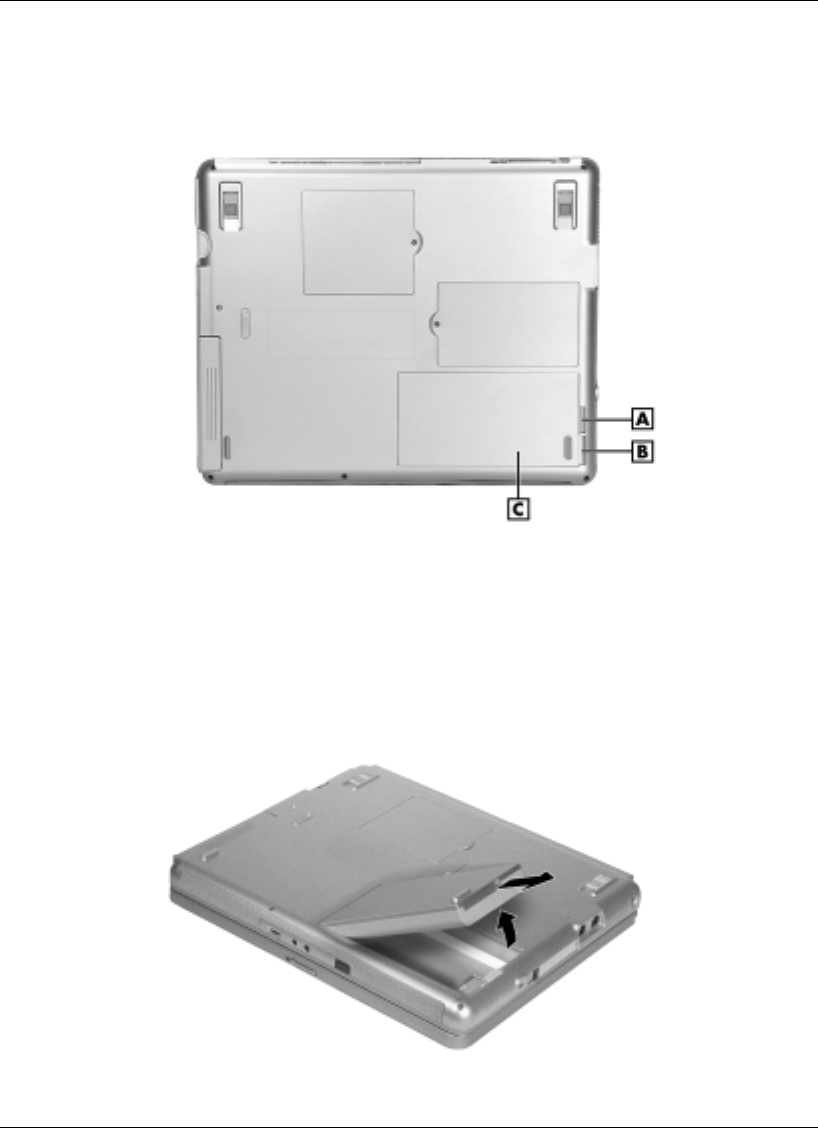
2-10 Getting Started
3. Slide the battery release latch toward the edge of the system and hold firmly.
Locating the battery bay release latch
A – Battery Release Latch C – Primary Battery
B – Indentation
4. Grasp the edge of the battery at the indentation in the system case. Lift the battery
up slightly. Once the edge is free, pull the battery out at an angle. Do not lift the
battery straight up.
Removing the battery
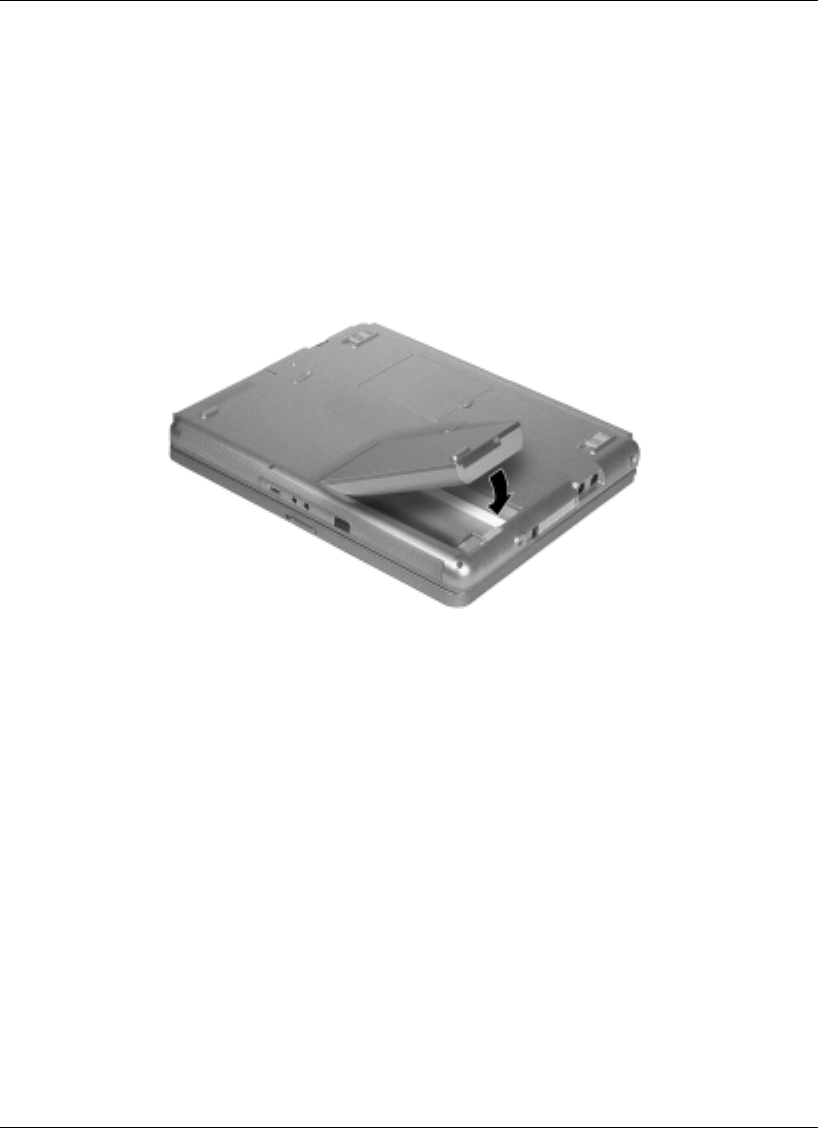
Getting Started 2-11
5. Insert the new battery as follows:
! Locate the connector on the edge of the battery.
! Locate the connector inside the battery bay.
! Place the battery in the battery bay at an angle so the connectors line up.
! Lower the battery into the bay, making sure that the battery release latch
secures the battery in place.
Inserting the battery
6. Turn the system over.
Charging the Battery
Charge the primary battery and optional secondary (Modular Bay) battery by simply
connecting your NEC Versa L320 system to an AC power source. To monitor the
charging activity, observe the battery charging LED on the front of the system. The
battery charging LED lights as follows:
! Lights amber when the primary battery is charging.
! Blinks amber if the primary battery encounters an error while charging.
! Lights green when the secondary battery is charging.
! Blinks green if the secondary battery encounters an error while charging.

2-12 Getting Started
Battery Precautions
To prevent accidental battery ignition, rupture, or explosion, adhere to the following
precautions.
There is a danger of explosion if the battery is
incorrectly replaced. Replace only with the same or equivalent type recommended
by the manufacturer. Discard used batteries according to the manufacturer’s
instructions.
To avoid personal injury and property damage, read these battery precautions on
handling, charging, and disposing of Li-Ion batteries.
! Keep the battery away from heat sources including direct sunlight, open fires,
microwave ovens, and high-voltage containers. Temperatures over 140º F
(60ºC) may cause damage.
! Do not drop or bump the battery.
! Do not disassemble the battery.
! Do not solder the battery.
! Do not puncture the battery.
! Do not use a battery that appears damaged or deformed, has any rust on its
casing, is discolored, overheats, or emits a foul odor.
! Keep the battery dry and away from water.
! Keep metal objects away from battery connectors. Metal objects in contact
with the connectors can cause a short circuit and damage.
If the battery leaks:
! If the battery leaks onto skin or clothing, wash the area immediately with
clean water. Battery fluid can cause a skin rash and damage fabric.
! If battery fluid gets into eyes, DO NOT rub; rinse with clear water immediately
and consult a doctor.
! Take extra precautions to keep a leaking battery away from fire. There is a
danger of ignition or explosion.
Precautions for Recharging the Battery
Adhere to the following precautions when recharging the primary or secondary battery.
! Charge the battery for the specified charge time only.
! During charging, keep the environmental temperature between 32°F and 104°F
(0°C to 40°C).
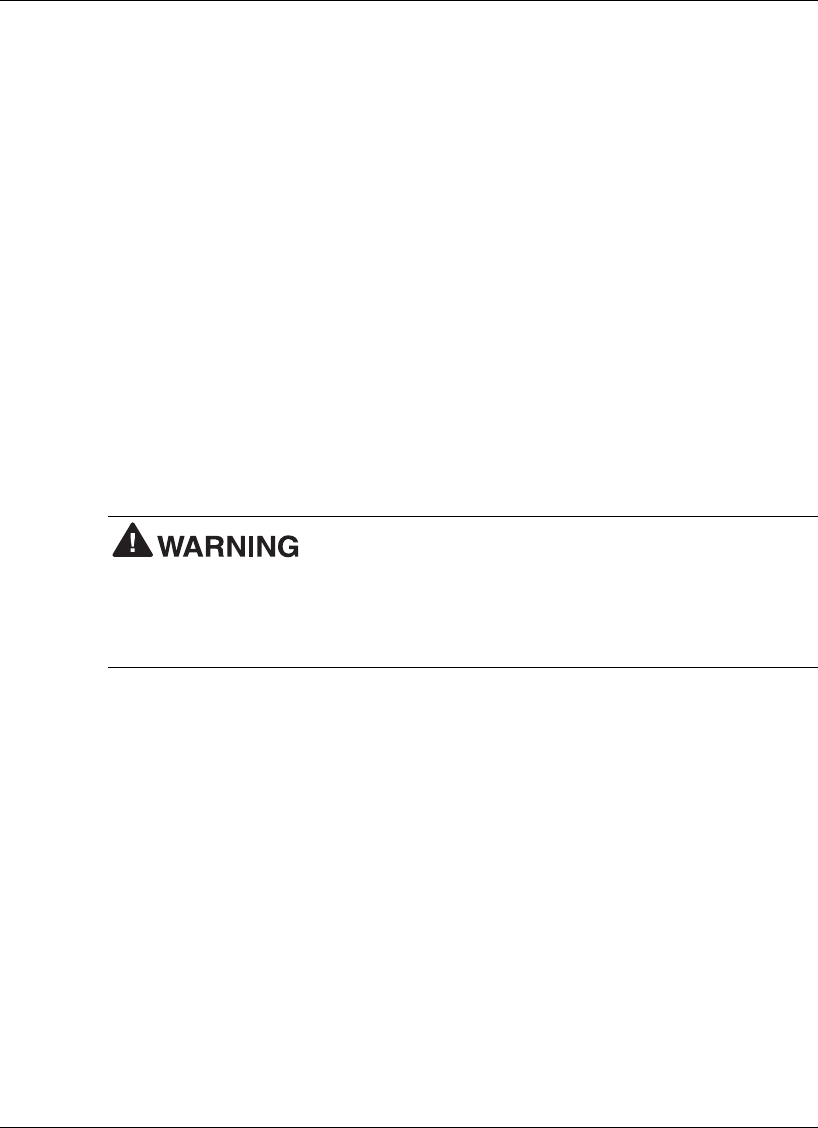
Getting Started 2-13
Using a Secondary Battery
An optional secondary 8-cell battery is available for your NEC Versa notebook. This
battery installs in the Modular Bay slot on the right side of your computer.
Use the secondary battery in addition to the primary battery to extend the amount of
time you can run your system on battery power.
Secondary Battery Precautions
Use these precautions when using the secondary battery in the Modular Bay slot.
! Do not attempt to run the system on secondary battery power if the primary battery
is not installed.
The connectors in the primary battery bay should not be exposed. Connectors can
cause a danger if they are accidentally touched or if they connect with a metal
object during system operation.
! Always install the weight-saving module that ships with your system in the
Modular Bay slot if no Modular Bay device is installed in the slot.
Do not run the system on secondary battery power without the
primary battery in place. The connectors in the primary battery bay can cause a danger
if they are accidentally touched, or if they connect with a metal object.
If the Modular Bay slot is empty, always install the weight-saving module to protect the
bay and the connectors within it.
Also see the precautions in the section, “Using the Primary Battery” for information
that applies to the safe use of the secondary battery.
Replacing the Secondary Battery
See “Removing a Device from the NEC Modular Bay Slot” and “Installing a Device
in the NEC Modular Bay Slot” in Chapter 5 for instructions on installing or removing
the optional 8-cell secondary battery from the Modular Bay.
See the previous section, “Secondary Battery Precautions” for information about the
safe use of the secondary battery. Also see the section, “Using the Primary Battery”
earlier in this chapter for general information about handling system batteries.

2-14 Getting Started
System Care
The NEC Versa L320 notebook computer is designed to be a durable, dependable
system built for extensive use and travel. Follow these guidelines to maintain the
condition and performance of your computer.
Immediately turn off and unplug the NEC Versa notebook
under the following conditions:
! The power cord is damaged or frayed.
! Liquid spills on or into the NEC Versa notebook.
! The system is dropped or the casing is damaged.
Precautions for System Use
Follow these precautions when using your NEC Versa L320 computer and AC adapter.
! Avoid dropping or bumping the computer or the AC adapter.
! Do not stack heavy objects on the computer, the AC adapter, or the batteries.
! Avoid moving the NEC Versa notebook during system operation, especially while
the hard disk, diskette drive, or other drive is being accessed.
! When using the AC adapter, make sure the power source falls within the system’s
compatible range of 100-240 volts and 50 or 60-Hz, AC. Never use the AC adapter
if the voltage falls outside of this range. (Watch for this when traveling to other
countries.)
! Turn computer power off before attaching or removing non-plug and play devices
that are not warm- or hot-swappable.
! Do not push any foreign objects into the NEC Versa bays, connectors, and slots.
! Do not set the computer on top of a magnetized area. Doing so can destroy the data
on your hard disk drive. (Some airline tray tables are magnetic.)
! Avoid using the computer or AC adapter for extended periods in direct sunlight.
! Do not use the system in humid or dusty environments.
! Turn computer power off before cleaning it.
! Avoid exposing the NEC Versa notebook or AC adapter to extreme changes in
temperature or humidity. If it is unavoidable, allow your NEC Versa notebook to
adjust to room temperature before use.
! When cleaning the system, use a soft, clean, dry cloth. Avoid wiping the display
surface with abrasive material, including rough fabric. Do not use a cleaning
solution; this may damage the notebook’s magnesium case.
! If the AC adapter becomes extremely hot, unplug the adapter and let it cool.
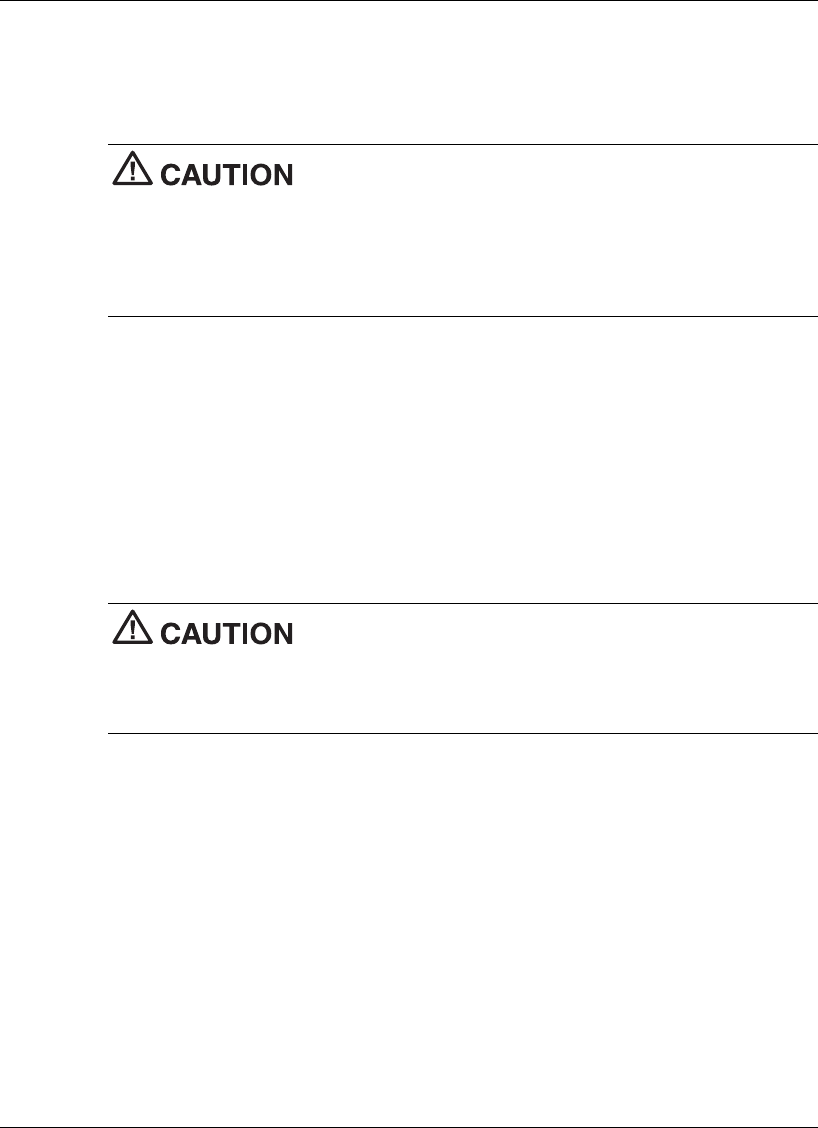
Getting Started 2-15
Storage Requirements
Store the computer and AC adapter in an environment that meets the following
conditions:
If the temperature of the NEC Versa notebook suddenly rises
or falls (for example, when you move the system from a cold place to a warm place)
vapor condenses inside the system. Turning on the system under this condition can
damage the internal system components.
Before turning on the system, wait until the system’s internal temperature equalizes with
the new environment and any internal moisture evaporates.
! Maintain storage temperatures between -4°F and 104°F (-20°C and 40°C).
! Keep the storage area free from vibration and magnetic fields.
! Keep the system and its components away from organic solvents or corrosive gases.
! Avoid leaving the system and its components in direct sunlight or near heat sources.
Routine Cleaning
Clean or dust your system as follows:
Never use harsh solutions, household cleaners, or spray
cleaners that contain caustic materials on the NEC Versa computer.
These cleaners are usually high in alkalinity, which is measured in pH. Using these
cleaners can harm the magnesium surface.
! LCD screen — Carefully wipe the LCD screen with a soft cloth or a screen wipe
designed for that purpose. Special screen wipes are available through your local
computer dealer.
! System case — NEC Computers recommends that you carefully wipe the case with
a slightly damp, almost dry cloth.
3
Using the BIOS Setup Utility
! Introducing BIOS Setup
! Entering BIOS Setup
! Checking/Setting System Parameters
! Managing System Power
! Checking Switch Settings
! Updating the BIOS

3-2 Using the BIOS Setup Utility
Introducing BIOS Setup
Your NEC Versa L320 computer comes with a hardware program called the BIOS
Setup utility that allows you to view and set system parameters. BIOS Setup also
allows you to set password features that protect your system from unauthorized use.
Use BIOS Setup to:
! set the current time and date
! customize your operating system to reflect your computer hardware
! secure your system with a password
! balance your performance needs with power conservation.
Entering BIOS Setup
Access the BIOS utility at power-on. Just press F2 when the following prompt appears.
Press <F2> to Enter BIOS Setup.
When you press F2 to enter BIOS Setup, the system interrupts the Power-On Self-Test
(POST) and displays the current CMOS RAM settings.
If the system detects an error during POST, it prompts you with a double beep and a
message: “Press <F1> to resume.” If you press F1, the system continues past the error
and attempts to load Windows normally. If you want to fix the error, carefully read the
error message that appears above the prompt (taking notes if you want), and press F2.
You will see this message if your CMOS battery becomes fully discharged.
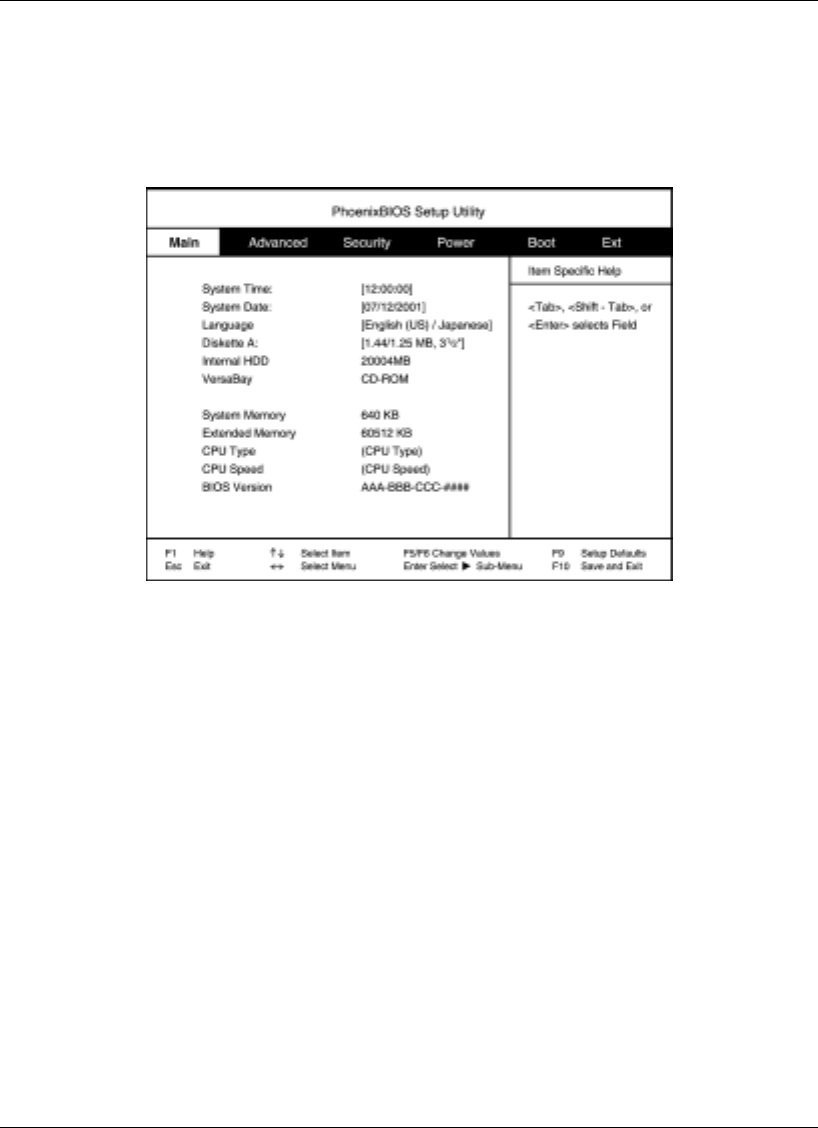
Using the BIOS Setup Utility 3-3
BIOS Setup Main Menu
After you press F2, the system displays the BIOS Setup Main Menu screen, similar to
the following menu.
BIOS Setup Main Menu
Use the up and down arrow keys (located on the lower right corner of the keyboard) to
toggle through the BIOS Setup menu items.
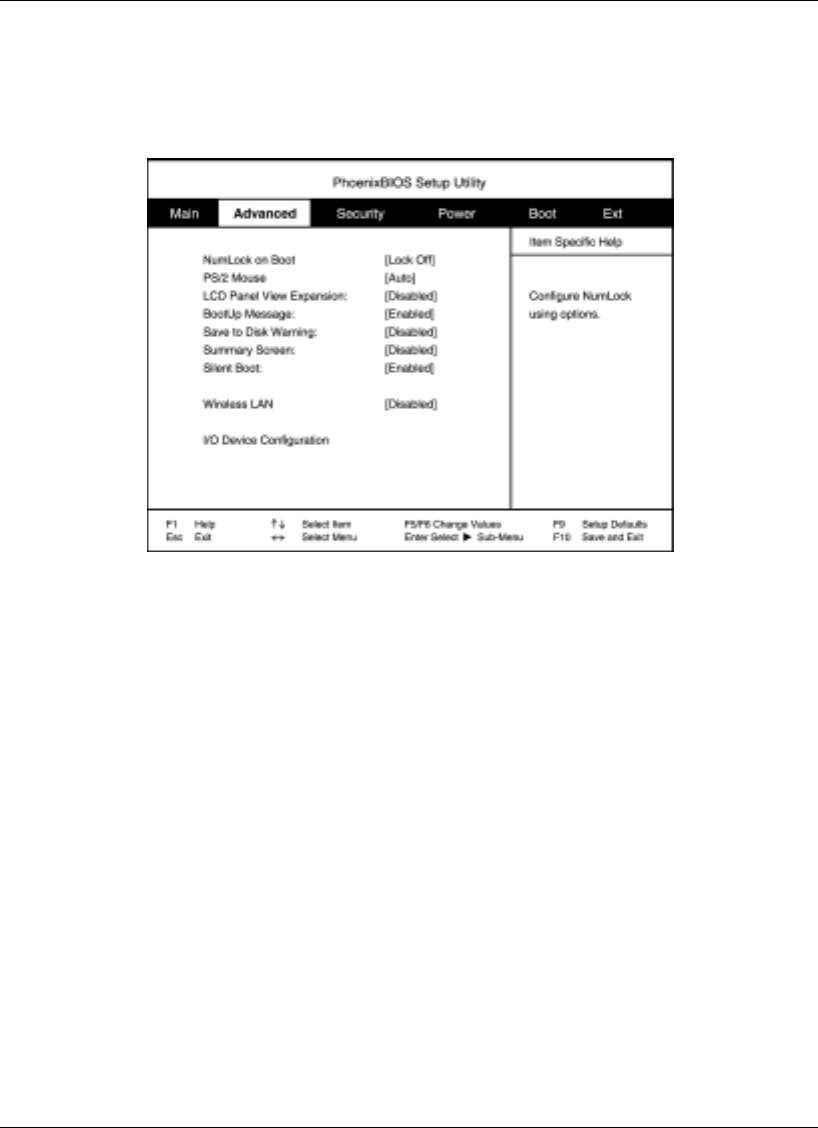
3-4 Using the BIOS Setup Utility
Looking at Screens
BIOS setup screens have three areas as shown next.
Advanced BIOS Setup
! Parameters — The left side of the screen. This area lists parameters and their
current settings.
! Available Options and Help — The right side of the screen. This area lists alternate
settings and Help text for each parameter.
! Key Legend — The bottom right corner of the screen. These lines display the keys
that move the cursor and select parameters.
Options that are grayed out are not available for the current selection.

Using the BIOS Setup Utility 3-5
Using Keys
The following table lists the BIOS Setup keys and their functions.
BIOS Setup Key Functions
Key Function
F1 Displays help.
Esc Exits the current screen and returns to the Main Menu screen. From
the Main Menu screen, displays the prompt, “Quit without saving.”
↑↓ Moves the cursor between the displayed parameters.
←→ Moves the cursor between menu items.
F5/F6 Changes the value for the selected item.
Tab Moves the cursor between the subfields or moves the cursor to the
next line or selection. For example, for System Time, Tab moves the
cursor from hour to minute to second.
Enter Brings up a parameter sub-menu.
F9 Reapplies the factory-shipped defaults.
F10 Saves and exits the BIOS Setup utility.
Checking/Setting System Parameters
The BIOS Setup consists of a number of screens, each representing a specific area of
the BIOS. The following tables list the BIOS parameters, their factory default settings,
alternate settings, and a description of each setting. See the item-specific help that
appears on each Setup screen for more details.
The BIOS Setup utility is broken down as follows:
! Main BIOS Setup
! Advanced CMOS Setup
! Security Setup
! Power Setup
! Boot Setup
! Exit

3-6 Using the BIOS Setup Utility
Resetting System Parameters
To reset all parameters to the default settings, press F9, press the arrow keys to select
Yes, and press Enter.
Main Menu
Use the Main menu to view the System Time, System Date and to modify drive
parameters and related settings.
Main Menu
Parameter Default Setting Alternate Setting(s)
System Time hh:/mm:/ss
System Date mm / dd / yyyy
Language English Japanese
Diskette Drive A 1.44/1.25 MB, 3 ½” Disabled
Internal HDD Auto User Defined, CD/DVD,
None
VersaBay CD/DVD
System Memory (automatically detected)
Extended Memory (automatically detected)
CPU Type (automatically detected)
CPU Speed (automatically detected)
BIOS Version (automatically detected)
! System Time — Sets the time; enter the current hour, minute, and second in
hr:/min:/sec, 24-hour format.
To set the time, use the Tab or arrow keys to move from field to field. Use the
F5/F6 keys to change the numbers within each field.
! Date — Sets your NEC Versa’s calendar month, day and year. The calendar clock is
year 2000-compliant. These settings remain in memory even after you turn off
system power.
To set the date use the Tab or arrow keys to move from field to field. Use the F5/F6
keys to change the numbers within each field.
! Language — Designates the language displayed by the BIOS Setup utility.

Using the BIOS Setup Utility 3-7
! Diskette Drive — Designates the drive type for your diskette drive.
! Internal Drives — Assigns devices to the internal drives in your system.
! VersaBay — Assigns the device to the VersaBay drive in your system.
! System Memory / Extended Memory — Displays the amount of system memory
and extended memory currently installed in your system.
! CPU Type, CPU Speed — Displays the type and speed of the installed processor.
! BIOS version — Displays the version number of the current BIOS Setup utility.
Advanced Menu
Use the Advanced menu to set the following functions.
Advanced Menu
Parameter Default Setting Alternate Setting(s)
NumLock on Boot LockOff LockOn
PS/2 Mouse Auto Both, Disabled
LCD Panel View Expansion Enabled Disabled
BootUp Message Enabled Disabled
Save to Disk Warning Disabled Enabled
Summary Screen Disabled Enabled
Silent Boot Enabled Black, Disabled
Wireless Device Disabled Enabled
I/O Device Configuration [Enter]
! NumLock on Boot — Specifies whether NumLock is enabled when the system
boots.
! PS/2 Mouse — Auto allows the PS/2 mouse to be active if it is detected. Both
allows the NEC VersaGlide touchpad and an external mouse to be active at the
same time. Disabled turns off the internal mouse and prevents an external mouse
from being active. (When set to Disabled, IRQ12 is freed up.)
! LCD Panel View Expansion — Specifies whether the panel view is reduced/off or
expanded/on.

3-8 Using the BIOS Setup Utility
! BootUp Message — Enabled allows a boot message to be displayed while the
system boots.
! Save to Disk Warning — When set to Disabled, no Save-to-Disk warning is
displayed if the SAVE2DSK.BIN file does not exist.
! Summary Screen — When set to Enabled, system configuration information is
displayed on the screen during boot.
! Silent Boot — When set to Enabled, the NEC logo screen is displayed during
system boot. When set to Disabled, the Power-On Self-Test (POST) information is
displayed during system boot. When set to Black, the screen is black until the
system has booted.
! Wireless Device — Enabled allows a Wireless LAN device (if installed) to be used.
Disabled prevents a wireless device from functioning. (This setting only appears on
systems with a Wireless LAN device installed.)
! I/O Device Configuration — Pressing the Enter key brings up a sub-menu with
entries for enabling the serial port, infrared port, parallel port, and the diskette drive
controller. The infrared (IR) port is disabled by default. See “IR Port” in Chapter 6
for information about using the IR port.

Using the BIOS Setup Utility 3-9
Security Menu
Use the Security menu to configure your system for protection against unauthorized
access.
System Security Setup
Parameter Default Setting Alternate Setting(s)
Security Mode Password FingerPrint
Set Supervisor Password Press Enter
Set User Password Press Enter
Set Supervisor FingerPrint Press Enter
Set User FingerPrint Press Enter
Password on Boot Disabled Enabled
Fixed Disk Boot Sector Normal Write Protect
Diskette Access Supervisor User
Assign HDD Password Press Enter
Internal HDD password Disabled Enabled
! Security Mode — Establishes the security method: password protection, FingerPrint
access, or SmartCard access.
! Set Supervisor Password — When Security Mode is set to Password, establishes
password protection for entering the BIOS Setup utility, booting the system, and
resuming from Suspend.
! Set User Password — When Security Mode is set to Password, establishes a user
password once a supervisor password is set. The user password allows the system to
boot and resume from Suspend and Save-to-File.
! Assign Supervisor FingerPrint — Establishes access protection for entering the
BIOS Setup utility, booting the system, and resuming from Suspend.
! Assign User FingerPrint — Establishes user access once supervisor access is set.
The user privileges allows the system to boot and resume from Suspend and Save-
to-File.
! Password on Boot — Establishes whether a password is required to boot the
system.

3-10 Using the BIOS Setup Utility
! Assign HDD Password — Allows you to assign a password to allow or restrict
access to the hard disk drive contents.
! Internal HDD Password — Enables or disables the HDD password.
Password Protection
Your NEC Versa supports a password for system security on several levels. Keep in
mind that you must set the supervisor password before the BIOS Setup utility allows
you to set a user password.
Once you set a supervisor password, you must enter it before you can enter BIOS
Setup, access the system at startup, or resume from Suspend or Save-to-File, depending
on your configuration selection.
Establishing Passwords
To establish password protection for entering the BIOS Setup utility or accessing the
system at startup, you must set the supervisor password before setting a user password.
! To enter a password simply select Set Supervisor Password, press Enter, enter the
password, re-enter the password to confirm, and press any key to continue. Repeat
the procedure to set the user password.
! To initiate password protection while you step away from your system, simply press
Ctrl Alt Backspace simultaneously or place the system into Suspend or Save-to-
File mode. The Caps lock and Scroll lock LEDs alternately flash indicating that you
must enter a password to resume operation.
To establish password protection for resuming from Standby or Hibernation modes you
must do the following:
! Set a Windows password in Control Panel, Password Properties, Change
Passwords.
! Enable the option “Prompt for password when the computer goes off standby” in
Control Panel, Power Management Properties, Advanced.

Using the BIOS Setup Utility 3-11
FingerPrint Protection
Your system also allows you to establish system protection using an external
fingerprint reader.
Your NEC Versa supports FingerPrint protection for system security on several levels.
Keep in mind that you must set up supervisor access before the BIOS Setup utility
allows you to set up user access.
Once you set up supervisor access, you must enter it before you can enter BIOS Setup,
access the system at startup, or resume from Suspend or Save-to-File, depending on
your configuration selection.
Hard Disk Drive Passwords
Your NEC Versa allows you to establish password protection for the internal hard disk
drive. Hard disk drive (HDD) password protection restricts access to the drive, only if
the drive is removed from your NEC Versa and installed in another system. You are not
prompted to enter your hard disk drive passwords while the drive remains in your
current system.
The HDD passwords are written to the system BIOS and to the hard disk drive to
ensure that the password protection travels with the drive when moved from system to
system.
Establishing Hard Disk Drive Passwords
To establish password protection for your system’s hard disk drive you must establish a
master password, establish a user password, and enable the established passwords for
the internal HDD. Follow these steps to establish HDD passwords and to enable HDD
password protection.
1. Enter the BIOS setup, highlight and select the Security Setup.
2. Highlight Assign HDD Password and press Enter.
The system prompts you to enter a master password.
3. Enter a master HDD password and press Enter.
The system prompts you to enter the password again to verify.
4. Enter the master password and press Enter.
The system confirms the creation of the master password and prompts you to enter
a user password.
5. Enter a user password and press Enter.
The system prompts you to enter the password again to verify.
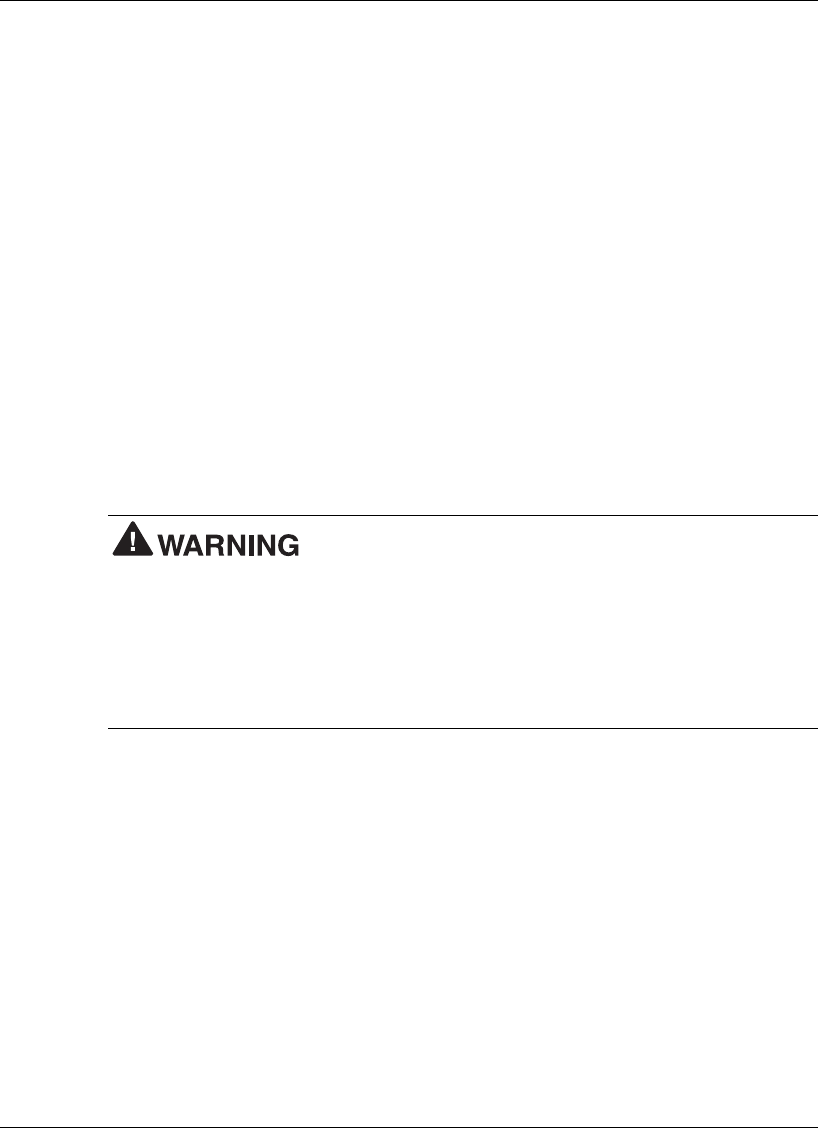
3-12 Using the BIOS Setup Utility
6. Enter the user password and press Enter.
7. Highlight and select Internal HDD Password and use the F5/F6 keys to enable the
selection. (This enables password protection for the internal HDD.)
Changing Hard Disk Drive Passwords
To change hard disk drive passwords, enter the Security Setup, highlight Assign HDD
Password, press Enter, and enter the current password that you wish to change. If you
enter the current master password, you are prompted to enter a new master password. If
you enter the current user password, you are prompted to enter the new user password.
If you do not wish to establish a new master or user password, press Esc instead of
entering a new password.
Using Hard Disk Drive Password Protection
To facilitate the transfer of one or more HDDs between systems, establish a single
master password (and store the password in a secure place). Forgetting your master
password results in the inability to access the data on your hard drive. Establish
different user passwords to limit access to specific systems.
If you set the master and user password on a hard drive,
password security can never be disabled. Passwords can be changed. If the master
password is forgotten and the drive is installed in another system, you cannot access
the data on the hard drive.
If the hard drive is installed in another NEC Versa system with hard disk drive security
enabled, the password must be entered to allow access to the hard drive. If this NEC
Versa system does not support hard disk drive security, you cannot access the
data on the hard drive.
With hard disk drive security enabled on the original NEC Versa system, the system
boots normally.
If the hard drive is installed in another NEC Versa system with security enabled, you
must enter the master password to access the hard disk drive. If the hard drive is
installed in another NEC Versa system with security disabled, the system boots with no
password required.
Moving the Hard Disk Drive
When a password protected HDD is moved from its original system and installed in
another system, error messages appear indicating that the drive is locked. Next, the
Security Setup screen appears requiring the user to enter the master password to unlock
the drive. Highlight the HDD password line and enter the master password when
prompted.

Using the BIOS Setup Utility 3-13
To take advantage of HDD password protection in another system, the system must be
equipped with the same HDD password protection feature. To determine if that system
has HDD password, check the Security Setup in the BIOS Setup to see if there are
provisions for establishing HDD passwords.
Power Menu
Use the Power menu to control some power saving functions in your system.
Note that the Advanced Configuration and Power Interface (ACPI) controls most
power management functions of Versa L320 systems running the Windows 98 SE or
Windows 2000 operating system. In Windows 98 SE, ACPI is configured through the
Power Management Properties dialog box. In Windows 2000, ACPI is controlled
through the Power Options Properties dialog box.
For details about ACPI power management, see the section, “Managing System
Power,” later in this chapter.
See the following information on using the Power menu to balance high performance
and energy conservation in your system.
Power Menu
Parameter Default Setting Alternate Setting(s)
Power Switch On/Off Suspend/Resume
Power Management
Function
Always On Battery Only
Power Savings Level Customized Disabled,
Maximum Power Savings,
Maximum Performance
Suspend Timeout 20 minutes 5, 10, 15, 30, 40, 60 minutes, Off
Suspend Mode Suspend Save-to-Disk
Auto Save-to-Disk Off After 1 Hour
Suspend Warning Tone Enabled Disabled
Intel® SpeedStep2™
technology
Enabled Disabled
Lid Switch Backlight Suspend
Remote Power On Disabled AC Only, AC/Battery
Resume On Modem Ring Off On
Resume On Time Off On
Resume Time [HH:MM:SS]

3-14 Using the BIOS Setup Utility
! Power Switch — Sets the Power button as a power switch (with the On/Off setting)
or a sleep button (with the Suspend/Resume setting).
! Power Management Function — Select Always On to enable power management
while the system is running under either AC power or battery power. Select Battery
Only for power management only while running on battery power.
! Power Savings Level — Specifies one of four levels of power management.
— Maximum Performance — Provides good battery life and best performance with
only minimal power conservation. Use while on the road or traveling short
distances.
— Maximum Power Savings — Provides best battery life, the maximum amount of
power savings, and good performance. Use while traveling long distances.
— Disabled — Disables power management and all device timeouts. Works well in
an office environment while powering your NEC Versa with AC power.
— Customized — Lets you define power management levels and specific device
timeouts according to your own needs and present environment. Custom lets
you set timeouts for CPU speed, hard disk timeout, video timeout, audio device
timeout, Standby timeout, and Auto Suspend timeout.
! Suspend Timeout — Sets the amount of time the system needs to be in Standby
mode before entering Suspend mode.
! Suspend Mode — Specifies either Suspend or Save-to-File as the default power
management mode. For details about using this parameter, see the section,
“Managing System Power,” later in this chapter.
! Auto Save-to-Disk — Enables the system, after one hour in Suspend mode, to save
the current working environment to a special file on the hard disk and to power
down the system.
! Suspend Warning Tone — Specifies whether the system warning tone sounds when
Suspend mode starts. It is best to keep this option enabled.
! Intel® SpeedStep2™ technology — Optimizes CPU performance when the system
is powered under AC and regulates CPU performance when the system is powered
by battery.
! Lid Switch — Selects whether the system goes into a video timeout, or just turns
off the LCD backlight under power management.
! Remote Power On — Select AC Only to prevent the system from being powered on
by a LAN board signal when the system is on battery power. AC/Battery allows
remote power on under battery power.
! Resume On Modem Ring — Determines whether the system can be brought out of
a power-saving state when an incoming call is detected on the modem.

Using the BIOS Setup Utility 3-15
! Resume On Time — When Enabled, brings the system out of a power-saving state
at a specified time.
! Resume Time — Specifies the time at which the system resumes from a power-
saving state (if Resume On Time is set to Enabled).
Boot Menu
Boot menu allows you to define the boot order of system devices or to specify a boot
remotely.
Boot Devices — Boot devices are listed by name, and the order of the names represents
the boot order:
! ATAPI CD-ROM
! Diskette Drive
! Hard Drive.
Network Boot Control — Specifies whether the system can be booted remotely by a
signal to the LAN board.
Exit Menu
The Exit menu provides the following options:
! Exit Saving Changes — Saves the changes you may have made to the BIOS
settings, and exits the BIOS Setup utility.
! Exit Discarding Changes — Clears any changes just made to BIOS settings and
exits the BIOS Setup utility.
! Load Setup Defaults — Resets all BIOS settings to what they were when the system
was shipped from the factory.
! Discard Changes — Discards any changes made to BIOS settings during the current
BIOS Setup utility session.
! Save Changes — Saves any changes made to BIOS settings during the current
BIOS Setup utility session, but does not exit the BIOS Setup utility.
! Refresh Battery — Launches the Refresh Battery utility. Once launched, the utility
fully discharges your battery to eliminate any residual memory effect. Once
refreshed, your battery is conditioned to recharge to its full capacity. To recharge
the battery, connect your NEC Versa to AC power.

3-16 Using the BIOS Setup Utility
Managing System Power
In the Windows® 2000 and Windows® 98 Second Edition (98 SE) operating system
environments, your NEC Versa notebook manages its power resources using the
Advanced Configuration and Power Interface (ACPI) while the system is powered on
using AC or battery (DC) power. ACPI enables the operating system to manage the
power given to each attached device and to turn off a device when not in use.
Take advantage of the opportunity to manage power on your system to:
! Minimize battery drain.
! Preserve the life of your NEC Versa.
! Save time. When you return from that urgent call or meeting, you don’t have to
reboot, just press the Power button to resume system operation.
Windows 2000 Power Options Properties
In Windows 2000, most ACPI power management settings are controlled through
Windows Power Options Properties, not through the BIOS Setup utility. To access
Windows 2000 Power Options Properties, go to Start, Settings, Control Panel, and
double click Power Options.
Power Options Properties features are broken down as follows.
! Power Schemes
! Alarms
! Power Meter
! Advanced
! Hibernate
! Intel SpeedStep technology.

Using the BIOS Setup Utility 3-17
Windows 2000 Power Schemes
Use the Power Schemes options to define the appropriate Power scheme for your
system, and to set timeouts for standby, LCD panel, and hard disk. Define parameters
for your system when running under AC (plugged in) or DC (running on batteries)
power.
Power Schemes
Parameter Default Setting Alternate Setting(s)
Power Schemes Portable/Laptop Home/Office Desk,
Presentation, Always On,
Minimal Power
Management, Max.
Battery
Turn off monitor
(Plugged in)
After 15 Minutes 1, 2, 3, 5, 10, 15, 20, 25,
30, 45 minutes; 1, 2, 3, 4,
5 hours; Never
Turn off monitor
(Running on batteries)
After 5 Minutes 1, 2, 3, 5, 10, 15, 20, 25,
30, 45 minutes; 1, 2, 3, 4,
5 hours; Never
Turn off hard disks
(Plugged in)
After 30 Minutes 3, 5, 10, 15, 20, 25, 30, 45
minutes; 1, 2, 3, 4, 5
hours; Never
Turn off hard disks
(Running on batteries)
After 5 Minutes 3, 5, 10, 15, 20, 25, 30, 45
minutes; 1, 2, 3, 4, 5
hours; Never
System standby
(Plugged in)
After 20 Minutes 1, 2, 3, 5, 10, 15, 20, 25,
30, 45 minutes; 1, 2, 3, 4,
5 hours; Never
System standby
(Running on batteries)
After 5 Minutes 1, 2, 3, 5, 10, 15, 20, 25,
30, 45 minutes; 1, 2, 3, 4,
5 hours; Never
System hibernates
(Plugged in )
After 1 Hour 10, 15, 20, 25, 30, 45
minutes; 1, 2, 3, 4, 5, 6
hours; Never
System hibernates
(Running on batteries)
After 10 minutes 10, 15, 20, 25, 30, 45
minutes; 1, 2, 3, 4, 5, 6
hours; Never

3-18 Using the BIOS Setup Utility
! Power Schemes — Defines the most appropriate power scheme for your computer.
! Turn off monitor — Selects the time delay before your LCD panel turns off.
! Turn off hard disks — Selects the time delay before your hard disk(s) power down.
! System standby — Selects the system standby timeout period for your system when
running under AC or DC power.
! System hibernates — Selects the system hibernate timeout period for your system
when running on AC or DC power.
Windows 2000 Alarms
Use the Alarms screen to define the point at which the battery alarm activates. Define
the alarm to either sound, display a warning message, or invoke Standby, Hibernate, or
Shutdown.
Alarms
Parameter Default Setting Alternate Setting(s)
Low battery alarm 10% 0-100%
Alarm Action Notification Display message Sound alarm
Alarm Action Power Level None Standby, Power Off,
Hibernate
Critical battery alarm 3% 0-100%
Alarm Action Notification Display message Sound alarm
Alarm Action Power Level Standby Power Off, Standby,
Hibernate
Run a program None When the alarm occurs,
run this program.
! Low battery alarm — Allows you to define a low battery alarm percentage,
notification, and system action.
! Critical battery alarm — Allows you to define a critical battery alarm percentage,
notification, and system action.
! Run a program — Allows you to run a specific program when an alarm occurs.

Using the BIOS Setup Utility 3-19
Windows 2000 Power Meter
The Power Meter screen displays the remaining battery power and charging status for
the primary and secondary batteries. Choose to display either a percentage progress bar
or a battery icon with percentage indicator for your battery status information.
Windows 2000 Advanced
The Advanced window allows you to select behaviors for the taskbar icon, standby
password, LCD panel, when closed, and the Power button.
Advanced
Parameter Default Setting Alternate Setting(s)
Always show icon on
taskbar
Unchecked Checked
Prompt for password
when computer goes off
standby
Checked Unchecked
When I close the lid on my
computer
None* Standby, Power Off,
Hibernate
When I press the Power
button on my computer
Power Off Standby, Hibernate
*When None is selected, LCD panel turns off when closed.
! Always show icon on the taskbar — Determines whether or not the Power Meter
icon displays on the taskbar.
! Prompt for password when computer goes off standby — Determines whether or
not the system prompts for your Windows password when resuming from Standby.
! When I close the lid of my computer — Defines the system action when the LCD
panel is closed.
! When I press the Power button on my computer — Defines the system action when
the Power button is used.
Windows 2000 Hibernate
Use the Hibernate window to enable hibernate support, see the amount of free disk
space, and the amount of disk space required to hibernate. When your system
hibernates it performs a save-to-disk. Your current working environment is saved to the
hard disk. Use the Power button to resume from hibernation and your system returns to
its previous state.

3-20 Using the BIOS Setup Utility
Windows 2000 and Intel SpeedStep Technology
Use the Intel SpeedStep technology (available in systems with Intel Pentium III
processors) to optimize processing speed and conserve battery life.
Enable Intel SpeedStep technology through the Power menu (Intel SpeedStep2) in the
BIOS Setup utility. The available settings are Disabled and Enabled. Use Disabled to
turn off Intel SpeedStep2 technology.
If Intel SpeedStep2 technology is enabled in your system, an icon appears on your
taskbar allowing you to adjust processing properties. However, the default settings are
recommended for optimal performance and battery conservation.
For information about accessing the BIOS Setup utility refer to “How to Use Setup”
and “Advanced Menu” earlier in this chapter.
Windows 98 SE Power Management Properties
In Windows 98 SE, most ACPI power management settings are controlled through
Windows Power Management Properties, not through the BIOS Setup utility, unless
otherwise noted. To access Windows 98 SE Power Management Properties, go to Start,
Settings, Control Panel, and double click Power Management.
The Power Management Properties features are broken down as follows:
! Power Schemes
! Alarms
! Power Meter
! Advanced
! Hibernate
! Intel SpeedStep technology.

Using the BIOS Setup Utility 3-21
Windows 98 SE Power Schemes
Use the Power Schemes options to define the appropriate Power scheme for your
system, and to set timeouts for standby, LCD panel, and hard disk. Define parameters
for your system when running under AC (plugged in) or DC (running on batteries)
power.
Power Schemes
Parameter Default Setting Alternate Setting(s)
Power Schemes Portable/Laptop Home/Office Desk,
Always On
Turn off monitor
(Plugged in)
After 15 Minutes 1, 2, 3, 5, 10, 15, 20, 25,
30, 45 minutes; 1, 2, 3, 4,
5 hours; Never
Turn off monitor
(Running on batteries)
After 2 Minutes 1, 2, 3, 5, 10, 15, 20, 25,
30, 45 minutes; 1, 2, 3, 4,
5 hours; Never
Turn off hard disks
(Plugged in)
After 30 Minutes 3, 5, 10, 15, 20, 25, 30, 45
minutes; 1, 2, 3, 4, 5
hours; Never
Turn off hard disks
(Running on batteries)
After 3 Minutes 3, 5, 10, 15, 20, 25, 30, 45
minutes; 1, 2, 3, 4, 5
hours; Never
System standby
(Plugged in)
After 20 Minutes 1, 2, 3, 5, 10, 15, 20, 25,
30, 45 minutes; 1, 2, 3, 4,
5 hours; Never
System standby
(Running on batteries)
After 5 Minutes 1, 2, 3, 5, 10, 15, 20, 25,
30, 45 minutes; 1, 2, 3, 4,
5 hours; Never
! Power Schemes — Defines the most appropriate power scheme for your computer.
! Turn off monitor — Selects the time delay before your LCD panel turns off.
! Turn off hard disks — Selects the time delay before your hard disk(s) power down.
! System standby — Selects the system standby timeout period for your system when
running under AC or DC power.

3-22 Using the BIOS Setup Utility
Windows 98 SE Alarms
Use the Alarms screen to define the point at which the battery alarm activates. Define
the alarm to either sound, display a warning message, or invoke Standby, Hibernate or
Shutdown.
Alarms
Parameter Default Setting Alternate Setting(s)
Low battery alarm 10% 0-100%
Alarm Action Notification Display message Sound alarm
Alarm Action Power Level No action Standby, Hibernate, Shutdown
Critical battery alarm 3% 0-100%
Alarm Action Notification Display message Sound alarm
Alarm Action Power Level Hybernate Standby, Shutdown, No Action
! Low battery alarm — Allows you to define a low battery alarm percentage,
notification, and system action.
! Critical battery alarm — Allows you to define a critical battery alarm percentage,
notification, and system action.
Windows 98 SE Power Meter
The Power Meter screen displays the remaining battery power and charging status for
the primary and secondary batteries. Choose to display either a percentage progress bar
or a battery icon with percentage indicator for your battery status information.

Using the BIOS Setup Utility 3-23
Windows 98 SE Advanced
The Advanced window allows you to select behaviors for the taskbar icon, standby
password, LCD panel, when closed, and the Power button.
Advanced Windows
Parameter Default Setting Alternate Setting(s)
Always show icon on
taskbar
Checked Unchecked
Prompt for password
when computer goes off
standby
Unchecked Checked
When I close the lid on my
computer
None Hibernate, Standby,
Shutdown
When I press the Power
button on my computer
Shutdown Standby, Hibernate
! Always show icon on the taskbar — Determines whether or not the Power Meter
icon displays on the taskbar.
! Prompt for password when computer goes off standby — Determines whether or
not the system prompts for your Windows password when resuming from Standby.
! When I close the lid of my computer — Defines the system action when the LCD
panel is closed.
! When I press the Power button on my computer — Defines the system action when
the Power button is used.
Windows 98 SE Hibernate
Use the Hibernate window to enable hibernate support. When your system hibernates,
it performs a save-to-disk. Your current working environment is saved to the hard disk.
Use the Power button to resume from hibernation and your system returns to its
previous state.

3-24 Using the BIOS Setup Utility
Windows 98 SE and Intel SpeedStep Technology
Use the Intel SpeedStep technology (available in systems with Intel Pentium III
processors) to optimize processing speed and conserve battery life.
Enable Intel SpeedStep technology through the Power menu (Intel SpeedStep2) in the
BIOS Setup utility. The available settings are Disabled and Enabled. Use Disabled to
turn off Intel SpeedStep2 technology.
If Intel SpeedStep2 technology is enabled in your system, an icon appears on your
taskbar allowing you to adjust processing properties. However, the default settings are
recommended for optimal performance and battery conservation.
For information about accessing the BIOS Setup utility refer to “How to Use Setup”
and “Advanced Menu” earlier in this chapter.
Windows Power Management States
ACPI uses different levels or states of power management. These power management
states occur automatically, based on the system’s default settings, or manually, when
invoked. Settings are configurable to occur while on battery power or AC power.
The ACPI power management states in the Windows 2000 and Windows 98 SE
environments include:
! LCD timeout — manages power at the lowest level by shutting down the LCD.
! Standby — also known as Save-to-RAM (STR), Standby manages power by saving
your current working environment to memory and shutting down most system
devices. Conserves more power than an LCD timeout.
! Hibernate — also known as save-to-disk, Hibernate manages power by saving the
current working environment to an area on your hard disk, then powering off your
system. Conserves the most battery power.

Using the BIOS Setup Utility 3-25
Recognizing the Windows Power Management States
It is important to recognize your system’s behavior when in each of these power
management states. The following table describes the system behavior for each power
management state.
Windows Power Management Behavior
LCD Timeout Standby (STR) Hibernate (STF)
Default
Setting
2 Minutes, DC power.
15 Minutes, AC power.
5 Minutes, DC power.
20 minutes, AC power.
On DC power:
15 minutes for
Windows 98SE;
10 minutes for
Windows 2000.
On AC power:
60 minutes for
Windows 2000 and
Windows 98SE
Manually
Invoke
Close LCD panel. Go to Start, Shutdown,
Standby.
Close LCD panel.*
Close LCD panel.*
Press Power button.*
System
behavior
LCD panel is blank.
Status LED lights
green.
LCD panel is blank.
Status LED blinks green.
LCD panel is blank.
Status LED turns off.
Progress bar indicates that
current working
environment is saved to
hard disk.
Resume Press any key. Press Power button. Press Power button.
Progress bar appears
during process.
*Only when set in Advanced Windows Power Management Properties.
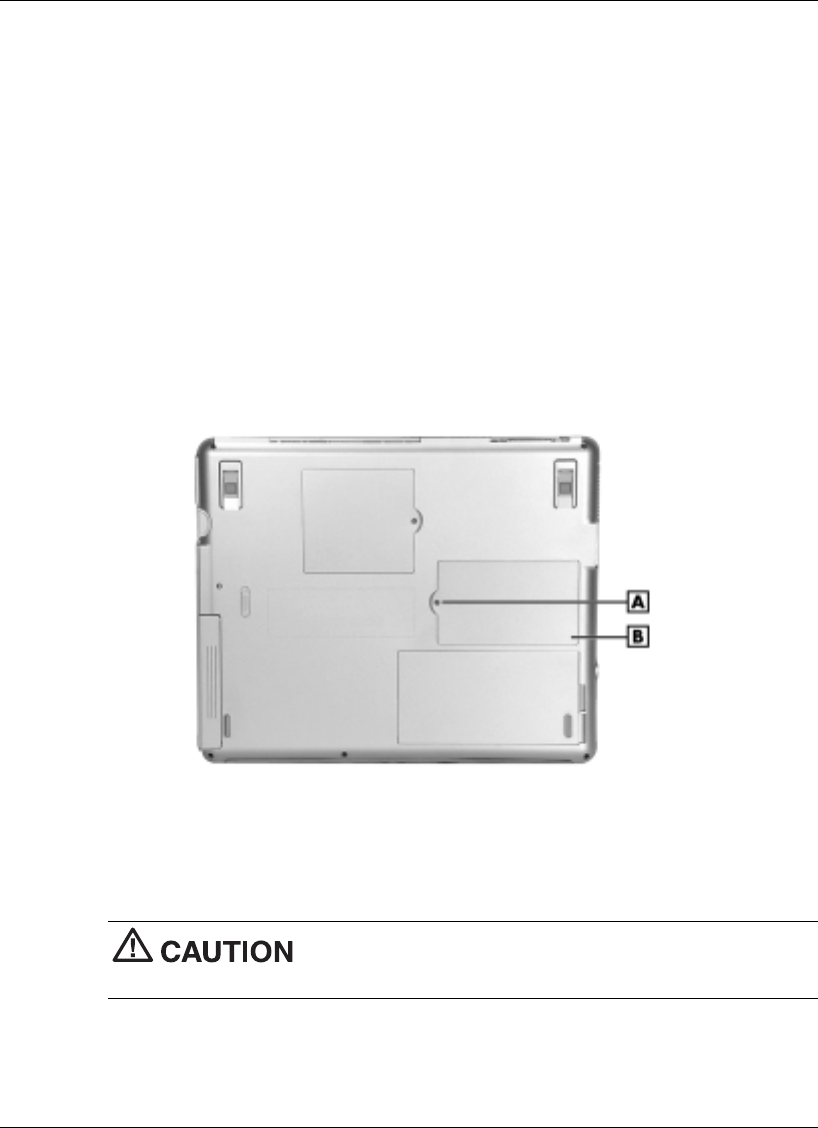
3-26 Using the BIOS Setup Utility
Checking Switch Settings
An eight-position dip switch is located on the bottom of the system in the Mini
PCI/MDC bay. To access the dip switch, follow the procedure in “Accessing
Switches.” For a description of switch settings, see “Looking at Switch Settings.”
Accessing Switches
Follow these steps to access the switches under the Mini PCI/MDC bay.
1. Make sure the system is powered off and that no peripheral devices are attached.
2. Turn over the system and locate the Mini PCI/MDC bay cover.
Locating the Mini PCI/MDC bay cover
A – Screw B –Mini PCI/MDC Bay Cover
3. Remove the screw and bay cover.
Before handling any internal components, discharge static
electricity from yourself and your clothing by touching a nearby unpainted metal surface.
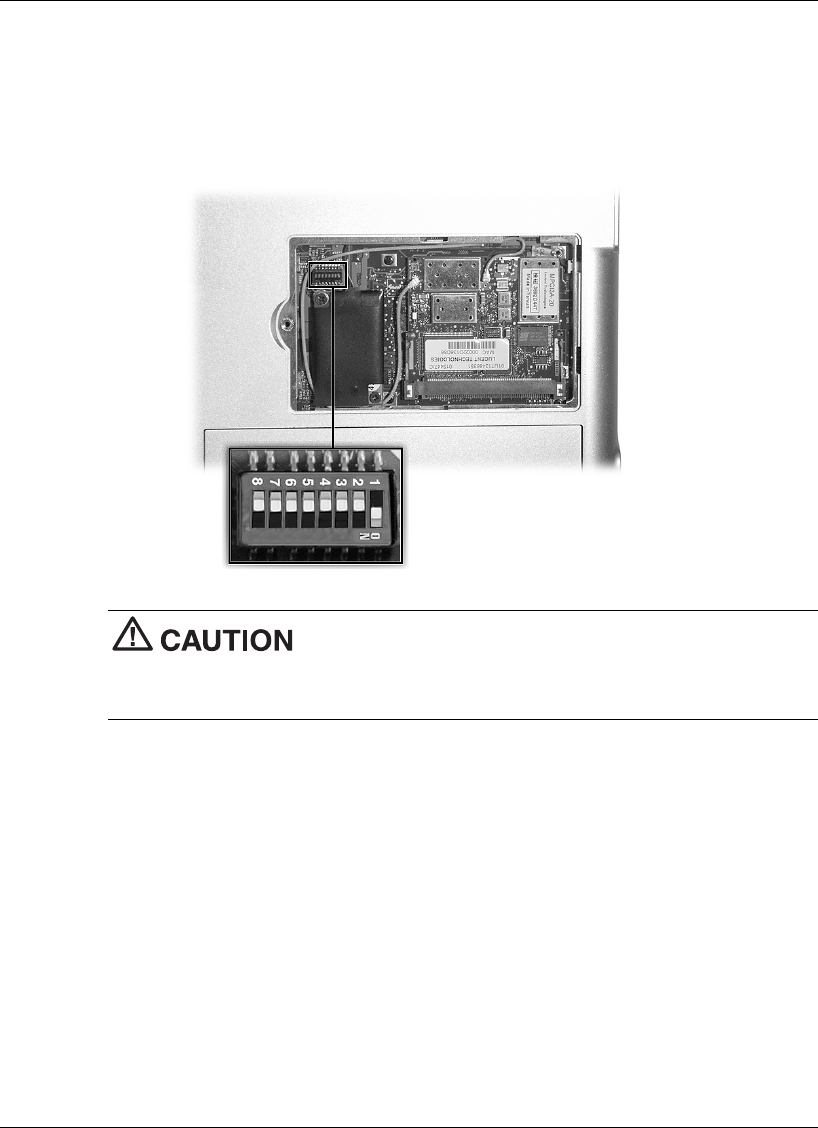
Using the BIOS Setup Utility 3-27
Looking at Switch Settings
The following figure shows the default switch settings. Switch setting descriptions
follow the figure.
Default switch settings
Never use a pencil to change switch settings. Residue from
the pencil can damage the system.
Using a fine-tipped object to gently change a switch setting between “ON” or “OFF.”
! Switch 1, Keyboard Select — The default setting is “ON” for U.S. keyboard.
! Switch 2, Keyboard Select — The default setting is “OFF” for U.S. keyboard.
! Switch 3, Reserved for Factory Use — The default setting is “OFF.”
! Switch 4, Password Override Switch — The default setting is “OFF.” If you forget
your password and cannot access the data on your NEC Versa, change the setting to
“ON” to erase your current password.
! Switch 5, Reserved for Factory Use — The default setting is “OFF.”

3-28 Using the BIOS Setup Utility
! Switch 6, PIN Security mode — The default setting is “OFF.” The system ships
without a Personal Security code, but with the PIN security option enabled. This
means you can boot the system without a PIN if a PIN has yet to be set, or boot the
system with a PIN if the password has been set.
Note If you set a Personal Security code and forget the code, call NEC Computers
Support Services at 1-800-632-4525 for information about how to reset the code.
! Switch 7, Reserved for Factory Use — The default setting is “OFF.” (For U.S.)
! Switch 8, RTC Reset — The default setting is “OFF.”
Updating the BIOS
The BIOS is code transmitted onto your system’s microprocessor, or central processing
unit (CPU). As indicated in this chapter, you use the BIOS Setup utility to configure
your system’s software and hardware features. Only use the BIOS Update Diskette for
your specific model to update your NEC Versa system BIOS.
Note You only need to update the BIOS if NEC Computers makes significant
improvements or fixes to the current system BIOS. Your authorized NEC Computers
dealer or support representative can help you determine this.
To update the system BIOS you must:
! Obtain the BIOS Update
! Prepare the BIOS Update Diskette
! Perform the BIOS Update.
Obtaining the BIOS Update
If you are informed that the default BIOS needs an update, contact NEC Computers
Support Services at 1-800-632-4525 or access the NEC Computers web site,
www.neccomp.com, to obtain a copy of the BIOS update.
Note If you purchased and are using this computer outside the U.S. or Canada,
please contact a local NEC office or dealer in your country.

Using the BIOS Setup Utility 3-29
Preparing the BIOS Update Diskette
Before using the BIOS update diskette, you must make the diskette BIOS flash ready.
Refer to the readme.txt file on the diskette before using the diskette.
Follow these instructions to prepare the BIOS Update Diskette.
1. Scan your hard drive for any computer viruses.
2. Unlock the write protect notch on the diskette, if necessary.
3. Insert the diskette into the diskette drive.
4. Type a:\install (where a: is the diskette drive) at the DOS prompt and follow the
on-screen instructions.
Install.bat copies the DOS system files from your hard drive onto the BIOS Update
Diskette to make it BIOS flash ready.
The system prompts you when the process is complete.
5. Scan the BIOS Update Diskette for computer viruses.
The diskette is ready for use.
Performing the BIOS Update
Make the following preparations before performing the BIOS update. Before you
begin, be sure to:
! Connect the computer to AC power and power off the computer.
! Configure the Boot Device Setup to boot from a floppy diskette.
! Remove any bootable CDs from the VersaBay IV drive.
! Write down what you’ve done to customize your BIOS settings.
Once you have prepared the system for a BIOS update, perform the following steps:
1. Insert the BIOS Update diskette into the diskette drive.
2. Power on the computer with the diskette in the diskette drive. The computer boots
and automatically loads the utility. Read the message that displays and follow the
instructions.
3. Press Enter to continue.
The utility checks the currently installed BIOS version and the diskette’s BIOS
version. The Main menu appears.

3-30 Using the BIOS Setup Utility
4. Use the arrow keys to highlight the “Display BIOS Version” option on the Main
Menu. Use this option to check the currently installed BIOS version and the
version of the new replacement BIOS.
Press any key to return to the Main menu.
5. Highlight the “Install New BIOS” option and press Enter.
6. Press Y and then press Enter. After a brief pause, a message appears telling you to
remove the diskette from the file bay drive.
7. Remove the diskette and press any key to continue. The utility updates the BIOS.
Power off your computer. The next time you power on your computer, you will
have the latest NEC Versa L320 computer BIOS revision level.
8. Power on your computer. A CMOS Checksum message appears and prompts you
to press F2 to enter Setup.
9. Press F2 to enter Setup and restore the default parameter settings.
10. Reconfigure Setup with the custom settings you documented for yourself before
beginning this procedure.
11. Press F10 to save changes and exit Setup.
4
Using the Operating System and Utilities
! Windows Introduction
! NEC Utilities
! SpeedStep Applet
! SoftDVD Player
! NEC CD-RW CD
! Application and Driver CD
! Personal Code Setting Utility
! NEC Info Center
! PartitionMagic
! Product Recovery CD
! One-Touch Start Button Settings Utility

4-2 Using the Operating System and Utilities
Windows Introduction
Your system comes preloaded with the Microsoft® Windows® 98 Second Edition (SE)
operating system or the Windows 2000 operating system configuration.
These Microsoft® operating systems provide a means of running applications,
navigating through your file structure, and using your notebook computer. Each
operating system offers its own look and employs its own tools through an easy-to-use
graphical interface.
Windows 2000
Windows 2000 gives you the newest features offered by Microsoft, including a
Desktop with room to maneuver, taskbar icons for quick access to installed
applications, a system performance and monitoring manager, enhanced entertainment
features, and a fully integrated Internet experience.
Desktop Icons
With Windows 2000, the following icons are installed on your desktop:
! My Computer — Provides access to drives, printers, the control panel, network
features, and scheduled tasks.
! Recycle Bin — Gives you a trash container in which to put and discard unwanted
files or allows you to restore those same files back to their original location.
! My Network Places — When on a network, provides access to network printers and
other computers on your network. Use my network places to browse through the
computers in your workgroup and the computers in the entire network.
! My Documents — Provides you with a convenient place to store documents,
graphics, and other files for quick access.
! Connect to the Internet — Runs the Internet Connection wizard that helps you to set
up your computer to access the Internet.
Note Before connecting to the Internet, you must either connect an optional modem
and a working phone line to your system or install a LAN card for network access.
Your NEC Versa comes with all the software you need to get started on the most
popular services available today. For a fee, online services give you access to the
Internet, email, the world wide web, travel information, news reports, and more.

Using the Operating System and Utilities 4-3
Note Before choosing and registering for an online service, you must connect your
system to a local area network or to a working phone line. The phone line must be
analog. If you are unsure what type of line you have, call your local phone company.
If you are using this product outside the United States or Canada, some online services
may require a long-distance or international call.
! NEC Customize — Gives you the option to launch the Application and Driver CD.
! Internet Explorer — Provides your default Internet program. Also access Internet
Explorer under Start, Programs, Internet Explorer.
Taskbar Icons
With Windows 2000, three icons appear on the taskbar. Use the cursor to hover over
the icon and display its function, right click the icon to display its menu options, or
double click the icon to launch it.
The following icons normally appear on the left side of the Windows 2000 taskbar.
! Internet Explorer — Allows you to browse the Internet or view local HTML files.
Also access Internet Explorer under Start, Programs, Internet Explorer.
! Outlook Express — Provides your default email program with secure and
personalized features for email and newsgroup communication. Also access
Outlook Express under Start, Programs, Outlook Express.
! Show Desktop — Minimizes all active screens to display your desktop.
Windows 98 Second Edition
Windows 98 Second Edition gives you features offered by Microsoft, including a
Desktop with room to maneuver, a taskbar for quick access to a variety of system
functions, state-of-the-art plug and play support, powerful system utilities, enhanced
entertainment features, and a fully integrated Internet experience.
Desktop Icons
With Windows 98 SE, the following icons are installed on your desktop:
! My Computer — Provides access to drives, printers, the control panel, network
features, and scheduled tasks.
! Recycle Bin — Gives you a trash container in which to put and discard unwanted
files or allows you to restore those same files back to their original location.

4-4 Using the Operating System and Utilities
! Setup MSN Internet Access — Provides a setup program that allows you to sign-up
for the Microsoft Network. If you already have an account, use this interface to
sign-on to the Microsoft Network.
! Network Neighborhood — Appears when your computer is connected to a network.
Use the network neighborhood to browse through the computers in your workgroup
and the computers in the entire network.
! My Briefcase — Provides a mechanism for file synchronization between the NEC
Versa and another system.
! My Documents — Provides you with a convenient place to store documents,
graphics, and other files for quick access.
! Connect to the Internet — Runs the Internet Connection wizard that helps you to set
up your computer to access the Internet.
Note Before connecting to the Internet, you must either connect an optional modem
and a working phone line to your system or install a LAN card for network access.
! Online Services — Includes setup icons for a variety of online services.
Your NEC Versa comes with all the software you need to get started on the most
popular services available today. For a fee, online services give you access to the
Internet, email, the world wide web, travel information, news reports, and more.
Note Before choosing and registering for an online service, you must connect your
system to a local area network or to a working phone line. The phone line must be
analog. If you are unsure what type of line you have, call your local phone company.
If you are using this product outside of the United States or Canada, some online
services may require a long-distance or international call.
! NEC Customize — Gives you the option to launch the Application and Driver CD.
! Outlook Express — Provides your default email program with secure and
personalized features for email and newsgroup communication. Also access
Outlook Express under Start, Programs, Outlook Express.
! Internet Explorer — Provides your default Internet program. Also access Internet
Explorer under Start, Programs, Internet Explorer.

Using the Operating System and Utilities 4-5
Taskbar Icons
With Windows 98 SE, a number of icons appear on the taskbar. Use the cursor to hover
over the icon and display its function, right click the icon to display its menu options,
or double click the icon to launch it.
The following icons normally appear on the left side of the Windows 98 SE taskbar.
! Internet Explorer — Allows you to browse the Internet or view local HTML files.
Also access Internet Explorer under Start, Programs, Internet Explorer.
! Outlook Express — Provides your default email program with secure and
personalized features for email and newsgroup communication. Also access
Outlook Express under Start, Programs, Outlook Express.
! Show Desktop — Minimizes all active screens to display your desktop.
The following icons normally appear on the right side of the Windows 98 SE taskbar.
! Task Scheduler — Enables you to schedule tasks, such as Disk Defragmenter, to
run regularly. Also access Task Scheduler under Start, Programs, Accessories,
System Tools, Scheduled Tasks.
! Power Management Properties — Displays your current power source and total
remaining battery power. Access Power Management Properties under Start,
Settings, Control Panel, Power Management.
! NEC VersaGlide — Allows you to adjust your VersaGlide (mouse) properties. Also
access NEC VersaGlide under Start, Settings, Control Panel, Mouse.
! Volume Control — Adjusts the volume and speaker balance when you play audio
files. Also access Volume Control under Start, Programs, Accessories,
Entertainment, Volume Control.
! Time/Clock — Allows you to adjust the time and date, rearrange active windows on
your desktop, create a new toolbar or customize your existing toolbar.
For more information about the desktop and taskbar icons, refer to the Windows 98 SE
online help.

4-6 Using the Operating System and Utilities
NEC Utilities
NEC Computers provides several programs and routines designed to make your NEC
Versa notebook run more efficiently.
The NEC utilities include:
! NEC Customize utility
! PHDISK utility (Windows 98 SE).
NEC Customize Utility
The NEC Customize utility gives you the option to install or launch the:
! Application and Driver CD — Use this option to install a variety of software
applications, drivers, utilities, internet browsers, and the NEC Info Center.
! Phoenix® BaySwap utility — Use this utility to configure your system so you can
hot or warm swap your VersaBay IV devices or Modular Bay devices. If the
Phoenix BaySwap utility is not already installed on your system, install it using the
NEC Customize utility.
NEC Customize Utility Screen
The NEC Customize utility screen consists of the following.
! A window at the top half of the screen lists the available options.
! The window below the options list displays a description of each option when the
option is highlighted.
! The Launch button initiates a selected option when clicked.
! The More Info button provides an overview of the NEC Customize utility.
! The Exit button closes the NEC Customize utility.
Using the NEC Customize Utility
Follow these steps to use the NEC Customize utility.
1. Double click the NEC Customize icon.
2. From the display window, select the desired option.
3. Click Launch or Install to initiate the selected option.
4. Follow the on-screen instructions to process the selected option.
For some of the selected options you are prompted to reboot your system.
5. If necessary, click Exit to close the NEC Customize dialog box.
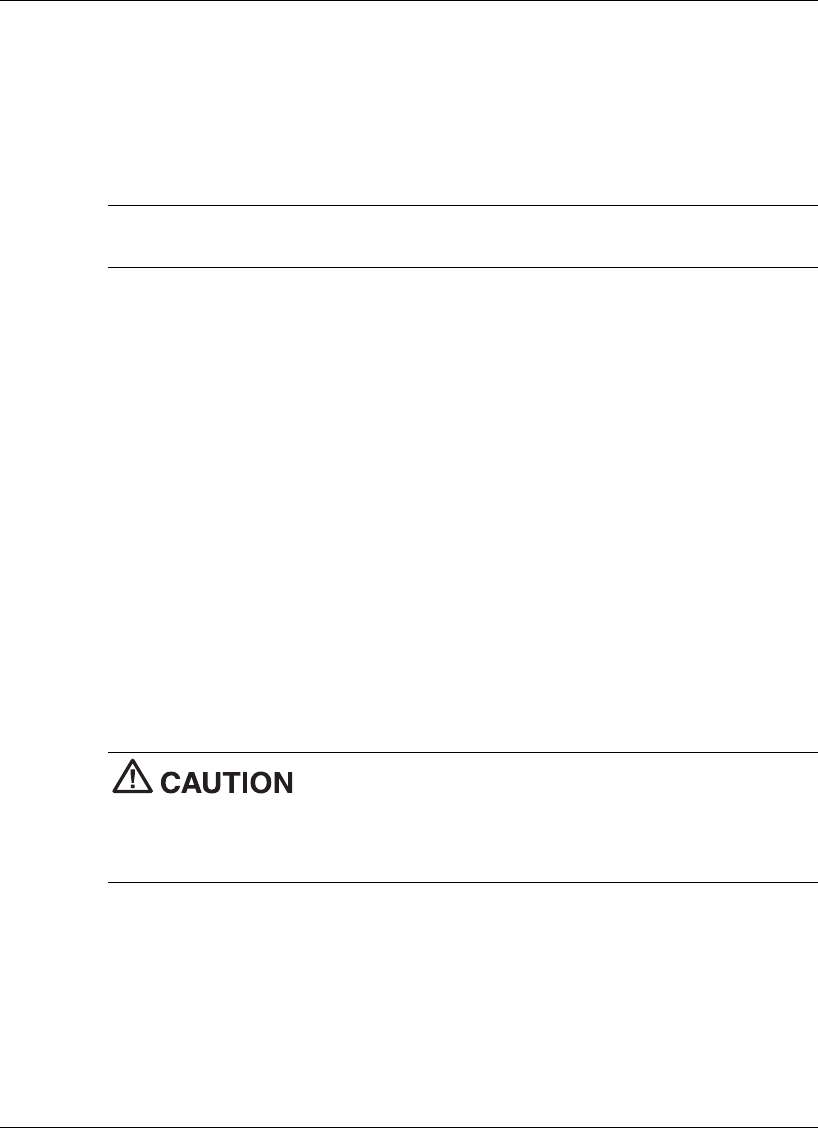
Using the Operating System and Utilities 4-7
PHDISK Utility for Windows 98 SE
The PHDISK utility for Windows 98 SE configures your NEC Versa system’s save-to-
file (STF) area on the hard disk drive. This allows you to use your system’s power
management features to automatically save open files when your system hibernates.
To set up PHDISK use the information in the following sections.
Note For more details about the PHDISK utility, see the ReadMe.txt file in the
necutils\phdisk directory.
Preparing Your System for the PHDISK Utility
Before running the PHDISK utility, verify that:
! All appropriate drivers have been installed from the NEC Application and
Driver CD.
(For information about installing all appropriate drivers displayed in the Drivers
Table Interface on the NEC Application and Driver CD, see “Application and
Driver CD” in this chapter.)
! No devices listed under Device Manager are flagged with a yellow exclamation
point.
(To check the Device Manager, click Start and click Control Panel. Double click the
System icon and click the Device Manager tab. Check each device listing,
expanding the sub-items if necessary, to be sure no devices are tagged with yellow
exclamation points.)
If these two conditions are not met before you install the PHDISK utility, Hibernate
will not work correctly, and your hard drive may become corrupted.
Before running the PHDISK utility, verify that all appropriate
drivers have been installed, and that no device listed in Device Manager is flagged with
a yellow exclamation point.
If not, Hibernate does not work correctly, and your hard drive may become corrupted.
Running the PHDISK Utility
Follow these steps to run the PHDISK utility.
1. With system power on, insert the NEC Application and Driver CD in the CD-ROM
or DVD-ROM drive. For more information on using the Application and Driver
CD, see “Application and Driver CD” in this chapter.

4-8 Using the Operating System and Utilities
2. Select the PHDISK utility for installation. Follow the prompts to install the
appropriate files on your hard drive.
3. Once the files have been installed, exit the Application and Driver CD interface
and remove the CD.
4. Restart your system in MS-DOS mode by pressing Start and clicking Shutdown.
Select ‘Restart in MS-DOS mode’ and click OK.
5. At the MS-DOS prompt, type cd \necutils\phdisk and press Enter to change to the
\necutils\phdisk directory.
6. Type phdisk and press Enter. The PHDISK utility interface appears with the
following valid options:
1. Create Partition
2. Create File
3. Reboot
4. Exit
7. Enter 2 and press Enter. (Be careful not to select Create Partition.) A prompt
similar to the following appears:
Please input size (Minimal: 74179) KB:
(The minimal size varies according to the amount of system memory installed in
your system.)
8. Press Enter to accept the minimal size. A file large enough to accommodate your
system’s memory is created on the hard disk drive, and the PHDISK utility
interface appears again.
9. Enter 3 (for Reboot) and press Enter.
10. If necessary, press any keyboard key when prompted to reboot the system.
11. When Windows 98 SE has restarted, click Start, click Settings, and click Control
Panel. Double click the Power Management icon.
12. Click the Hibernate tab. Put a check in the box next to Enable hibernate support
and click Apply.
13. Select the Advanced Tab. The following settings now provide Hibernate as a
choice in their pull-down menus.
! When I close the lid of my portable computer
! When I press the power button on my computer
14. Select Hibernate for either or both of these settings (if desired). Click OK to close
the Power Management Properties window.

Using the Operating System and Utilities 4-9
Applet for Intel SpeedStep2 Technology
The processors that ship with the NEC Versa L320 notebook computer include the Intel
SpeedStep2 technology. Intel SpeedStep2 technology allows you to customize
performance of your NEC Versa notebook, optimizing performance when your system
is running under AC power, and conserving battery life when your system is running on
battery power.
If your processor is equipped with Intel SpeedStep2 technology, an icon appears on
your taskbar allowing you to adjust processing properties. However, the default settings
are recommended for optimal performance and battery conservation.
For more information about configuring settings for Intel SpeedStep2 technology, see
the sections in Chapter 3 that are specific to the operating system you use. For
information about accessing the BIOS Setup utility refer to “Entering BIOS Setup” and
“Advanced Menu” in Chapter 3.
SoftDVD Player CD
If your system comes with a DVD-ROM drive preinstalled, you have the SoftDVD
Player CD. The SoftDVD Player is software that allows you to play DVD videos on
your computer, and lets you control the DVD-ROM drive with onscreen controls.
The materials that come with the CD describe how to install and use your software, and
onscreen prompts provide guidelines during the installation. Once the software is
installed, access the onscreen SoftDVD help for more information about using and
configuring your DVD-ROM drive.
NEC CD-RW CD
If your NEC Versa system comes with a CD-RW drive preinstalled, you have the
NEC CD-RW CD. The CD-RW drive lets you load and start programs from a CD and
write information to a CD. The NEC CD-RW CD provides a driver, CDINIT, and two
applications, Easy CD Creator and DirectCD.
The materials that come with the CD describe how to install and use your software, and
onscreen prompts provide guidelines during the installation. Once the software is
installed, access the on-screen help for more information about using and configuring
your CD-RW drive.

4-10 Using the Operating System and Utilities
Application and Driver CD
A variety of software applications, drivers, utilities, Internet browsers and the NEC Info
Center are provided on the Application and Driver (A&D) CD that ships with your
NEC Versa L320 system. Some of the drivers are already installed as part of your
operating system environment. The additional software on the A&D CD lets you take
full advantage of your system resources.
Use the Application and Driver CD to install the software of your choice. Some
software applications install their own desktop icon allowing quick access to the
application. You can also access some applications through the Start, Programs menu.
Launching the A&D CD with Windows 2000
Follow these procedures to launch the Application and Driver CD using NEC
Customize with Windows 2000.
1. Insert the Application and Driver CD into the CD-ROM drive.
2. Double click the NEC Customize icon.
3. Select Application and Driver CD.
4. Click Install to launch the CD.
The Application and Driver CD dialog box appears.
Note If the NEC Customize icon is not available, double click My Computer on the
desktop and then click the CD icon. The Application and Driver CD dialog box appears.
Launching the A&D CD with Windows 98 SE
Follow these procedures to launch the Application and Driver CD using NEC
Customize with Windows 98 SE.
1. Insert the Application and Driver CD into the CD-ROM drive. If the CD does not
auto-run, perform steps 2 through 4.
2. Double click the NEC Customize icon, if necessary.
3. Highlight Launch Application and Driver CD.
4. Click Install to launch the CD.
The Application and Driver CD dialog box appears.

Using the Operating System and Utilities 4-11
Note If the NEC Customize icon is not available, double click My Computer on the
desktop and then click the CD icon. The Application and Driver CD dialog box appears.
Application and Driver CD Dialog Box
The Application and Driver CD dialog box consists of the following components.
! Selection Tabs — Located just below the title bar, each tab represents a software
category. The selection tabs include applications, drivers, utilities, internet
browsers, and the NEC Online Documentation.
! Description — Located in the bottom portion of the dialog box, the text describes
the selected or highlighted software category or application, driver, etc.
! Install — Clicking the Install button installs the selected software.
! View — Clicking the View button displays installation instructions for those
utilities that are not installed using the A&D CD utility.
! Exit — Clicking the Exit button closes the Application and Driver CD dialog box.
Installing the A&D CD Software
Once the Application and Driver CD dialog box appears, follow these steps to install
the desired software.
1. Click the selection tab of your choice.
2. Click the desired application, driver, or utility.
3. Click the Install button to install your selection.
Follow the on-screen instructions to install your selection.
4. Click Exit to close the Application and Driver CD dialog box.
5. Remove the CD from the CD-ROM drive when the installation is complete.
Personal Code Setting Utility
Use the Personal Code Setting utility along with the personal code buttons on the
NEC Versa L320 (available on some systems) to set a personal code and secure the
system. Once the personal code is set, the system will not boot until you enter the
personal code.
The personal code must also be entered if the system goes into a power-saving state.
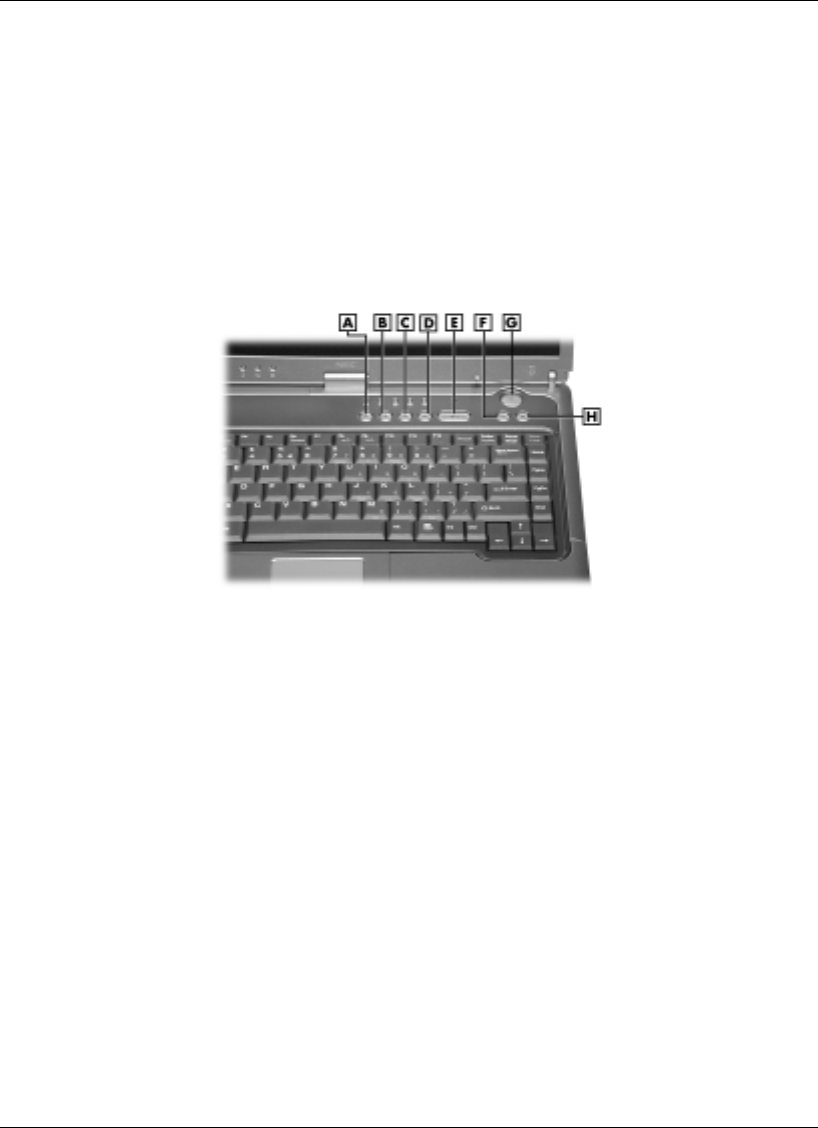
4-12 Using the Operating System and Utilities
See the following sections for procedures on establishing personal codes, clearing a
personal code, using a personal code to access the system, and using a personal code to
bring the system out of a power-saving state.
Identifying Personal Code Setting Buttons
The following figure shows the locations of the Personal Code Setting buttons on the
system. (Not all systems come with Personal Code Setting buttons.)
Locating Personal Code Setting buttons
A – Personal Code Button 1 E – Personal Code Enter Button
B – Personal Code Button 2 F – Shortcut Button
C – Personal Code Button 3 G – Power Button
D – Personal Code Button 4 H – Shortcut Button
Establishing Personal Codes
The Personal Code Setting utility can store a Supervisor personal code, and up to two
User personal codes. Follow these steps to establish a personal code.
1. Prepare to set the personal code:
! To set a User personal code for the first time, press the 1 button and the Enter
button at the same time and hold both down for at least 5 seconds.
! To set a Supervisor personal code for the first time, press the 2 button and the
Enter button the same time and hold both down for at least 5 seconds.
When the system is in Personal Code Input mode, the LED flashes.

Using the Operating System and Utilities 4-13
2. Enter up to 5 button strokes for the password. Multiple buttons held down at the
same time represent a unique entry, independent of individual button strokes.
3. Press the Enter button to set the password.
Note The personal code can be up to 5 button strokes. Multiple buttons held down
at the same time represent a unique entry (independent of individual button strokes) —
allowing close to 800,000 personal code combinations.
Clearing a Personal Code
Follow these steps to clear a personal code.
! To clear a User personal code:
— Log on as the User with the personal code you want to change.
— Press the 3 button and the Enter button at the same time and hold both down
for at least 5 seconds.
— Enter the personal code to be cleared and press the Enter button.
Note A User personal code can be cleared by the Supervisor, without the
Supervisor knowing the User personal code.
! To clear a Supervisor personal code:
— Log on as the Supervisor.
— Press the 4 button and the Enter button at the same time and hold both down
for at least 5 seconds.
— Enter the personal code to be cleared and press the Enter button.
! To set a new personal code, see “Establishing a Personal Code.”
When the Supervisor or User personal code is being cleared or reset, the Security LED
flashes.
Note If you forget your password (personal code), contact NEC Computers Support
Services for information about clearing it. See Chapter 11, “Getting Service and
Support,” for contact information.

4-14 Using the Operating System and Utilities
Using the Personal Code to Access the System
Once you set one or more personal codes on the system, you must enter one of these
personal codes before the system can finish booting up.
After the system has been turned on, but before it boots, the Personal Code Security
LED lights. Enter the personal code and press the Enter button.
When a valid personal code is entered, the LED goes out and the system finishes
booting up.
An alarm sounds for one minute if there are three unsuccessful attempts at entering the
personal code. It is still possible to enter the correct personal code while the alarm is
sounding, but after the alarm stops, the system goes into a Suspend state.
You can attempt personal code entry again. See “Bringing the System Out of a Power-
Saving Mode.”
Bringing the System Out of a Power Saving Mode
If the system goes into a power-saving state after bootup, the Security LED remains
off. In this state, the Personal Security Code utility goes into security mode. The utility
requires the entry of a valid personal code before the system can come out of the
power-saving state.
Note If you forget your password (personal code), contact NEC Computers Support
Services for information about clearing it. See Chapter 11, “Getting Service and
Support,” for contact information.
NEC Info Center
The Application and Driver CD contains the NEC Info Center, a fully navigational
online document that provides information for the traveling professional and an online
version of portions of the printed user’s guide.
Installing the NEC Info Center
To install the NEC Info Center simply follow the instructions, presented earlier in this
chapter, for launching the Application and Driver CD and installing the software. For
the most current version of the NEC Versa L320 User’s Guide, periodically check the
NEC Computers web site at www.neccomp.com.

Using the Operating System and Utilities 4-15
Uninstalling the NEC Info Center
Use the Windows Add/Remove Programs or the Wise uninstall feature to uninstall the
NEC Info Center.
To uninstall the NEC Info Center using the Windows Add/Remove Programs feature,
follow these steps:
1. Go to Start, Settings, Control Panel, and double click Add/Remove Programs.
2. Use the scroll bar, if necessary, to display the NEC Info Center item.
3. Highlight NEC Info Center and click the Add/Remove button.
4. Select Automatic as the uninstall method and click Next.
5. Click Finish to complete the uninstall.
6. When the uninstall is complete, click OK and close the Control Panel window.
To uninstall the NEC Info Center using the Wise uninstall feature, access the C:\NEC
INFO directory on your hard disk drive. Double click the unwise.exe file or icon to
remove all files and directories associated with the NEC Info Center.
PartitionMagic Special Edition
Dividing the hard disk drive into several partitions lets you efficiently organize
operating systems, programs, and data. PartitionMagic® Special Edition, included on
the Application and Driver CD that ships with your system, allows you to optimize
hard disk drive space with an easy click of the mouse. Visually create, format, shrink,
expand, and move hard disk partitions in minutes.
Note PartitionMagic Special Edition is for use with Windows 98 and Windows NT
operating systems. Windows 2000 operating systems do not support PartitionMagic.
Your NEC Versa notebook ships with an internal hard disk drive consisting of a single
FAT 32 partition, drive C:. Use PartitionMagic Special Edition if you want to create
multiple partitions and convert your hard disk drive to FAT 16 partitions.
Note PartitionMagic Special Edition software differs from the full-featured version
and does not include all program functionality or user manuals.
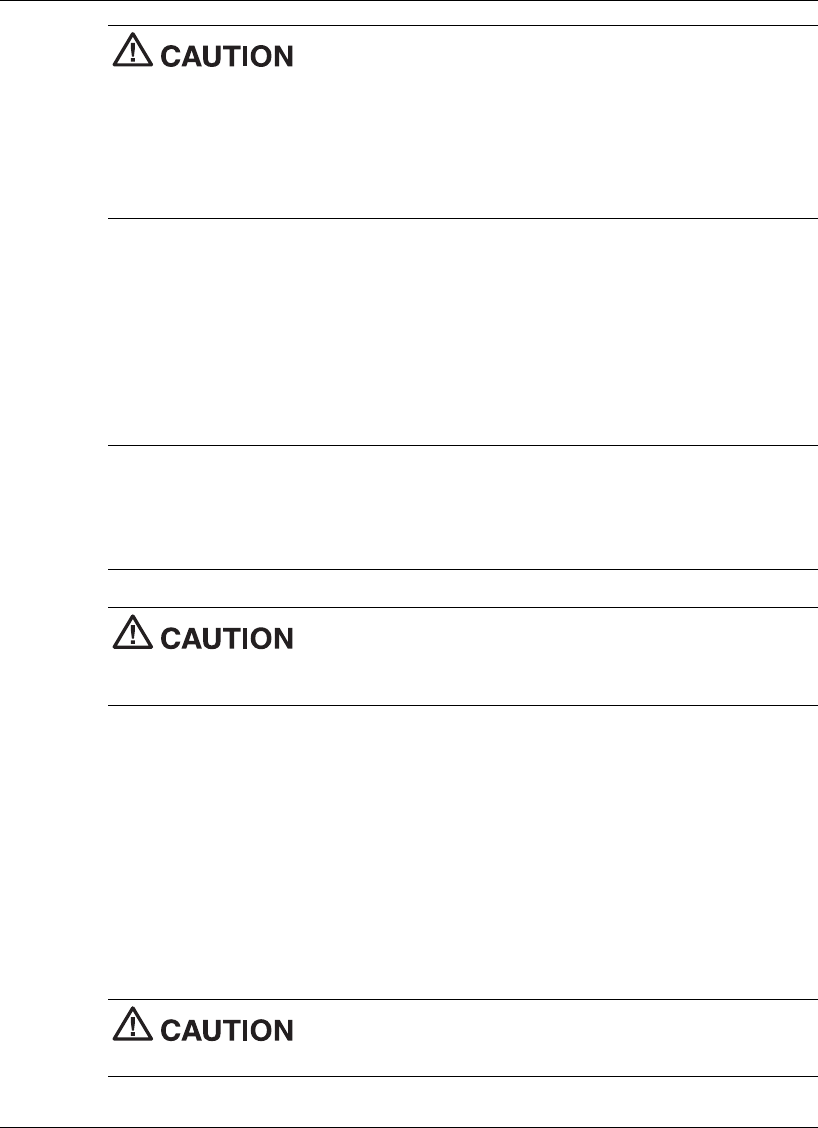
4-16 Using the Operating System and Utilities
Before using PartitionMagic Special Edition, refer to the
associated cautionary notes on the Application and Driver CD. The cautionary notes
contain important information about designating the partitions on the hard disk drive.
The partitions must be properly designated before using the Product Recovery CD to
reinstall your operating system. If the partitions on the hard disk drive are not properly
designated, it will appear as though data loss has occurred after using the Product
Recovery CD.
Product Recovery CD
The Product Recovery CD contains Error! Bookmark not defined.the NEC Product
Recovery utility that allows you to restore your system to its initial installation state.
If you determine that you need to restore your system to its initial installation state, use
the instructions that follow.
Note Only use the Product Recovery utility to restore your system to its initial
installation state as a last resort. Check the problem checklist in Chapter 10 for
information about solving problems before using the CD. The Product Recovery utility
provides options that either remove or replace existing files, a process that may result in
data loss.
Before using the Product Recovery CD, enter the BIOS Setup
utility and restore the BIOS default settings. Save the default settings before exiting the
BIOS Setup utility.
Guidelines for Using the Product Recovery CD
Follow these guidelines when using the Product Recovery CD.
! Use AC power.
! Remove all optional hardware such as PC Cards, USB devices, printers, and
monitors.
! Carefully review the Product Recovery CD options in the next section before
proceeding.
Choose your restore option carefully to prevent losing data and
applications installed on your system.
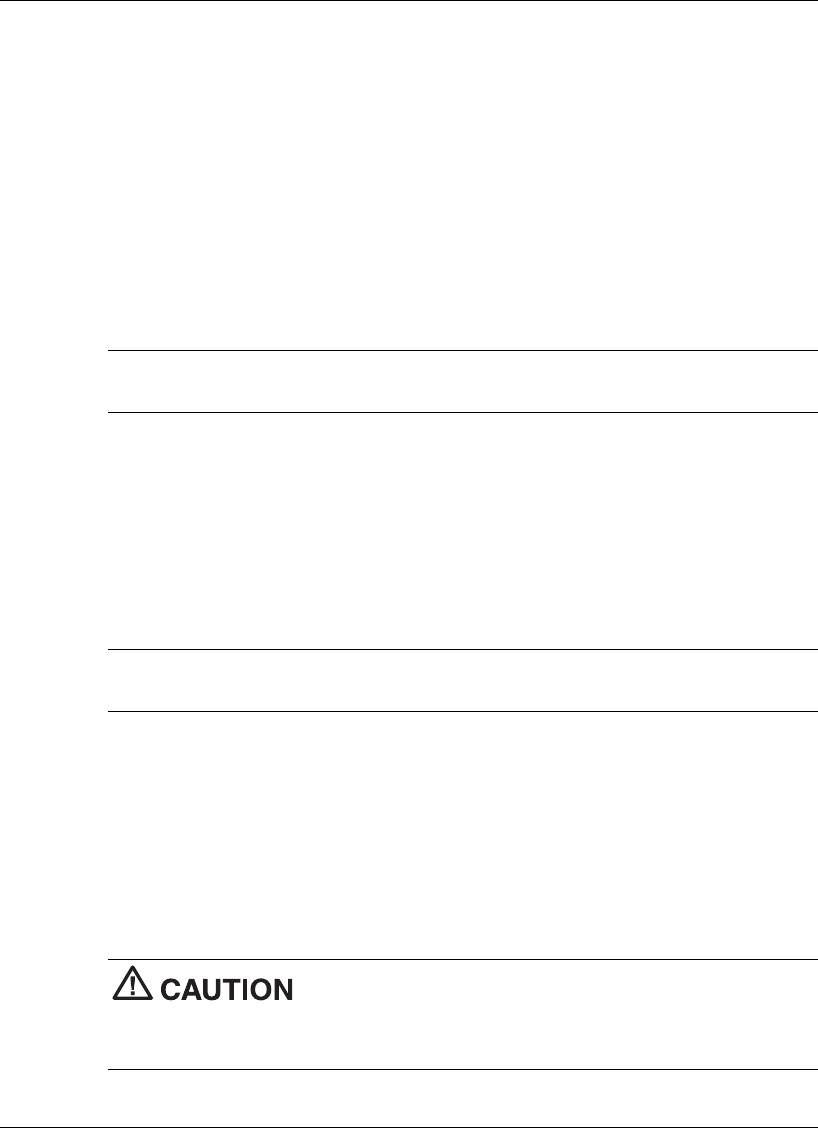
Using the Operating System and Utilities 4-17
Product Recovery CD Options
The Product Recovery CD and utility provides you with a number of choices. Move the
cursor over each selection on the NEC Product Recovery utility screen to display a
description of the selection in the window at the right side of the screen.
! Restore System — Select this option if you wish to restore your hard disk drive to
its initial installation state. Restore System allows you to restore your system in one
of the following ways.
— Full Disk Drive
Completely rebuilds your hard disk drive, destroying all existing data in the
process.
Note Use the Full Disk Drive restore option if your hard disk consists of one
partition (drive).
— Partition Only
Lets you preserve your existing hard disk drive partition structure and format
only the primary partition without affecting the extended partition(s). Partition
Only formats drive C: (of a multiple partitioned drive) and restores drive C: to
its initial installation state. To use the Partition Only option, drive C: must be
equal to or greater than 1 GB. Additional partitions, for example, drives D:, E:,
etc., remain intact. For important information about partitioning your hard disk
drive, see the section, “PartitionMagic Special Edition,” earlier in this chapter.
Note Use the Partition Only restore option if your hard disk is partitioned into two or
more partitions (drives).
! Exit — Exits the NEC Product Recovery utility.
Full Disk Drive Restore
If your preinstalled software becomes unusable and you cannot boot from the hard disk,
use the Product Recovery utility to restore your system to its initial shipping
configuration. The Full Disk Drive restore option erases the hard disk completely
before reinstalling the files.
The Full Disk Drive restore option deletes all files on the hard
drive and replaces them with the original factory installed files.
Only use the Full Disk Drive restore option if the preinstalled software is unusable.
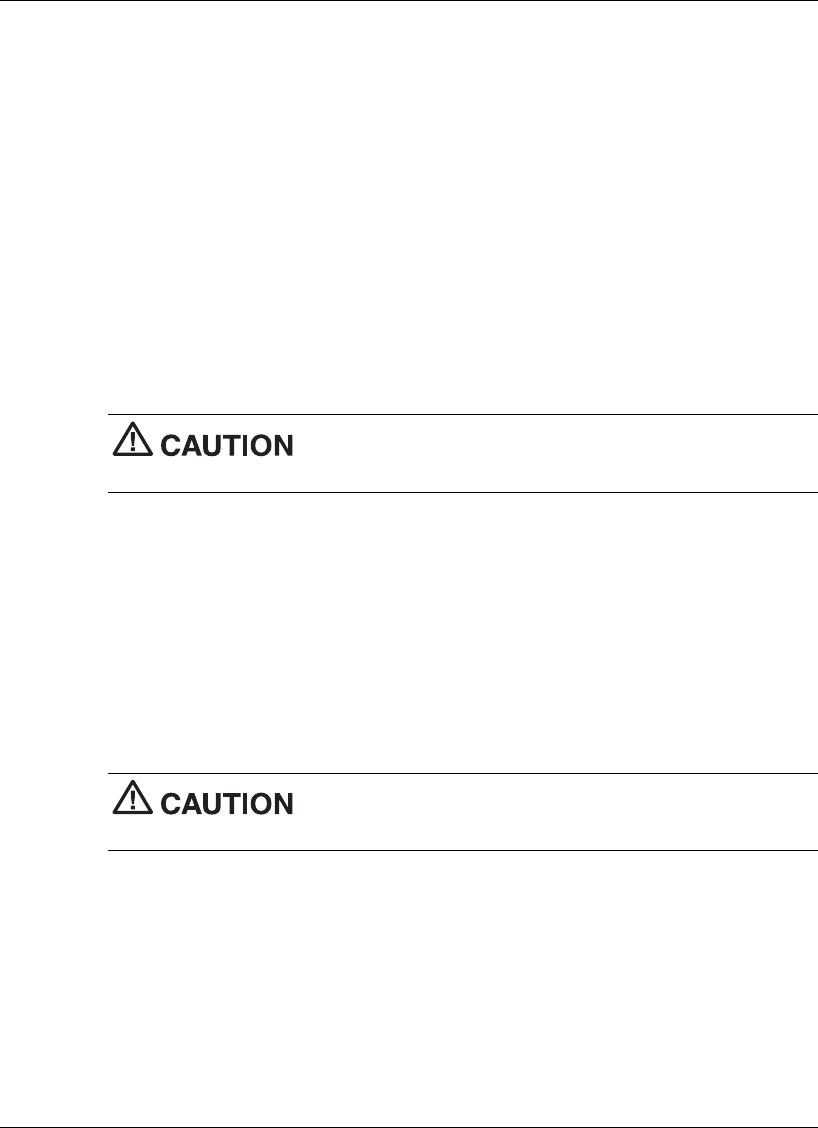
4-18 Using the Operating System and Utilities
Use the Product Recovery utility to perform a Full Disk Drive restore as follows.
1. Check the Product Recovery CD title and make sure that it is the correct CD for
your NEC Versa computer and operating system.
2. Put the CD into the CD-ROM drive tray, close the drive door, and reboot your
system.
3. Read the License Agreement screen that appears. Use the VersaGlide touchpad to
position the cursor on the Accept button. Left click to accept the agreement.
You have the option of accepting or declining the agreement. If you decline the
agreement, the recovery utility exits.
4. In the NEC Product Recovery utility screen, use the VersaGlide touchpad to
choose Full Disk Drive to restore your hard disk drive to its original factory
installed state.
Choose your restore option carefully to prevent losing data and
applications installed on your system.
5. Read the Warning screen.
A warning displays indicating that your hard disk is about to be erased.
6. Select Continue to proceed to perform a Full Disk Drive restore.
If you select Back, the recovery utility returns to the prior screen, which has an exit
option.
If you select Continue, a screen with progress bars displays and lets you know the
progress of the recovery.
Do not turn off or disturb the system during the recovery
process.
7. When the recovery process is complete, you are prompted to remove the CD from
the CD-ROM drive and reboot your system.
8. Press Enter, click Reboot, or press Alt-R to reboot your system.
A series of hardware detection screens display, the system reboots and the
Windows Setup screen appears. Follow the on-screen instructions to set up
Windows.
You are required to reenter your Microsoft license number.
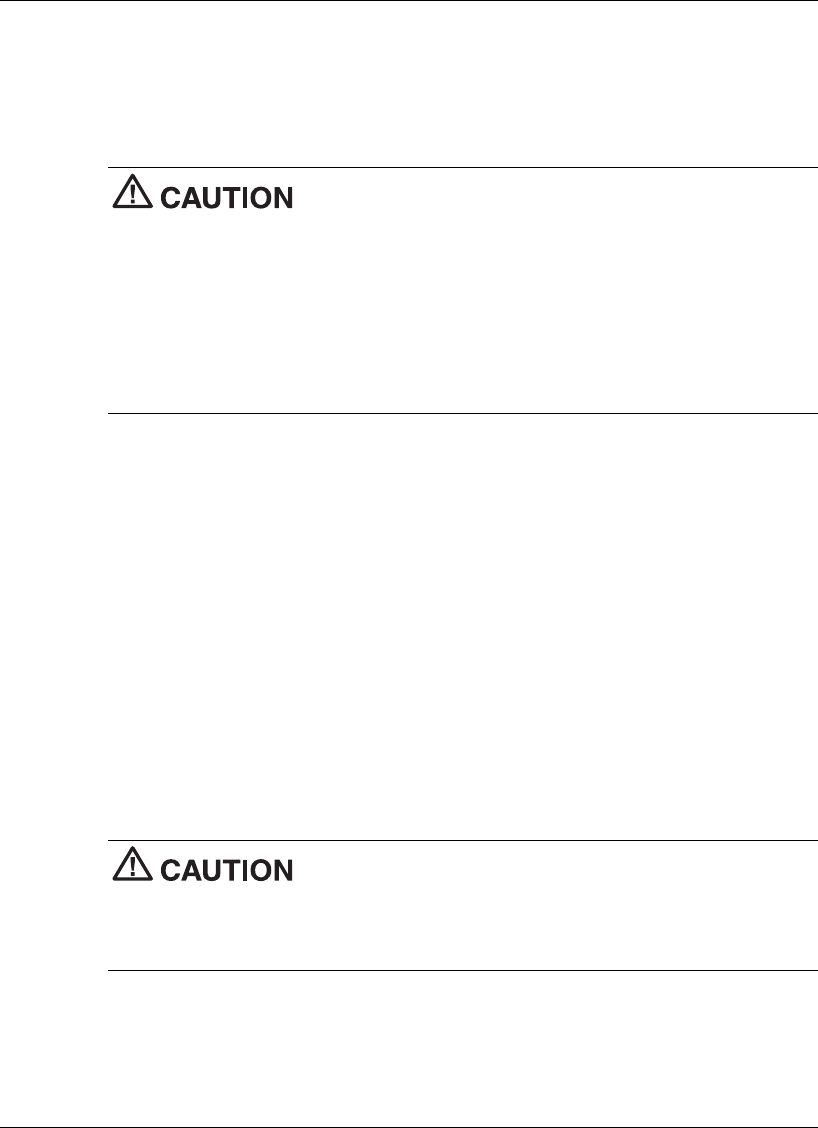
Using the Operating System and Utilities 4-19
Partition Only Restore
If your preinstalled software on drive C: of your multiple partitioned drive becomes
unusable and you cannot boot from the hard disk, use the Product Recovery utility to
restore your primary partition to its initial shipping configuration.
Use the Partition Only restore option only if your hard disk
drive consists of multiple partitions and if drive C: contains the operating system and
related drivers. Move all other data and applications to other partitions (drives) or the
Partition Only restore process will erase them completely.
The Partition Only restore option deletes all files on drive C: and replaces them with the
original factory installed files. Only use the Partition Only restore option if the
preinstalled software on drive C: is unusable.
For important information about partitioning your hard disk drive, see the section,
“PartitionMagic Special Edition,” earlier in this chapter.
Use the Product Recovery utility to perform a Partition Only restore as follows:
1. Check the Product Recovery CD title and make sure that it is the correct CD for
your NEC Versa computer and operating system.
2. Put the CD into the CD-ROM drive tray, close the drive door, and reboot your
computer.
3. Read the License Agreement screen that appears. Use the VersaGlide touchpad to
position the cursor on the Accept button. Left click to accept the agreement.
You have the option of accepting or declining the agreement. If you decline the
agreement, the recovery utility exits.
4. In the NEC Product Recovery utility screen, use the VersaGlide touchpad to
choose Partition Only to restore drive C: of a multiple partitioned drive to its
original factory installed state.
Choose your restore option carefully to prevent losing data and
applications installed on your system.
If the hard disk is configured with multiple or extended partitions you may have to
reinstall some software to restore configuration settings and shared files.
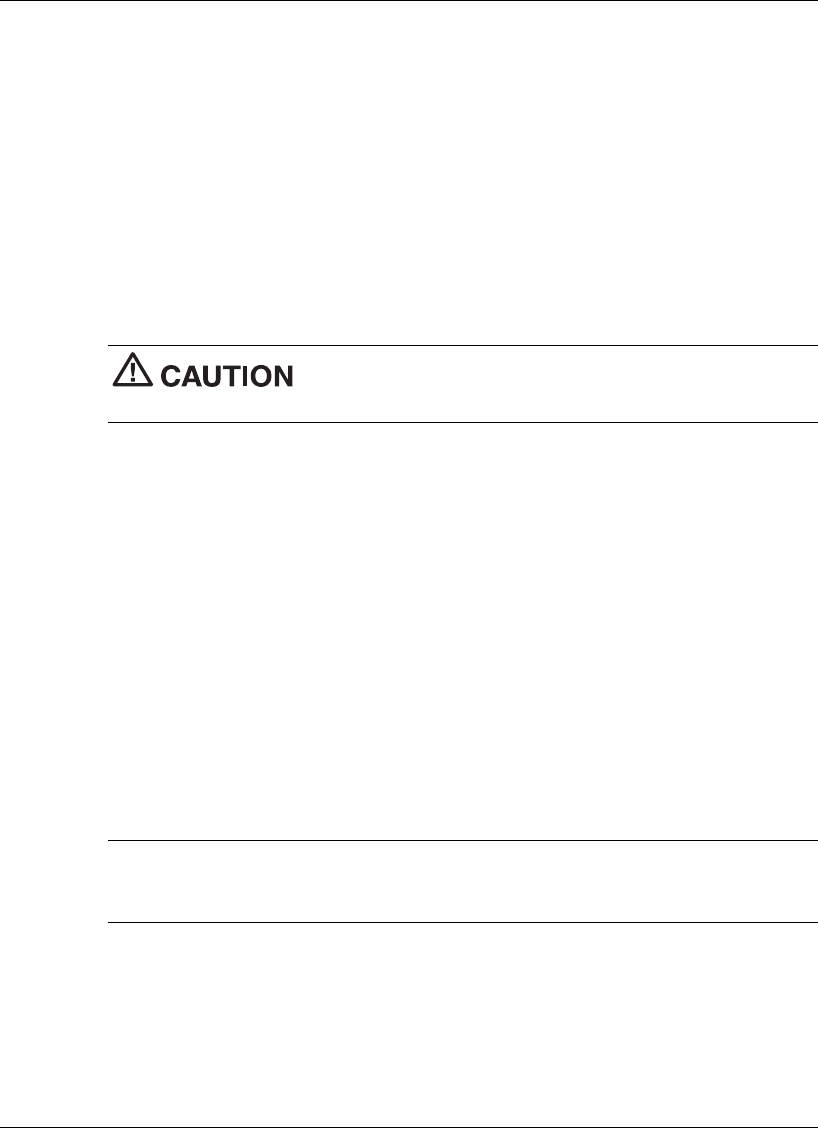
4-20 Using the Operating System and Utilities
5. Read the Warning screen.
A warning displays indicating that drive C: (the primary drive/partition) is about to
be erased and formatted. It may be necessary to reinstall software to the other
drives (partitions) to reestablish Start Menu links and other configuration
requirements stored on drive C:.
6. Select Continue to proceed, to perform a Partition Only restore.
If you select Back, the recovery utility returns to the prior screen, which has an exit
option.
If you select Continue, a screen with progress bars displays and lets you know the
progress of the recovery.
Do not turn off or disturb the system during the recovery
process.
7. When the recovery process is complete, you are prompted to remove the CD from
the CD-ROM drive and reboot your system.
8. Press Enter, click Reboot, or press Alt-R to reboot your system.
A series of hardware detection screens display, the system reboots, and the
Windows Setup screen appears. Follow the on-screen instructions to set up
Windows.
You are required to reenter your Microsoft license number.
One-Touch Start Button Settings Utility
The One-Touch Start Button Settings utility lets you configure shortcut buttons I and II
on the Versa L320 control panel to launch your default Internet browser and default
e-mail application.
Note You can use the One-Touch Start Button Settings utility to configure buttons
I and II to launch programs other than your Internet browser and e-mail application – for
example, a favorite program.
Use the following procedure to run the One-Touch Start Button Settings utility.
1. Install the One-Touch Start Button Settings utility from the Application and Driver
CD. See “Application and Driver CD” earlier in this chapter for information about
installing software from this CD.

Using the Operating System and Utilities 4-21
2. To run the utility, click Start, highlight Programs and One-Touch Start Button
Settings Utility. Click One-Touch Start button Settings Utility. The utility
launches.
3. For each button, browse and select the default program you wish to launch. You
can rename the program (for example, “My browser”).
Note The name of the program displays on your screen by default. Uncheck the box
for “Display on screen to display name on screen if you do not want to display the name.
4. Click OK. Select “Yes” to save the setup and exit the utility.

5
Using the System Drives and Bays
! NEC Modular Bay Slot
! NEC VersaBay IV Slot
! Phoenix BaySwap Utility
! Variable-Speed CD-ROM Drive
! Variable-Speed CD-RW Drive
! Variable-Speed DVD-ROM Drive
! Combination CD-RW and DVD-ROM Drive
! Memory Modules

5-2 Using the System Drives and Bays
NEC Modular Bay Slot
The NEC Modular Bay slot is located on the right side of the system. Your NEC Versa
notebook ships with a diskette drive installed in the bay.
The NEC Modular Bay slot lets you maximize your computer’s capabilities and is
designed for ease-of-use. It allows you to:
! Install an optional secondary battery in the slot instead of the diskette drive.
! Hot swap and warm swap the diskette drive or the secondary battery.
! Remove a Modular Bay device simply by sliding the Modular Bay device latch and
pulling the device out, without having to turn the system over.
! Install the weight-saver module that ships with the system. Using the module in the
Modular Bay slot, you lighten your NEC Versa notebook for travel, and protect the
bay when no device is installed.
For details about using hot and warm swapping, refer to the section, “Phoenix
BaySwap™ Utility,” later in this chapter, or access the Phoenix BaySwap utility online
help.
Read the instructions that come with your Modular Bay device for specific information
about installation and configuration. Contact your NEC Computers dealer to purchase a
battery.
NEC VersaBay IV Slot
The NEC VersaBay IV slot is located on the right side of the system. Your NEC Versa
notebook ships with one of these optical drives installed in the bay: CD-ROM, CD-
RW, DVD-ROM, or combination CD-RW and DVD-ROM. The VersaBay IV slot can
also house an optional hard disk drive that’s been placed in a specially designed cradle.
The NEC VersaBay IV slot lets you maximize your computer’s capabilities and is
designed for ease-of-use. It allows you to:
! Hot swap and warm swap storage devices.
! Change VersaBay IV devices without having to disassemble the system.
! Install the weight-saving module that ships with the system. Using the module in
the VersaBay IV slot, you lighten your NEC Versa notebook for travel, and protect
the bay when no device is installed.
For details about using hot and warm swapping, refer to the section, “Phoenix
BaySwap Utility,” later in this chapter, or access the Phoenix BaySwap utility online
help.

Using the System Drives and Bays 5-3
Read the instructions that come with your VersaBay IV device for specific information
about installation and configuration. Contact your NEC Computers dealer to purchase
additional VersaBay IV devices.
Phoenix BaySwap Utility
The NEC VersaBay IV slot supports hot swapping (switching devices while the system
is powered on) and warm swapping (switching devices while the system is in a sleep
state) for many bay devices, through the Phoenix BaySwap Utility. Using hot swapping
and warm swapping extends the power of plug and play technology to your NEC
VersaBay IV devices and NEC Modular Bay devices. This dynamic solution further
increases the flexibility of your already versatile notebook computer.
Installing the Phoenix BaySwap Utility
If the Phoenix BaySwap utility is not already installed, use the NEC Customize utility
to install it. For details about using the NEC Customize utility, see Chapter 4 “Using
the Operating System and Utilities.”
When the swap utility is installed on your system, a small icon appears in the lower
right-hand corner of the Windows taskbar. Moving your cursor over the icon displays
information about the device in the NEC VersaBay IV or NEC Modular Bay slot.
Using the Phoenix BaySwap Utility
With the Phoenix BaySwap utility running on your notebook computer, you can hot or
warm swap a CD-ROM, CD-RW, DVD-ROM, or combination CD-RW and
DVD-ROM drive in the NEC VersaBay IV slot. In addition, you can swap the diskette
drive or secondary battery in the NEC Modular Bay slot. Please note the following
when using the swap utility:
! Windows 98 SE Power Management must be enabled to use the swap utility.
! Windows 2000 supports hot swapping without use of the Phoenix BaySwap utility.
Swap devices in the NEC VersaBay IV slot or the NEC Modular Bay slot as follows:
1. If you have files open on the device you are planning to remove, close them.
2. Click on the swap utility taskbar icon to display the menu.
A box appears identifying the device (if any) in the NEC VersaBay IV slot or the
NEC Modular Bay slot that can be ejected.
3. Click the name of the device to prepare it for being ejected.
When the device can be safely removed, a message box appears.
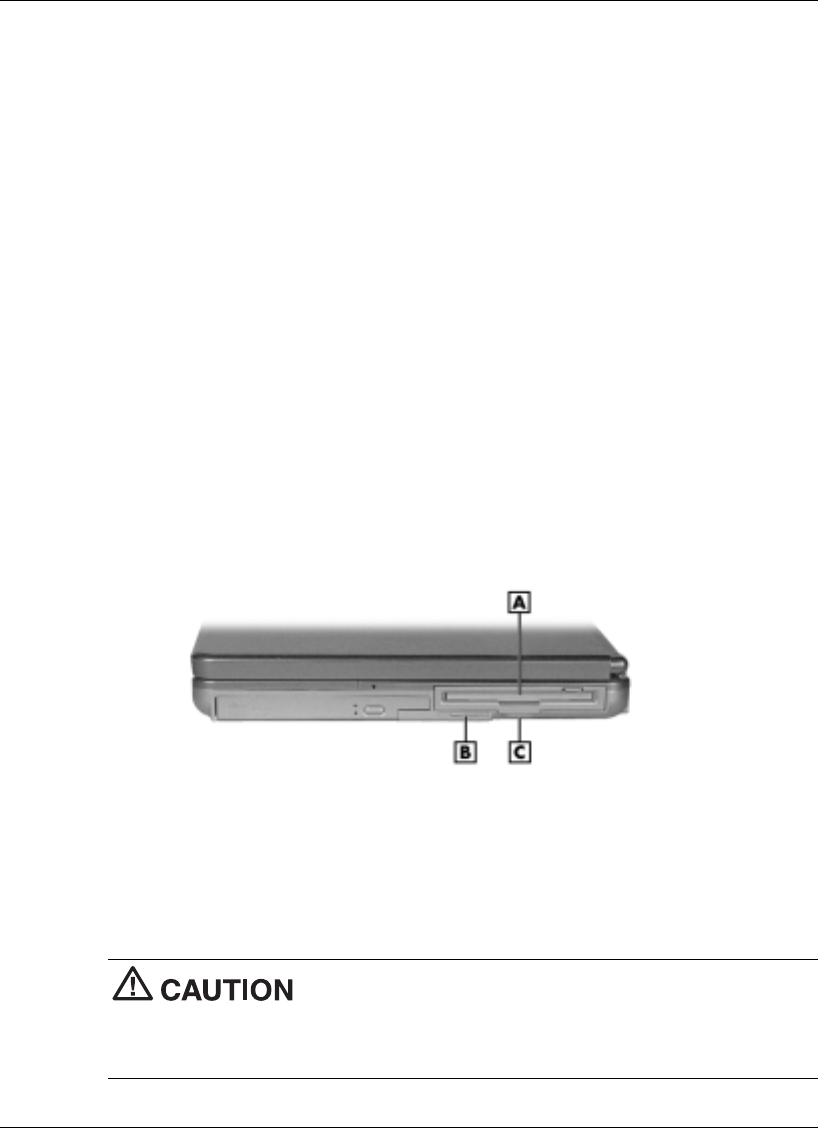
5-4 Using the System Drives and Bays
4. Remove the device (see the section, “Removing a Device from the NEC Modular
Bay Slot” or “Removing a Device from the NEC VersaBay IV Slot). Click OK
after the device is removed.
5. Insert a different device in the NEC VersaBay IV slot or the NEC Modular Bay
slot (see “Installing a Device in the NEC Modular Bay Slot” or “Installing a
Device in the NEC VersaBay IV Slot”).
References to the drive letter listed under My Computer and the Windows Explorer
change automatically when the device is swapped or removed. The balloon message
that appears when you move your cursor over the taskbar icon also changes to reflect
the new VersaBay IV or Modular Bay status.
Removing a Device from the NEC Modular Bay Slot
Use the following steps to remove a device from the NEC Modular Bay slot.
1. Use the Phoenix BaySwap utility or power off the system.
2. Locate the NEC Modular Bay release latch to the left of the Modular Bay slot.
Locating NEC Modular Bay features
A – NEC Modular Bay Device C – Pull tab
B – Modular Bay Release Latch
3. Slide the latch to the left and hold it. Grasp the pull tab on the device and remove
the device from the system.
Always install the weight-saving module that ships with your
system in the Modular Bay slot if no Modular Bay device is installed in the slot. See
“Installing a Device in the NEC Modular Bay Slot” for instructions on installing the
module.